Bacterial Efflux Pump Inhibitors
LaVoie; Edmond J. ; et al.
U.S. patent application number 16/616903 was filed with the patent office on 2020-06-25 for bacterial efflux pump inhibitors. This patent application is currently assigned to RUTGERS, THE STATE UNIVERSITY OF NEW JERSEY. The applicant listed for this patent is RUTGERS, THE STATE UNIVERSITY OF NEW JERSEY. Invention is credited to Edmond J. LaVoie, Ajit Parhi, Yangsheng Sun, Yi Yuan, Yongzheng Zhang.
| Application Number | 20200197382 16/616903 |
| Document ID | / |
| Family ID | 64395990 |
| Filed Date | 2020-06-25 |
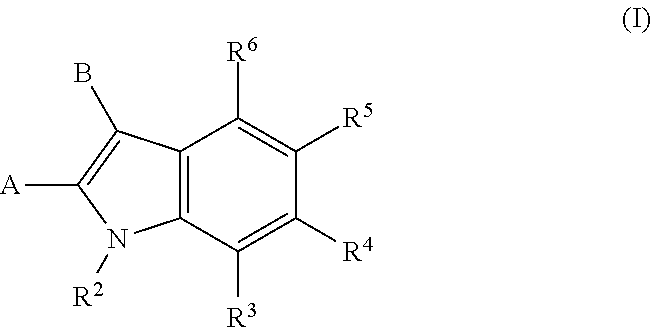
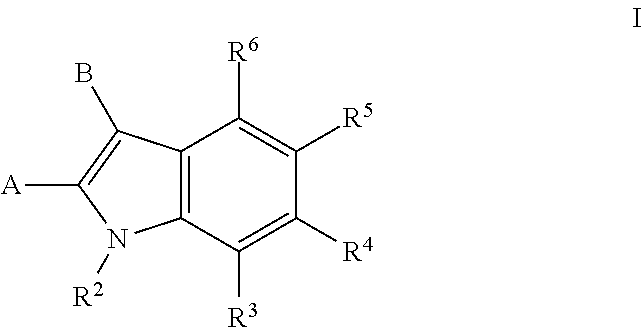
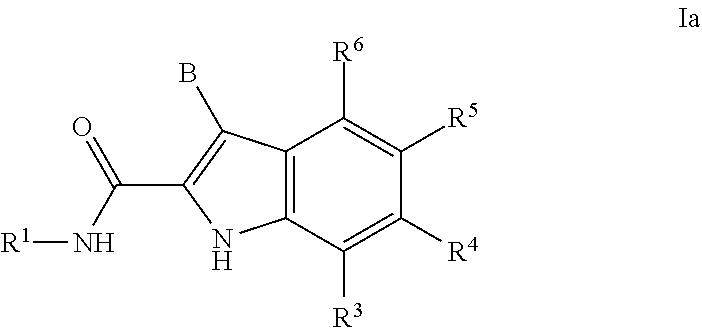
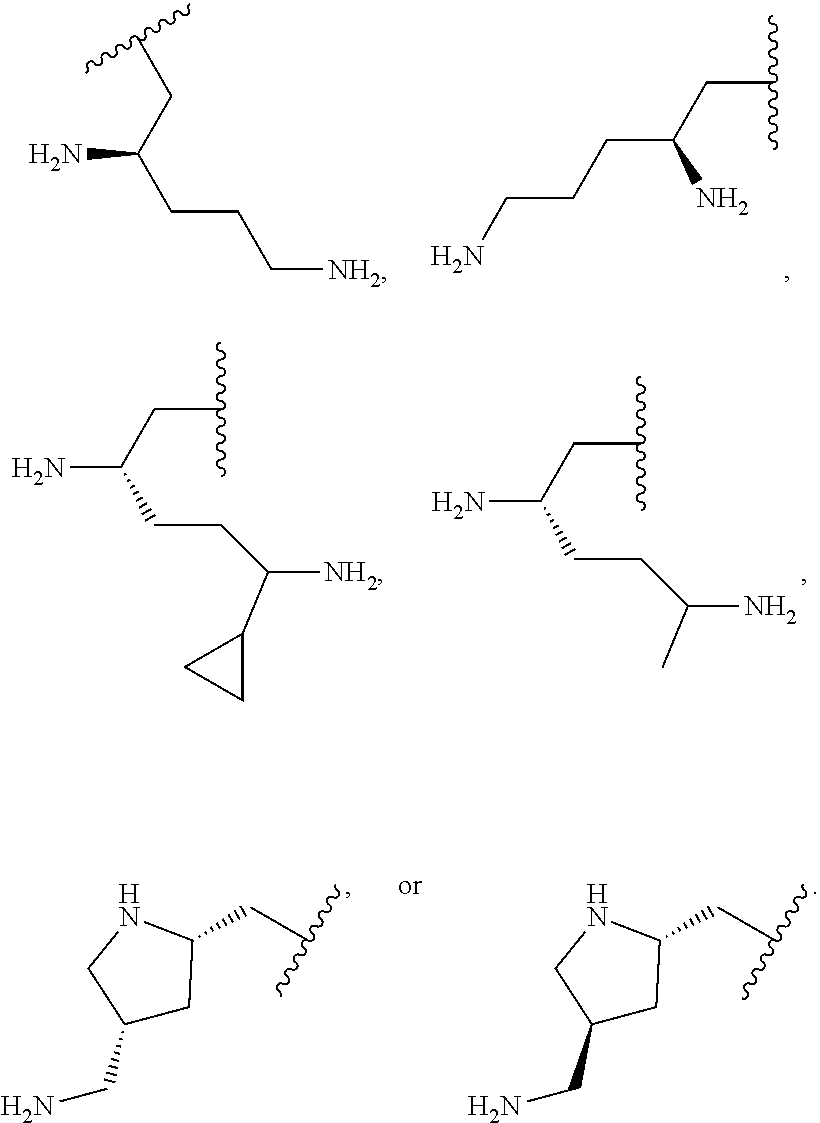
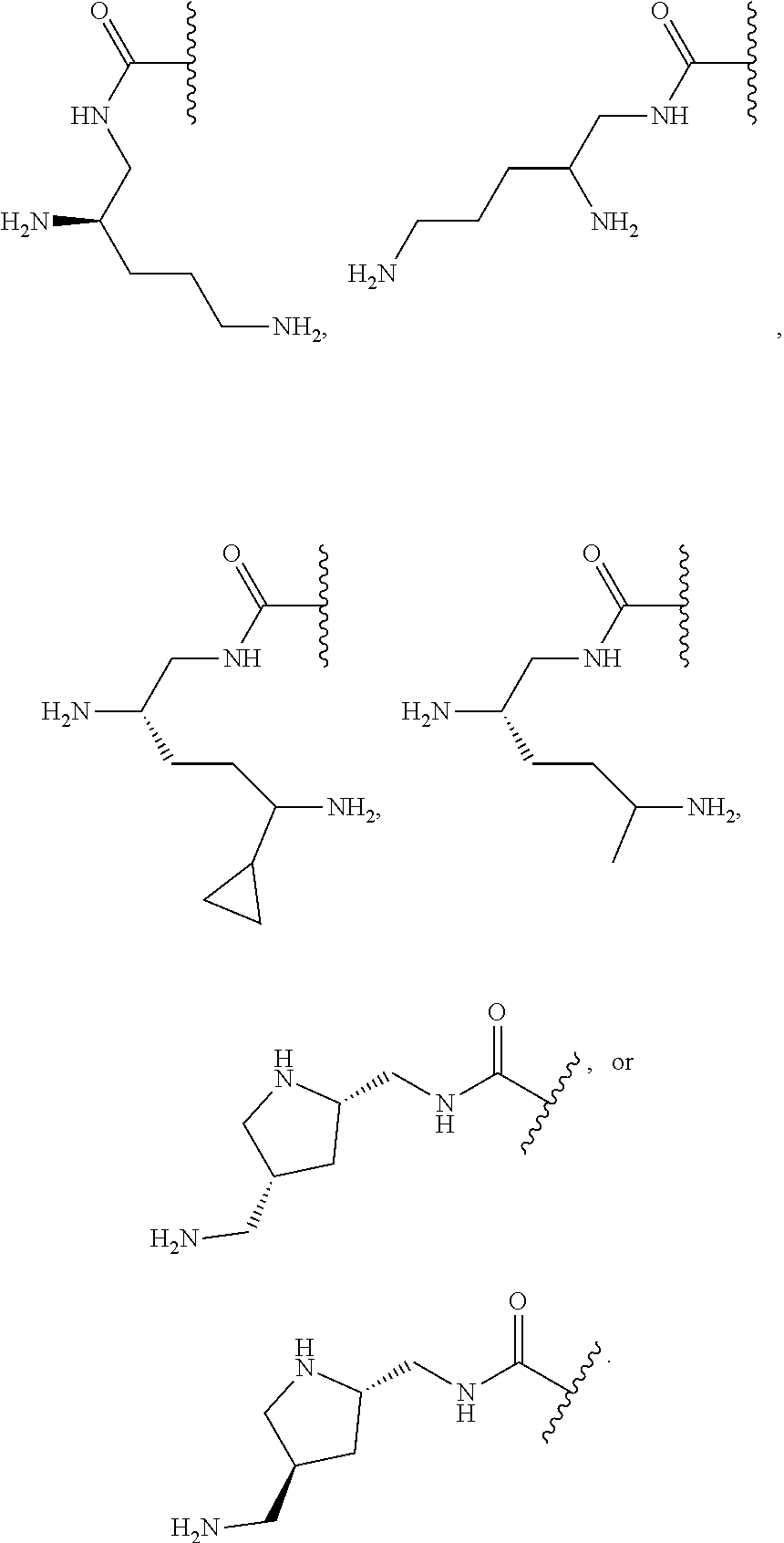
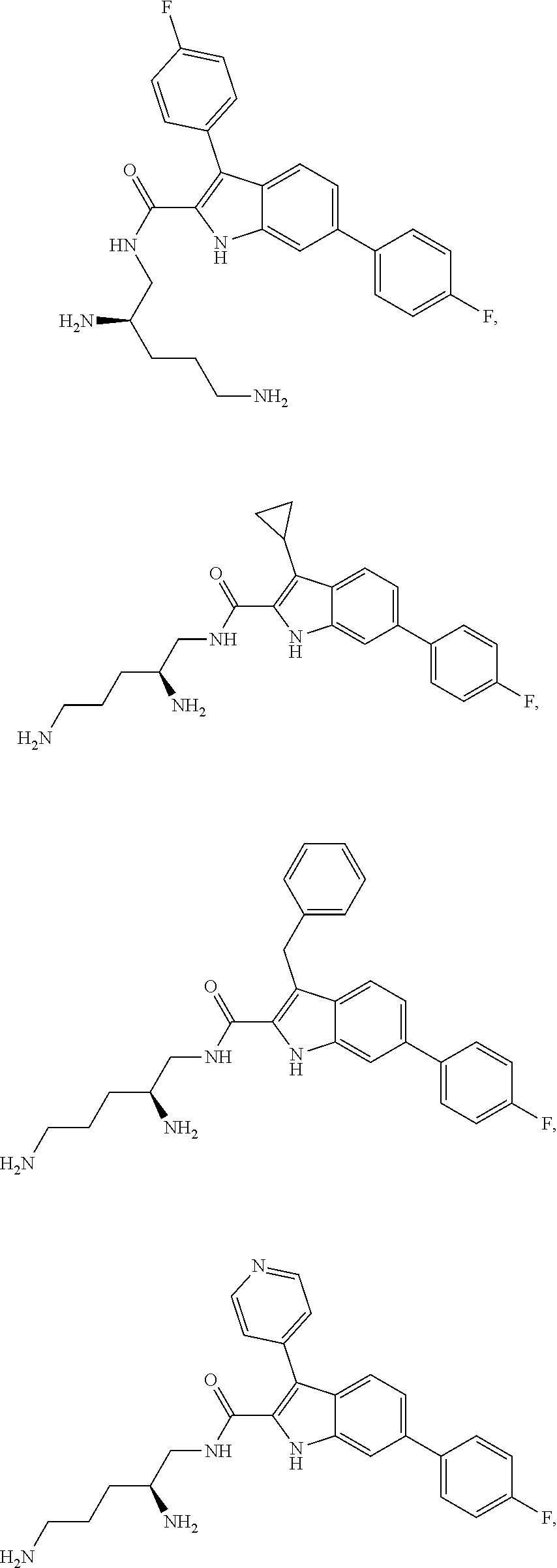






View All Diagrams
| United States Patent Application | 20200197382 |
| Kind Code | A1 |
| LaVoie; Edmond J. ; et al. | June 25, 2020 |
BACTERIAL EFFLUX PUMP INHIBITORS
Abstract
Disclosed herein are compounds of formula I and salts thereof. Also disclosed are compositions comprising compounds of formula I and methods using compounds of formula I. ##STR00001##
| Inventors: | LaVoie; Edmond J.; (New Brunswick, NJ) ; Parhi; Ajit; (New Brunswick, NJ) ; Yuan; Yi; (New Brunswick, NJ) ; Zhang; Yongzheng; (New Brunswick, NJ) ; Sun; Yangsheng; (New Brunswick, NJ) | ||||||||||
| Applicant: |
|
||||||||||
|---|---|---|---|---|---|---|---|---|---|---|---|
| Assignee: | RUTGERS, THE STATE UNIVERSITY OF
NEW JERSEY New Brunswick NJ |
||||||||||
| Family ID: | 64395990 | ||||||||||
| Appl. No.: | 16/616903 | ||||||||||
| Filed: | May 25, 2018 | ||||||||||
| PCT Filed: | May 25, 2018 | ||||||||||
| PCT NO: | PCT/US2018/034724 | ||||||||||
| 371 Date: | November 25, 2019 |
Related U.S. Patent Documents
| Application Number | Filing Date | Patent Number | ||
|---|---|---|---|---|
| 62511851 | May 26, 2017 | |||
| 62523156 | Jun 21, 2017 | |||
| Current U.S. Class: | 1/1 |
| Current CPC Class: | C07D 209/42 20130101; A61K 31/4045 20130101; A61K 31/4439 20130101; C07D 403/12 20130101; A61P 31/04 20180101; A61K 45/06 20130101; C07D 401/04 20130101; A61P 29/00 20180101 |
| International Class: | A61K 31/4439 20060101 A61K031/4439; A61K 45/06 20060101 A61K045/06; A61P 31/04 20060101 A61P031/04; A61K 31/4045 20060101 A61K031/4045; C07D 209/42 20060101 C07D209/42; C07D 401/04 20060101 C07D401/04; C07D 403/12 20060101 C07D403/12 |
Claims
1. A compound of formula I: ##STR00170## wherein: A is --C(.dbd.O)N(R.sup.a1)--R.sup.1, --(C.sub.1-C.sub.3)alkyl-C(.dbd.O)N(R.sup.a1)R.sup.1, --(C.sub.1-C.sub.3)alkyl-O--R.sup.1, --O--R.sup.1, --(C.sub.1-C.sub.3)alkyl-N(R.sup.a1)--R.sup.1, --N(R.sup.a1)--R.sup.1, or R.sup.1; B is (C.sub.2-C.sub.8)alkenyl, (C.sub.2-C.sub.8)alkynyl, (C.sub.1-C.sub.4)haloalkyl, (C.sub.1-C.sub.4)alkoxy, (C.sub.1-C.sub.4)haloalkoxy, (C.sub.3-C.sub.7)carbocyclyl, (C.sub.3-C.sub.7)carbocyclyl-(C.sub.1-C.sub.4)alkyl-, (C.sub.3-C.sub.7)carbocyclyl-(C.sub.2-C.sub.6)alkynyl-, aryl, aryl-(C.sub.1-C.sub.4)alkyl-, heteroaryl, heteroaryl-(C.sub.1-C.sub.4)alkyl-, 3-7 membered-monocyclic-heterocycle, or 3-7 membered-monocyclic-heterocycle-(C.sub.1-C.sub.4)alkyl- wherein any (C.sub.3-C.sub.7)carbocyclyl, (C.sub.3-C.sub.7)carbocyclyl-(C.sub.1-C.sub.4)alkyl-, (C.sub.3-C.sub.7)carbocyclyl-(C.sub.2-C.sub.6)alkynyl-, aryl, aryl-(C.sub.1-C.sub.4)alkyl-, heteroaryl, heteroaryl-(C.sub.1-C.sub.4)alkyl-, 3-7 membered-monocyclic-heterocycle, or 3-7 membered-monocyclic-heterocycle-(C.sub.1-C.sub.4)alkyl- of B is optionally substituted with one or more Z.sup.1 groups; each R.sup.1 is independently: (a) (C.sub.1-C.sub.14)alkyl substituted with one or more groups selected from the group consisting of --NR.sup.b2R.sup.c2, --NHNH.sub.2, --C(.dbd.NR.sup.a2)(NR.sup.b2R.sup.c2), --NR.sup.a2C(.dbd.NR.sup.a2)(R.sup.d2), and --NR.sup.a2C(.dbd.NR.sup.a2)(NR.sup.b2R.sup.c2) and wherein (C.sub.1-C.sub.14)alkyl is optionally substituted independently with one or more halo, (C.sub.1-C.sub.4)alkyl or (C.sub.3-C.sub.7)carbocyclyl; or (b) (C.sub.3-C.sub.7)carbocyclyl, (C.sub.3-C.sub.7)carbocyclyl-(C.sub.1-C.sub.4)alkyl-, 4-7 membered monocyclic heterocyclyl, or 4-7 membered monocyclic heterocyclyl-(C.sub.1-C.sub.4)alkyl-, wherein each (C.sub.3-C.sub.7)carbocyclyl or (C.sub.3-C.sub.7)carbocyclyl-(C.sub.1-C.sub.4)alkyl- is independently substituted with one or more Z.sup.2 or Z.sup.3, and wherein each 4-7 membered monocyclic heterocyclyl or 4-7 membered monocyclic heterocyclyl-(C.sub.1-C.sub.4)alkyl- is independently optionally substituted with one or more Z.sup.2 or Z.sup.3, and wherein any (C.sub.3-C.sub.7)carbocyclyl, (C.sub.3-C.sub.7)carbocyclyl-(C.sub.1-C.sub.4)alkyl-, 4-7 membered monocyclic heterocyclyl, or 4-7 membered monocyclic heterocyclyl-(C.sub.1-C.sub.4)alkyl- of R.sup.1 is optionally substituted independently with one or more halo, (C.sub.1-C.sub.4)alkyl or (C.sub.3-C.sub.7)carbocyclyl; R.sup.2 is hydrogen, (C.sub.1-C.sub.4)alkyl or phenyl(C.sub.1-C.sub.3)alkyl-, wherein the phenyl is optionally substituted with one or more (C.sub.1-C.sub.4)alkyl, --O(C.sub.1-C.sub.4)alkyl, halogen, or --NO.sub.2; R.sup.3 is hydrogen, halo, (C.sub.1-C.sub.4)alkyl, (C.sub.1-C.sub.4)haloalkyl, (C.sub.1-C.sub.4)alkoxy, (C.sub.1-C.sub.4)haloalkoxy, aryl, --OH, or heteroaryl wherein the aryl or heteroaryl is optionally substituted with one or more groups independently selected from the group consisting of halo, --OH, --NO.sub.2, --CN, (C.sub.1-C.sub.4)alkyl, (C.sub.1-C.sub.4)haloalkyl, (C.sub.1-C.sub.4)alkoxy, and (C.sub.1-C.sub.4)haloalkoxy; R.sup.4 is hydrogen, halo, (C.sub.1-C.sub.4)alkyl, (C.sub.1-C.sub.4)haloalkyl, (C.sub.1-C.sub.4)alkoxy, (C.sub.1-C.sub.4)haloalkoxy, aryl, --OH, or heteroaryl wherein the aryl or heteroaryl is optionally substituted with one or more groups independently selected from the group consisting of halo, --OH, --NO.sub.2, --CN, (C.sub.1-C.sub.4)alkyl, (C.sub.1-C.sub.4)haloalkyl, (C.sub.1-C.sub.4)alkoxy, and (C.sub.1-C.sub.4)haloalkoxy; R.sup.5 is hydrogen, halo, (C.sub.1-C.sub.4)alkyl, (C.sub.1-C.sub.4)haloalkyl, (C.sub.1-C.sub.4)alkoxy, (C.sub.1-C.sub.4)haloalkoxy, aryl, --OH, or heteroaryl wherein the aryl or heteroaryl is optionally substituted with one or more groups independently selected from the group consisting of halo, --OH, --NO.sub.2, --CN, (C.sub.1-C.sub.4)alkyl, (C.sub.1-C.sub.4)haloalkyl, (C.sub.1-C.sub.4)alkoxy, and (C.sub.1-C.sub.4)haloalkoxy; R.sup.6 is hydrogen, halo, (C.sub.1-C.sub.4)alkyl, (C.sub.1-C.sub.4)haloalkyl, (C.sub.1-C.sub.4)alkoxy, (C.sub.1-C.sub.4)haloalkoxy, aryl, --OH, or heteroaryl wherein the aryl or heteroaryl is optionally substituted with one or more groups independently selected from the group consisting of halo, --OH, --NO.sub.2, --CN, (C.sub.1-C.sub.4)alkyl, (C.sub.1-C.sub.4)haloalkyl, (C.sub.1-C.sub.4)alkoxy, and (C.sub.1-C.sub.4)haloalkoxy; each Z.sup.1 is independently halo, --OH, --NO.sub.2, --CN, (C.sub.1-C.sub.4)alkyl, (C.sub.1-C.sub.4)haloalkyl, (C.sub.1-C.sub.4)alkoxy, --CO.sub.2H, benzyloxy, or (C.sub.1-C.sub.4)haloalkoxy; each Z.sup.2 is independently selected from the group consisting of NR.sup.b3R.sup.c3, --NHNH.sub.2, --C(.dbd.NR.sup.a3)(NR.sup.b3R.sup.c3), --NR.sup.a3C(.dbd.NR.sup.a3)(R.sup.d3), and --NR.sup.a3C(.dbd.NR.sup.a3)(NR.sup.b3R.sup.c3) each Z.sup.3 is independently --(C.sub.1-C.sub.6)alkyl substituted with one or more Z.sup.2 and optionally optionally substituted with one or more Z.sup.4; each Z.sup.4 is independently halo or (C.sub.3-C.sub.7)carbocyclyl; each R.sup.a1 is independently hydrogen, (C.sub.1-C.sub.4)alkyl or (C.sub.3-C.sub.7)carbocyclyl; each R.sup.a2 is independently hydrogen, (C.sub.1-C.sub.4)alkyl or (C.sub.3-C.sub.7)carbocyclyl; each R.sup.b2 and R.sup.c2 is independently hydrogen, (C.sub.1-C.sub.4)alkyl or (C.sub.3-C.sub.7)carbocyclyl; R.sup.d2 is (C.sub.1-C.sub.4)alkyl or (C.sub.3-C.sub.7)carbocyclyl; each R.sup.a3 is independently hydrogen (C.sub.1-C.sub.4)alkyl or (C.sub.3-C.sub.7)carbocyclyl; each R.sup.b3 and R.sup.3 is independently hydrogen (C.sub.1-C.sub.4)alkyl or (C.sub.3-C.sub.7)carbocyclyl; and R.sup.d3 is (C.sub.1-C.sub.4)alkyl or (C.sub.3-C.sub.7)carbocyclyl; or a salt thereof.
2. The compound of claim 1 wherein: A is --C(.dbd.O)N(R.sup.a1)--R.sup.1, --(C.sub.1-C.sub.3)alkyl-C(.dbd.O)N(R.sup.a1)R.sup.1, --(C.sub.1-C.sub.3)alkyl-O--R.sup.1, --O--R.sup.1, --(C.sub.1-C.sub.3)alkyl-N(R.sup.a1)--R, --N(R.sup.a1)--R.sup.1, or R.sup.1; B is (C.sub.2-C.sub.8)alkenyl, (C.sub.2-C.sub.8)alkynyl, (C.sub.1-C.sub.4)haloalkyl, (C.sub.1-C.sub.4)alkoxy, (C.sub.1-C.sub.4)haloalkoxy, (C.sub.3-C.sub.7)carbocyclyl, (C.sub.3-C.sub.7)carbocyclyl-(C.sub.1-C.sub.4)alkyl-, aryl, aryl-(C.sub.1-C.sub.4)alkyl-, heteroaryl, heteroaryl-(C.sub.1-C.sub.4)alkyl-, 3-7 membered-monocyclic-heterocycle, or 3-7 membered-monocyclic-heterocycle-(C.sub.1-C.sub.4)alkyl- wherein any (C.sub.3-C.sub.7)carbocyclyl, (C.sub.3-C.sub.7)carbocyclyl-(C.sub.1-C.sub.4)alkyl-, aryl, aryl-(C.sub.1-C.sub.4)alkyl-, heteroaryl, heteroaryl-(C.sub.1-C.sub.4)alkyl-, 3-7 membered-monocyclic-heterocycle, or 3-7 membered-monocyclic-heterocycle-(C.sub.1-C.sub.4)alkyl- of B is optionally substituted with one or more Z.sup.1 groups; each R.sup.1 is independently: (a) (C.sub.1-C.sub.14)alkyl substituted with one or more groups selected from the group consisting of --NR.sup.b2R.sup.c2, --NHNH.sub.2, --C(.dbd.NR.sup.a2)(NR.sup.b2R.sup.c2), --NR.sup.a2C(.dbd.NR.sup.a2)(R.sup.d2), and --NR.sup.a2C(.dbd.NR.sup.a2)(NR.sup.b2R.sup.c2) and wherein (C.sub.1-C.sub.14)alkyl is optionally substituted independently with one or more (C.sub.1-C.sub.4)alkyl or (C.sub.3-C.sub.7)carbocyclyl; or (b) (C.sub.3-C.sub.7)carbocyclyl, (C.sub.3-C.sub.7)carbocyclyl-(C.sub.1-C.sub.4)alkyl-, 4-7 membered monocyclic heterocyclyl, or 4-7 membered monocyclic heterocyclyl-(C.sub.1-C.sub.4)alkyl-, wherein each (C.sub.3-C.sub.7)carbocyclyl or (C.sub.3-C.sub.7)carbocyclyl-(C.sub.1-C.sub.4)alkyl- is independently substituted with one or more groups selected from the group consisting of Z and --(C.sub.1-C.sub.6)alkyl substituted with one or more Z, and wherein each 4-7 membered monocyclic heterocyclyl or 4-7 membered monocyclic heterocyclyl-(C.sub.1-C.sub.4)alkyl- is independently optionally substituted with one or more groups selected from the group consisting of Z and --(C.sub.1-C.sub.6)alkyl substituted with one or more Z, wherein each Z is independently selected from the group consisting of --NR.sup.b3R.sup.c3, --NHNH.sub.2, --C(.dbd.NR.sup.a3)(NR.sup.b3R.sup.c3), --NR.sup.a3C(.dbd.NR.sup.a3)(R.sup.d3), and --NR.sup.a3C(.dbd.NR.sup.a3)(NR.sup.b3R.sup.c3) and wherein each (C.sub.3-C.sub.7)carbocyclyl, (C.sub.3-C.sub.7)carbocyclyl-(C.sub.1-C.sub.4)alkyl-, 4-7 membered monocyclic heterocyclyl, or 4-7 membered monocyclic heterocyclyl-(C.sub.1-C.sub.4)alkyl-, is optionally substituted independently with one or more (C.sub.1-C.sub.4)alkyl; R.sup.2 is hydrogen, (C.sub.1-C.sub.4)alkyl or phenyl(C.sub.1-C.sub.3)alkyl-, wherein the phenyl is optionally substituted with one or more (C.sub.1-C.sub.4)alkyl, --O(C.sub.1-C.sub.4)alkyl, halogen, or --NO.sub.2; R.sup.3 is hydrogen, halo, (C.sub.1-C.sub.4)alkyl, (C.sub.1-C.sub.4)haloalkyl, (C.sub.1-C.sub.4)alkoxy, (C.sub.1-C.sub.4)haloalkoxy, aryl, or heteroaryl wherein the aryl or heteroaryl is optionally substituted with one or more groups independently selected from the group consisting of halo, --OH, --NO.sub.2, --CN, (C.sub.1-C.sub.4)alkyl, (C.sub.1-C.sub.4)haloalkyl, (C.sub.1-C.sub.4)alkoxy, and (C.sub.1-C.sub.4)haloalkoxy; R.sup.4 is hydrogen, halo, (C.sub.1-C.sub.4)alkyl, (C.sub.1-C.sub.4)haloalkyl, (C.sub.1-C.sub.4)alkoxy, (C.sub.1-C.sub.4)haloalkoxy, aryl, or heteroaryl wherein the aryl or heteroaryl is optionally substituted with one or more groups independently selected from the group consisting of halo, --OH, --NO.sub.2, --CN, (C.sub.1-C.sub.4)alkyl, (C.sub.1-C.sub.4)haloalkyl, (C.sub.1-C.sub.4)alkoxy, and (C.sub.1-C.sub.4)haloalkoxy; R.sup.5 is hydrogen, halo, (C.sub.1-C.sub.4)alkyl, (C.sub.1-C.sub.4)haloalkyl, (C.sub.1-C.sub.4)alkoxy, (C.sub.1-C.sub.4)haloalkoxy, aryl, or heteroaryl wherein the aryl or heteroaryl is optionally substituted with one or more groups independently selected from the group consisting of halo, --OH, --NO.sub.2, --CN, (C.sub.1-C.sub.4)alkyl, (C.sub.1-C.sub.4)haloalkyl, (C.sub.1-C.sub.4)alkoxy, and (C.sub.1-C.sub.4)haloalkoxy; R.sup.6 is hydrogen, halo, (C.sub.1-C.sub.4)alkyl, (C.sub.1-C.sub.4)haloalkyl, (C.sub.1-C.sub.4)alkoxy, (C.sub.1-C.sub.4)haloalkoxy, aryl, or heteroaryl wherein the aryl or heteroaryl is optionally substituted with one or more groups independently selected from the group consisting of halo, --OH, --NO.sub.2, --CN, (C.sub.1-C.sub.4)alkyl, (C.sub.1-C.sub.4)haloalkyl, (C.sub.1-C.sub.4)alkoxy, and (C.sub.1-C.sub.4)haloalkoxy; each Z.sup.1 is independently halo, --OH, --NO.sub.2, --CN, (C.sub.1-C.sub.4)alkyl, (C.sub.1-C.sub.4)haloalkyl, (C.sub.1-C.sub.4)alkoxy, or (C.sub.1-C.sub.4)haloalkoxy; each R.sup.a1 is independently hydrogen, (C.sub.1-C.sub.4)alkyl or (C.sub.3-C.sub.7)carbocyclyl; each R.sup.a2 is independently hydrogen, (C.sub.1-C.sub.4)alkyl or (C.sub.3-C.sub.7)carbocyclyl; each R.sup.b2 and R.sup.c2 is independently hydrogen, (C.sub.1-C.sub.4)alkyl or (C.sub.3-C.sub.7)carbocyclyl; R.sup.d2 is (C.sub.1-C.sub.4)alkyl or (C.sub.3-C.sub.7)carbocyclyl; each R.sup.a3 is independently hydrogen (C.sub.1-C.sub.4)alkyl or (C.sub.3-C.sub.7)carbocyclyl; each R.sup.b3 and R.sup.3 is independently hydrogen (C.sub.1-C.sub.4)alkyl or (C.sub.3-C.sub.7)carbocyclyl; and R.sup.d3 is (C.sub.1-C.sub.4)alkyl or (C.sub.3-C.sub.7)carbocyclyl; or a salt thereof.
3. The compound or salt thereof of claim 1 or 2, wherein A is --C(.dbd.O)N(R.sup.a1)--R.sup.1.
4. The compound or salt thereof of any one of claims 1-3, wherein R.sup.a1 is hydrogen.
5. The compound or salt of any one of claims 1-4, wherein R.sup.2 is hydrogen or (C.sub.1-C.sub.6)alkyl.
6. The compound or salt of any one of claims 1-4, wherein R.sup.2 is hydrogen.
7. The compound or salt of claim 1 or 2 that is a compound of formula Ia: ##STR00171## or a salt thereof.
8. The compound or salt of any one of claims 1-7, wherein R.sup.3 is hydrogen, halo, (C.sub.1-C.sub.4)alkyl, (C.sub.1-C.sub.4)haloalkyl, (C.sub.1-C.sub.4)alkoxy, --OH, or (C.sub.1-C.sub.4)haloalkoxy.
9. The compound or salt of any one of claims 1-7, wherein R.sup.3 is hydrogen, OH or methoxy.
10. The compound or salt of any one of claims 1-9, wherein R.sup.4 is hydrogen, aryl, or heteroaryl wherein the aryl or heteroaryl is optionally substituted with one or more groups independently selected from the group consisting of halo, --OH, --NO.sub.2, --CN, (C.sub.1-C.sub.4)alkyl, (C.sub.1-C.sub.4)haloalkyl, (C.sub.1-C.sub.4)alkoxy, and (C.sub.1-C.sub.4)haloalkoxy.
11. The compound or salt of any one of claims 1-9, wherein R.sup.4 is hydrogen or phenyl wherein the phenyl is optionally substituted with one or more groups independently selected from the group consisting of halo, --OH, --NO.sub.2, --CN, (C.sub.1-C.sub.4)alkyl, (C.sub.1-C.sub.4)haloalkyl, (C.sub.1-C.sub.4)alkoxy, and (C.sub.1-C.sub.4)haloalkoxy.
12. The compound or salt of any one of claims 1-9, wherein R.sup.4 is hydrogen or phenyl wherein the phenyl is optionally substituted with one or more halo.
13. The compound or salt of any one of claims 1-9, wherein R.sup.4 is 4-fluorophenyl or hydrogen.
14. The compound or salt of any one of claims 1-13, wherein R.sup.5 is hydrogen, halo, (C.sub.1-C.sub.4)alkyl, (C.sub.1-C.sub.4)haloalkyl, (C.sub.1-C.sub.4)alkoxy, (C.sub.1-C.sub.4)haloalkoxy, or phenyl wherein the phenyl is optionally substituted with one or more groups independently selected from the group consisting of halo, --OH, --NO.sub.2, --CN, (C.sub.1-C.sub.4)alkyl, (C.sub.1-C.sub.4)haloalkyl, (C.sub.1-C.sub.4)alkoxy, and (C.sub.1-C.sub.4)haloalkoxy.
15. The compound or salt of any one of claims 1-13, wherein R.sup.5 is hydrogen, 4-fluorophenyl, phenyl, or 3,5-dimethylphenyl.
16. The compound or salt of any one of claims 1-15, wherein R.sup.6 is hydrogen, halo, (C.sub.1-C.sub.4)alkyl, (C.sub.1-C.sub.4)haloalkyl, (C.sub.1-C.sub.4)alkoxy, or (C.sub.1-C.sub.4)haloalkoxy.
17. The compound or salt of any one of claims 1-15, wherein R.sup.6 is hydrogen.
18. The compound or salt of any one of claims 1-17, wherein B is (C.sub.3-C.sub.7)carbocyclyl, (C.sub.3-C.sub.7)carbocyclyl-(C.sub.1-C.sub.4)alkyl-, (C.sub.3-C.sub.7)carbocyclyl-(C.sub.2-C.sub.6)alkynyl, aryl, aryl-(C.sub.1-C.sub.4)alkyl-, heteroaryl, or heteroaryl-(C.sub.1-C.sub.4)alkyl-, wherein any (C.sub.3-C.sub.7)carbocyclyl, (C.sub.3-C.sub.7)carbocyclyl-(C.sub.1-C.sub.4)alkyl-, (C.sub.3-C.sub.7)carbocyclyl-(C.sub.2-C.sub.6)alkynyl, aryl, aryl-(C.sub.1-C.sub.4)alkyl-, heteroaryl, or heteroaryl-(C.sub.1-C.sub.4)alkyl- of B is optionally substituted with one or more Z.sup.1 groups.
19. The compound or salt of any one of claims 1-17, wherein B is (C.sub.3-C.sub.7)carbocyclyl, (C.sub.3-C.sub.7)carbocyclyl-(C.sub.1-C.sub.4)alkyl-, (C.sub.3-C.sub.7)carbocyclyl-(C.sub.2-C.sub.4)alkynyl, aryl, aryl-(C.sub.1-C.sub.4)alkyl-, or heteroaryl wherein any (C.sub.3-C.sub.7)carbocyclyl, aryl, aryl-(C.sub.1-C.sub.4)alkyl-, or heteroaryl, of B is optionally substituted with one or more Z.sup.1 groups.
20. The compound or salt of any one of claims 1-17, wherein B is (C.sub.3-C.sub.7)carbocyclyl, (C.sub.3-C.sub.7)carbocyclyl-(C.sub.1-C.sub.4)alkyl-, (C.sub.3-C.sub.7)carbocyclyl-(C.sub.2-C.sub.6)alkynyl, phenyl, phenyl-(C.sub.1-C.sub.4)alkyl-, or 5-6 membered heteroaryl wherein any (C.sub.3-C.sub.7)carbocyclyl, (C.sub.3-C.sub.7)carbocyclyl-(C.sub.1-C.sub.4)alkyl-, (C.sub.3-C.sub.7)carbocyclyl-(C.sub.2-C.sub.6)alkynyl, phenyl, phenyl-(C.sub.1-C.sub.4)alkyl-, or 5-6 membered heteroaryl of B is optionally substituted with one or more Z.sup.1 groups.
21. The compound or salt of any one of claims 1-17, wherein B is (C.sub.3-C.sub.7)carbocyclyl, phenyl, phenyl-(C.sub.1-C.sub.4)alkyl-, or 5-6 membered heteroaryl wherein any (C.sub.3-C.sub.7)carbocyclyl, phenyl, phenyl-(C.sub.1-C.sub.4)alkyl-, or 5-6 membered heteroaryl of B is optionally substituted with one or more Z.sup.1 groups.
22. The compound or salt of any one of claims 1-17, wherein B is (C.sub.3-C.sub.7)carbocyclyl, phenyl, phenyl-(C.sub.1-C.sub.4)alkyl-, (C.sub.3-C.sub.7)carbocyclylethynyl, (C.sub.3-C.sub.7)carbocyclylethyl, or 6 membered heteroaryl wherein any (C.sub.3-C.sub.7)carbocyclyl, phenyl, phenyl-(C.sub.1-C.sub.4)alkyl-, C.sub.3-C.sub.7)carbocyclylethynyl, (C.sub.3-C.sub.7)carbocyclylethyl, or 6 membered heteroaryl of B is optionally substituted with one or more Z.sup.1 groups.
23. The compound or salt of any one of claims 1-17, wherein B is (C.sub.3-C.sub.7)carbocyclyl, phenyl, phenyl-(CH.sub.2)--, (C.sub.3-C.sub.7)carbocyclylethynyl, (C.sub.3-C.sub.7)carbocyclylethyl or pyridinyl wherein any phenyl, phenyl-(CH.sub.2)--, C.sub.3-C.sub.7)carbocyclylethynyl, (C.sub.3-C.sub.7)carbocyclylethyl or pyridinyl of B is optionally substituted with one or more Z.sup.1 groups.
24. The compound or salt of any one of claims 1-23, wherein each Z.sup.1 is independently halo, --OH, --CO.sub.2H, benzyloxy, or (C.sub.1-C.sub.4)haloalkyl.
25. The compound or salt of any one of claims 1-17, wherein B is 4-fluorophenyl, cyclopropyl, benzyl, pyrdin-4-yl, 4-hydroxyphenyl, 4-trifluoromethylphenyl, 4-carboxyphenyl, 3-benzyloxyphenyl, 3-hydroxyphenyl, phenyl, 3,5-dimethylphenyl, 2-cylopropylethynyl, 2- or cyclpropylethyl.
26. The compound or salt of any one of claims 1-25, wherein R.sup.1 is (C.sub.1-C.sub.14)alkyl substituted with one or more groups independently selected from --NR.sup.b2R.sup.c2 and wherein the (C.sub.1-C.sub.14)alkyl is optionally substituted with one or more (C.sub.3-C.sub.7)carbocyclyl.
27. The compound or salt of any one of claims 1-25, wherein R.sup.1 is (C.sub.2-C.sub.10)alkyl substituted with one or more groups independently selected from --NR.sup.b2R.sup.c2 and wherein the (C.sub.2-C.sub.10)alkyl is optionally substituted with one or more (C.sub.3-C.sub.7)carbocyclyl.
28. The compound or salt of any one of claims 1-25, wherein R.sup.1 is (C.sub.4-C.sub.8)alkyl substituted with two or more groups independently selected from --NR.sup.b2R.sup.c2.
29. The compound or salt of any one of claims 1-26, wherein R.sup.b2 and R.sup.c2 are each hydrogen.
30. The compound or salt of any one of claims 1-25, wherein R.sup.1 is a 4-7 membered monocyclic heterocyclyl-(C.sub.1-C.sub.4)alkyl-, wherein the 4-7 membered monocyclic heterocyclyl-(C.sub.1-C.sub.4)alkyl- is substituted with one or more groups independently selected from the group consisting of Z.sup.2 and --(C.sub.1-C.sub.6)alkyl substituted with one or more Z.sup.2, wherein each Z.sup.2 is independently selected from the group consisting of --NR.sup.b3R.sup.c3, --NHNH.sub.2, --C(.dbd.NR.sup.a3)(NR.sup.b3R.sup.c3), --NR.sup.a3C(.dbd.NR.sup.a3)(R.sup.d3), and --NR.sup.a3C(.dbd.NR.sup.a3)(NR.sup.b3R.sup.c3) and wherein the 4-7 membered monocyclic heterocyclyl-(C.sub.1-C.sub.4)alkyl- is optionally substituted with one or more (C.sub.1-C.sub.6)alkyl.
31. The compound or salt of any one of claims 1-25, wherein R.sup.1 is a 4-7 membered monocyclic heterocyclyl-(C.sub.1-C.sub.4)alkyl-, wherein the 4-7 membered monocyclic heterocyclyl-(C.sub.1-C.sub.4)alkyl- is substituted with one or more groups independently selected from the group consisting of Z.sup.2 and (C.sub.1-C.sub.6)alkyl substituted with one or more Z.sup.2, wherein each Z.sup.2 is independently --NR.sup.b3R.sup.c3 and wherein the 4-7 membered monocyclic heterocyclyl-(C.sub.1-C.sub.4)alkyl- is optionally substituted with one or more (C.sub.1-C.sub.6)alkyl.
32. The compound or salt of any one of claims 1-25, wherein R.sup.1 is pyrrolidinyl-(C.sub.1-C.sub.4)alkyl-, wherein the pyrrolidinyl-(C.sub.1-C.sub.4)alkyl- is substituted with one or more groups independently selected from the group consisting of Z.sup.2 and --(C.sub.1-C.sub.6)alkyl substituted with one or more Z.sup.2, wherein each Z.sup.2 is independently --NR.sup.b3R.sup.c3 and wherein is pyrrolidinyl-(C.sub.1-C.sub.4)alkyl- is optionally substituted independently with one or more (C.sub.1-C.sub.6)alkyl.
33. The compound or salt of any one of claims 1-25, wherein R.sup.1 is pyrrolidinyl-(CH.sub.2)--, wherein the pyrrolidinyl-(CH.sub.2)-- is substituted with one or more groups independently selected from the group consisting of Z.sup.2 and --(C.sub.1-C.sub.6)alkyl substituted with one or more Z.sup.2, wherein each Z.sup.2 is independently --NR.sup.b3R.sup.c3 and wherein the pyrrolidinyl-(CH.sub.2)-- is optionally substituted independently with one or more (C.sub.1-C.sub.6)alkyl.
34. The compound or salt of any one of claims 1-25, wherein R.sup.1 is pyrrolidinyl-(CH.sub.2)--, wherein the pyrrolidinyl-(CH.sub.2)-- is substituted on the pyrrolidinyl with --(C.sub.1-C.sub.6)alkyl substituted with one or more --NR.sup.b3R.sup.c3.
35. The compound or salt of any one of claims 1-25 or 30-34, wherein R.sup.b3 and R.sup.3 are each hydrogen.
36. The compound or salt of any one of claims 1-35, wherein R.sup.1 is: ##STR00172##
37. The compound or salt of any one of claims 1-35, wherein A is: ##STR00173##
38. The compound or salt of claim 1 that is ##STR00174## ##STR00175## ##STR00176## ##STR00177## ##STR00178## ##STR00179## or a salt thereof.
39. The salt of claim 1 that is: ##STR00180## ##STR00181## ##STR00182## ##STR00183## ##STR00184## ##STR00185##
40. A pharmaceutical composition comprising a compound as described in any one of claims 1-39 or a pharmaceutically acceptable salt thereof, and a pharmaceutically acceptable vehicle.
41. A pharmaceutical composition comprising a compound as described in any one of claims 1-39 or a pharmaceutically acceptable salt thereof, one or more antibacterial agents and a pharmaceutically acceptable vehicle.
42. A method of inhibiting a bacterial efflux pump in an animal comprising administering to the animal a compound as described in any one of claims 1-39 or a pharmaceutically acceptable salt thereof.
43. A method of treating or preventing a bacterial infection in an animal comprising co-administering to the animal a compound as described in any one of claims 1-39 or a pharmaceutically acceptable salt thereof and one or more antibacterial agents.
44. The method of claim 42 or claim 43 wherein the animal is infected with bacteria.
45. The method of claim 44 wherein the bacterial infection is a Gram-negative bacterial strain infection.
46. The method of claim 45, wherein the Gram-negative bacterial strain is selected from the group consisting of Acinetobacter baumannii, Acinetobacter calcoaceticus, Acinetobacter haemolyticus, Acinetobacter lwoffi, Actinobacillus actinomycetemcomitans, Aeromonas hydrophilia, Aggregatibacter actinomycetemcomitans, Agrobacterium tumefaciens, Bacteroides distasonis, Bacteroides eggerthii, Bacteroides forsythus, Bacteroides fragilis, Bacteroides ovalus, Bacteroides splanchnicus, Bacteroides thetaiotaomicron, Bacteroides uniformis, Bacteroides vulgatus, Bordetella bronchiseptica, Bordetella parapertussis, Bordetella pertussis, Borrelia burgdorferi, Branhamella catarrhalis, Burkholderia cepacia, Campylobacter coli, Campylobacter fetus, Campylobacterjejuni, Caulobacter crescentus, Chlamydia trachomatis, Citrobacter diversus, Citrobacter freundii, Enterobacter aerogenes, Enterobacter asburiae, Enterobacter cloacae, Enterobacter sakazakii, Escherchia coli, Francisella tularensis, Fusobacterium nucleatum, Gardnerella vaginalis, Haemophilus ducreyi, Haemophilus haemolyticus, Haemophilus influenzae, Haemophilus parahaemolyticus, Haemophilus parainfluenzae, Helicobacter pylori, Kingella denitrificans, Kingella indologenes, Kingella kingae, Kingella oralis, Klebsiella oxytoca, Klebsiella pneumoniae, Klebsiella rhinoscleromatis, Legionella pneumophila, Listeria monocytogenes, Moraxella bovis, Moraxella catarrhalis, Moraxella lacunata, Morganella morganii, Neisseria gonorrhoeae, Neisseria meningitidis, Pantoea agglomerans, Pasteurella canis, Pasteurella haemolytica, Pasteurella multocida, Pasteurella tularensis, Porphyromonas gingivalis, Proteus mirabilis, Proteus vulgaris, Providencia alcalifaciens, Providencia rettgeri, Providencia stuartii, Pseudomonas acidovorans, Pseudomonas aeruginosa, Pseudomonas alcaligenes, Pseudomonas fluorescens, Pseudomonas putida, Salmonella enteriditis, Salmonella paratyphi, Salmonella typhi, Salmonella typhimurium, Serratia marcescens, Shigella dysenteriae, Shigella jlexneri, Shigella sonnei, Stenotrophomonas maltophilla, Veillonella parvula, Vibrio cholerae, Vibrio parahaemolyticus, Yersinia enterocolitica, Yersinia intermedia, Yersinia pestis and Yersinia pseudotuberculosis.
47. The method of claim 44, wherein the bacterial infection is a Gram-positive bacterial strain infection.
48. The method of claim 47, wherein the Gram-positive bacterial strain is selected from the group consisting of Actinomyces naeslundii, Actinomyces viscosus, Bacillus anthracis, Bacillus cereus, Bacillus subtilis, Clostridium difficile, Corynebacterium diphtheriae, Corynebacterium ulcerans, Enterococcus faecalis, Enterococcus faecium, Micrococcus luteus, Mycobacterium avium, Mycobacterium intracellulare, Mycobacterium leprae, Mycobacterium tuberculosis, Propionibacterium acnes, Staphylococcus aureus, Staphylococcus epidermidis, Staphylococcus haemolyticus, Staphylococcus hominis, Staphylococcus hyicus, Staphylococcus intermedius, Staphylococcus saccharolyticus, Staphylococcus saprophyticus, Streptococcus agalactiae, Streptococcus mutans, Streptococcus pneumoniae, Streptococcus pyogenes, Streptococcus salivarius and Streptococcus sanguis.
49. A compound as described in any one of claims 1-39 or a pharmaceutically acceptable salt thereof for use in medical treatment.
50. A compound as described in any one of claims 1-39 or a pharmaceutically acceptable salt thereof for the prophylactic or therapeutic inhibition of a bacterial efflux pump for the treatment of a bacterial infection.
51. A compound as described in any one of claims 1-39 or a pharmaceutically acceptable salt thereof that is used in combination with one or more antibacterial agents for the prophylactic or therapeutic treatment of a bacterial infection.
52. The use of a compound as described in any one of claims 1-39 or a pharmaceutically acceptable salt thereof for the preparation of a medicament for inhibiting a bacterial efflux pump.
53. The use of a compound as described in any one of claims 1-39 or a pharmaceutically acceptable salt thereof for the preparation of a medicament for treating a bacterial infection in an animal.
Description
RELATED APPLICATION
[0001] This application claims priority to U.S. Provisional Application No. 62/511,851 that was filed on May 26, 2017 and to U.S. Provisional Application No. 62/523,156 that was filed on Jun. 21, 2017. The entire content of each of these applications is hereby incorporated by reference herein.
BACKGROUND OF THE INVENTION
[0002] Antibiotics have been effective tools in the treatment of infectious diseases. However, bacteria have developed several different mechanisms to overcome the action of antibiotics. These mechanisms of resistance can be specific such as for a molecule or a family of antibiotics, or the mechanisms can be non-specific. Several mechanisms of resistance can exist in a single bacterial strain, and those mechanisms may act independently or they may act synergistically to overcome the action of an antibiotic or a combination of antibiotics. Specific mechanisms include, for example, degradation of the drug, inactivation of the drug by enzymatic modification, and alteration of the drug target. Additional mechanisms of drug resistance include mechanisms in which access of the antibiotic to the target is prevented or reduced by decreasing the transport of the antibiotic into the cell or by increasing the efflux of the drug from the cell to the outside medium. Both of these mechanisms can lower the concentration of drug at the target site and allow bacterial survival in the presence of one or more antibiotics that would otherwise inhibit or kill the bacterial cells. Some bacteria utilize both mechanisms, combining low permeability of the cell wall (including membranes) with an active efflux of antibiotics. It has been shown that efflux of antibiotics can be mediated by more than one pump in a single organism and that almost all antibiotics are subject to resistance by this mechanism.
[0003] These multiple resistance mechanisms have become widespread and threaten the clinical utility of antibacterial therapy. The increase in antibiotic resistant strains has been particularly noted in major hospitals and care centers. The consequences of the increase in resistant strains include, for example higher morbidity and mortality, longer patient hospitalization, and an increase in treatment costs. Accordingly, there is a need for agents and methods for inhibiting one or more of these mechanisms of bacterial resistance.
SUMMARY OF THE INVENTION
[0004] Compounds disclose herein, when tested in combination with a known antibiotic, lower the minimum inhibitory concentration of the known antibiotic to inhibit bacterial cell growth.
[0005] Not to be bound by theory the compounds are believed to exert this effect by the inhibition of a bacterial efflux pump(s).
[0006] Accordingly, one embodiment provides a compound of formula I:
##STR00002##
[0007] wherein:
[0008] A is --C(.dbd.O)N(R.sup.a1)--R.sup.1, --(C.sub.1-C.sub.3)alkyl-C(.dbd.O)N(R.sup.a1)R.sup.1, --(C.sub.1-C.sub.3)alkyl-O--R.sup.1, --O--R.sup.1, --(C.sub.1-C.sub.3)alkyl-N(R.sup.a1)--R.sup.1, --N(R.sup.a1)--R.sup.1, or R.sup.1;
[0009] B is (C.sub.2-C.sub.8)alkenyl, (C.sub.2-C.sub.8)alkynyl, (C.sub.1-C.sub.4)haloalkyl, (C.sub.1-C.sub.4)alkoxy, (C.sub.1-C.sub.4)haloalkoxy, (C.sub.3-C.sub.7)carbocyclyl, (C.sub.3-C.sub.7)carbocyclyl-(C.sub.1-C.sub.4)alkyl-, (C.sub.3-C.sub.7)carbocyclyl-(C.sub.2-C.sub.6)alkynyl-, aryl, aryl-(C.sub.1-C.sub.4)alkyl-, heteroaryl, heteroaryl-(C.sub.1-C.sub.4)alkyl-, 3-7 membered-monocyclic-heterocycle, or 3-7 membered-monocyclic-heterocycle-(C.sub.1-C.sub.4)alkyl- wherein any (C.sub.3-C.sub.7)carbocyclyl, (C.sub.3-C.sub.7)carbocyclyl-(C.sub.1-C.sub.4)alkyl-, (C.sub.3-C.sub.7)carbocyclyl-(C.sub.2-C.sub.6)alkynyl-, aryl, aryl-(C.sub.1-C.sub.4)alkyl-, heteroaryl, heteroaryl-(C.sub.1-C.sub.4)alkyl-, 3-7 membered-monocyclic-heterocycle, or 3-7 membered-monocyclic-heterocycle-(C.sub.1-C.sub.4)alkyl- of B is optionally substituted with one or more Z.sup.1 groups;
[0010] each R.sup.1 is independently:
[0011] (a) (C.sub.1-C.sub.14)alkyl substituted with one or more groups selected from the group consisting of --NR.sup.b2R.sup.c2, --NHNH.sub.2, --C(.dbd.NR.sup.a2)(NR.sup.b2R.sup.c2), --NR.sup.a2C(.dbd.NR.sup.a2)(R.sup.d2), and --NR.sup.a2C(.dbd.NR.sup.a2)(NR.sup.b2R.sup.c2) and wherein (C.sub.1-C.sub.14)alkyl is optionally substituted independently with one or more halo, (C.sub.1-C.sub.4)alkyl or (C.sub.3-C.sub.7)carbocyclyl; or
[0012] (b) (C.sub.3-C.sub.7)carbocyclyl, (C.sub.3-C.sub.7)carbocyclyl-(C.sub.1-C.sub.4)alkyl-, 4-7 membered monocyclic heterocyclyl, or 4-7 membered monocyclic heterocyclyl-(C.sub.1-C.sub.4)alkyl-, wherein each (C.sub.3-C.sub.7)carbocyclyl or (C.sub.3-C.sub.7)carbocyclyl-(C.sub.1-C.sub.4)alkyl- is independently substituted with one or more Z.sup.2 or Z.sup.3, and wherein each 4-7 membered monocyclic heterocyclyl or 4-7 membered monocyclic heterocyclyl-(C.sub.1-C.sub.4)alkyl- is independently optionally substituted with one or more Z.sup.2 or Z.sup.3, and wherein any (C.sub.3-C.sub.7)carbocyclyl, (C.sub.3-C.sub.7)carbocyclyl-(C.sub.1-C.sub.4)alkyl-, 4-7 membered monocyclic heterocyclyl, or 4-7 membered monocyclic heterocyclyl-(C.sub.1-C.sub.4)alkyl- of R.sup.1 is optionally substituted independently with one or more halo, (C.sub.1-C.sub.4)alkyl or (C.sub.3-C.sub.7)carbocyclyl; R.sup.2 is hydrogen, (C.sub.1-C.sub.4)alkyl or phenyl(C.sub.1-C.sub.3)alkyl-, wherein the phenyl is optionally substituted with one or more (C.sub.1-C.sub.4)alkyl, --O(C.sub.1-C.sub.4)alkyl, halogen, or --NO.sub.2;
[0013] R.sup.3 is hydrogen, halo, (C.sub.1-C.sub.4)alkyl, (C.sub.1-C.sub.4)haloalkyl, (C.sub.1-C.sub.4)alkoxy, (C.sub.1-C.sub.4)haloalkoxy, aryl, --OH, or heteroaryl wherein the aryl or heteroaryl is optionally substituted with one or more groups independently selected from the group consisting of halo, --OH, --NO.sub.2, --CN, (C.sub.1-C.sub.4)alkyl, (C.sub.1-C.sub.4)haloalkyl, (C.sub.1-C.sub.4)alkoxy, and (C.sub.1-C.sub.4)haloalkoxy;
[0014] R.sup.4 is hydrogen, halo, (C.sub.1-C.sub.4)alkyl, (C.sub.1-C.sub.4)haloalkyl, (C.sub.1-C.sub.4)alkoxy, (C.sub.1-C.sub.4)haloalkoxy, aryl, --OH, or heteroaryl wherein the aryl or heteroaryl is optionally substituted with one or more groups independently selected from the group consisting of halo, --OH, --NO.sub.2, --CN, (C.sub.1-C.sub.4)alkyl, (C.sub.1-C.sub.4)haloalkyl, (C.sub.1-C.sub.4)alkoxy, and (C.sub.1-C.sub.4)haloalkoxy;
[0015] R.sup.5 is hydrogen, halo, (C.sub.1-C.sub.4)alkyl, (C.sub.1-C.sub.4)haloalkyl, (C.sub.1-C.sub.4)alkoxy, (C.sub.1-C.sub.4)haloalkoxy, aryl, --OH, or heteroaryl wherein the aryl or heteroaryl is optionally substituted with one or more groups independently selected from the group consisting of halo, --OH, --NO.sub.2, --CN, (C.sub.1-C.sub.4)alkyl, (C.sub.1-C.sub.4)haloalkyl, (C.sub.1-C.sub.4)alkoxy, and (C.sub.1-C.sub.4)haloalkoxy;
[0016] R.sup.6 is hydrogen, halo, (C.sub.1-C.sub.4)alkyl, (C.sub.1-C.sub.4)haloalkyl, (C.sub.1-C.sub.4)alkoxy, (C.sub.1-C.sub.4)haloalkoxy, aryl, --OH, or heteroaryl wherein the aryl or heteroaryl is optionally substituted with one or more groups independently selected from the group consisting of halo, --OH, --NO.sub.2, --CN, (C.sub.1-C.sub.4)alkyl, (C.sub.1-C.sub.4)haloalkyl, (C.sub.1-C.sub.4)alkoxy, and (C.sub.1-C.sub.4)haloalkoxy;
[0017] each Z.sup.1 is independently halo, --OH, --NO.sub.2, --CN, (C.sub.1-C.sub.4)alkyl, (C.sub.1-C.sub.4)haloalkyl, (C.sub.1-C.sub.4)alkoxy, --CO.sub.2H, CO.sub.2H, benzyloxy (--OCH.sub.2-phenyl), or (C.sub.1-C.sub.4)haloalkoxy;
[0018] each Z.sup.2 is independently selected from the group consisting of --NR.sup.b3R.sup.c3, --NHNH.sub.2, --C(.dbd.NR.sup.a3)(NR.sup.b3R.sup.c3), --NR.sup.a3C(.dbd.NR.sup.a3)(R.sup.d3), and --NR.sup.a3C(.dbd.NR.sup.a3)(NR.sup.b3R.sup.c3) each Z.sup.3 is independently --(C.sub.1-C.sub.6)alkyl substituted with one or more Z.sup.2 and optionally optionally substituted with one or more Z.sup.4;
[0019] each Z.sup.4 is independently halo or (C.sub.3-C.sub.7)carbocyclyl;
[0020] each R.sup.a1 is independently hydrogen, (C.sub.1-C.sub.4)alkyl or (C.sub.3-C.sub.7)carbocyclyl;
[0021] each R.sup.a2 is independently hydrogen, (C.sub.1-C.sub.4)alkyl or (C.sub.3-C.sub.7)carbocyclyl;
[0022] each R.sup.b2 and R.sup.2 is independently hydrogen, (C.sub.1-C.sub.4)alkyl or (C.sub.3-C.sub.7)carbocyclyl;
[0023] R.sup.d2 is (C.sub.1-C.sub.4)alkyl or (C.sub.3-C.sub.7)carbocyclyl;
[0024] each R.sup.a3 is independently hydrogen (C.sub.1-C.sub.4)alkyl or (C.sub.3-C.sub.7)carbocyclyl;
[0025] each R.sup.b3 and R.sup.3 is independently hydrogen (C.sub.1-C.sub.4)alkyl or (C.sub.3-C.sub.7)carbocyclyl; and
[0026] R.sup.d3 is (C.sub.1-C.sub.4)alkyl or (C.sub.3-C.sub.7)carbocyclyl;
[0027] or a salt thereof.
[0028] One embodiment provides a pharmaceutical composition comprising a compound of formula I or a pharmaceutically acceptable salt thereof as described herein, and a pharmaceutically acceptable vehicle.
[0029] One embodiment provides pharmaceutical composition comprising a compound of formula I or a pharmaceutically acceptable salt thereof as described herein, one or more antibacterial agents and a pharmaceutically acceptable vehicle.
[0030] One embodiment provides a method of inhibiting a bacterial efflux pump in an animal (e.g., a mammal such as a human) comprising administering to the animal a compound of formula I or a pharmaceutically acceptable salt thereof as described herein.
[0031] One embodiment provides a method of inhibiting a bacterial efflux pump in an animal (e.g., a mammal such as a human) comprising administering to the animal in need thereof a compound of formula I or a pharmaceutically acceptable salt thereof as described herein.
[0032] One embodiment provides a method of treating or preventing a bacterial infection in an animal (e.g., a mammal such as a human) comprising co-administering to the animal a compound of formula I or a pharmaceutically acceptable salt thereof as described herein and one or more antibacterial agents.
[0033] One embodiment provides a method of treating or preventing a bacterial infection in an animal (e.g., a mammal such as a human) comprising co-administering to the animal in need thereof a compound of formula I or a pharmaceutically acceptable salt thereof as described herein and one or more antibacterial agents.
[0034] One embodiment provides a method of inhibiting a bacterial efflux pump in an animal (e.g., a mammal such as a human) with a bacterial infection comprising administering to the animal a compound of formula I or a pharmaceutically acceptable salt thereof as described herein.
[0035] One embodiment provides a method of treating or preventing a bacterial infection in an animal (e.g., a mammal such as a human) infected with bacteria comprising co-administering to the animal a compound of formula I or a pharmaceutically acceptable salt thereof as described herein and one or more antibacterial agents.
[0036] One embodiment provides a compound of formula I or a pharmaceutically acceptable salt thereof as described herein for use in medical treatment.
[0037] One embodiment provides a compound of formula I or a pharmaceutically acceptable salt thereof as described herein for the prophylactic or therapeutic inhibition of a bacterial efflux pump for the treatment of a bacterial infection.
[0038] One embodiment provides a compound of formula I or a pharmaceutically acceptable salt thereof as described herein which is used in combination with one or more antibacterial agents for the prophylactic or therapeutic treatment of a bacterial infection.
[0039] One embodiment provides the use of a compound of formula I or a pharmaceutically acceptable salt thereof as described herein for the preparation of a medicament for inhibiting a bacterial efflux pump.
[0040] One embodiment provides the use of a compound of formula I or a pharmaceutically acceptable salt thereof as described herein for the preparation of a medicament for treating a bacterial infection in an animal (e.g., a mammal such as a human).
[0041] One embodiment provides the use of a compound of formula I or a pharmaceutically acceptable salt thereof as described herein for the preparation of a medicament which is used in combination with one or more antibacterial agents for treating a bacterial infection in an animal (e.g., a mammal such as a human).
[0042] One embodiment provides processes and intermediates disclosed herein that are useful for preparing compounds of formula I or salts thereof.
DETAILED DESCRIPTION
[0043] The following definitions are used, unless otherwise described: halo or halogen is fluoro, chloro, bromo, or iodo. Alkyl and alkoxy, etc. denote both straight and branched groups but reference to an individual radical such as propyl embraces only the straight chain radical (a branched chain isomer such as isopropyl being specifically referred to).
[0044] As used herein, the term "(C.sub.a-C.sub.b)alkyl" wherein a and b are integers refers to a straight or branched chain alkyl radical having from a to b carbon atoms. Thus when a is 1 and b is 6, for example, the term includes methyl, ethyl, n-propyl, isopropyl, n-butyl, isobutyl, sec-butyl, t-butyl, n-pentyl and n-hexyl.
[0045] The term "aryl" as used herein refers to a single aromatic ring or a multiple condensed ring system wherein the ring atoms are carbon. For example, an aryl group can have 6 to 10 carbon atoms, or 6 to 12 carbon atoms. Aryl includes a phenyl radical. Aryl also includes multiple condensed ring systems (e.g., ring systems comprising 2 rings) having about 9 to 12 carbon atoms or 9 to 10 carbon atoms in which at least one ring is aromatic. Such multiple condensed ring systems may be optionally substituted with one or more (e.g., 1 or 2) oxo groups on any cycloalkyl portion of the multiple condensed ring system. It is to be understood that the point of attachment of a multiple condensed ring system, as defined above, can be at any position of the ring system including an aryl or a cycloalkyl portion of the ring. Typical aryl groups include, but are not limited to, phenyl, indenyl, naphthyl, 1,2,3,4-tetrahydronaphthyl, anthracenyl, and the like.
[0046] The term "heteroaryl" as used herein refers to a single aromatic ring or a multiple condensed ring system. The term includes single aromatic rings of from about 1 to 6 carbon atoms and about 1-4 heteroatoms selected from the group consisting of oxygen, nitrogen and sulfur in the rings. The sulfur and nitrogen atoms may also be present in an oxidized form provided the ring is aromatic. Such rings include but are not limited to pyridyl, pyrimidinyl, oxazolyl or furyl. The term also includes multiple condensed ring systems (e.g. ring systems comprising 2 rings) wherein a heteroaryl group, as defined above, can be condensed with one or more heteroaryls (e.g., naphthyridinyl), heterocycles, (e.g., 1,2,3,4-tetrahydronaphthyridinyl), cycloalkyls (e.g., 5,6,7,8-tetrahydroquinolyl) or aryls (e.g. indazolyl) to form a multiple condensed ring system. Such multiple condensed ring systems may be optionally substituted with one or more (e.g., 1 or 2) oxo groups on the cycloalkyl or heterocycle portions of the condensed ring. In one embodiment a monocyclic or bicyclic heteroaryl has 5 to 10 ring atoms comprising 1 to 9 carbon atoms and 1 to 4 heteroatoms. It is to be understood that the point of attachment of a multiple condensed ring system (as defined above for a heteroaryl) can be at any position of the multiple condensed ring system including a heteroaryl, heterocycle, aryl or cycloalkyl portion of the multiple condensed ring system and at any suitable atom of the multiple condensed ring system including a carbon atom and heteroatom (e.g., a nitrogen). Exemplary heteroaryls include but are not limited to pyridyl, pyrrolyl, pyrazinyl, pyrimidinyl, pyridazinyl, pyrazolyl, thienyl, indolyl, imidazolyl, oxazolyl, thiazolyl, furyl, oxadiazolyl, thiadiazolyl, quinolyl, isoquinolyl, benzothiazolyl, benzoxazolyl, indazolyl, quinoxalyl, quinazolyl, 5,6,7,8-tetrahydroisoquinolinyl, benzofuranyl, benzimidazolyl and thianaphthenyl.
[0047] The term "heterocyclyl" or "heterocycle" as used herein refers to a single saturated or partially unsaturated ring or a multiple condensed ring system. The term includes single saturated or partially unsaturated rings (e.g., 3, 4, 5, 6 or 7-membered rings) from about 1 to 6 carbon atoms and from about 1 to 3 heteroatoms selected from the group consisting of oxygen, nitrogen and sulfur in the ring. The ring may be substituted with one or more (e.g., 1, 2 or 3) oxo groups and the sulfur and nitrogen atoms may also be present in their oxidized forms. Such rings include but are not limited to azetidinyl, tetrahydrofuranyl or piperidinyl. It is to be understood that the point of attachment for a heterocycle can be at any suitable atom of the heterocycle Exemplary heterocycles include, but are not limited to aziridinyl, azetidinyl, pyrrolidinyl, piperidinyl, homopiperidinyl, morpholinyl, thiomorpholinyl, piperazinyl, tetrahydrofuranyl, dihydrooxazolyl, tetrahydropyranyl and tetrahydrothiopyranyl.
[0048] The term "haloalkyl" includes an alkyl group as defined herein that is substituted with one or more (e.g., 1, 2, 3, or 4) halo groups. One specific halo alkyl is a "(C.sub.1-C.sub.6)haloalkyl".
[0049] The term cycloalkyl, carbocycle, or carbocyclyl includes saturated and partially unsaturated carbocyclic ring systems. In one embodiment the cycloalkyl is a monocyclic carbocyclic ring. Such cycloalkyls include "(C.sub.3-C.sub.7)carbocyclyl" and "(C.sub.3-C.sub.8)cycloalkyl".
[0050] Specific values listed below for radicals, substituents, and ranges, are for illustration only; they do not exclude other defined values or other values within defined ranges for the radicals and substituents.
[0051] Specifically, (C.sub.1-C.sub.6)alkyl can be methyl, ethyl, propyl, isopropyl, butyl, iso-butyl, sec-butyl, pentyl, 3-pentyl, or hexyl; (C.sub.1-C.sub.6)alkoxy can be methoxy, ethoxy, propoxy, isopropoxy, butoxy, iso-butoxy, sec-butoxy, pentoxy, 3-pentoxy, or hexyloxy; (C.sub.3-C.sub.8)cycloalkyl can be cyclopropyl, cyclobutyl, cyclopentyl, or cyclohexyl; (C.sub.1-C.sub.6)haloalkyl can be iodomethyl, bromomethyl, chloromethyl, fluoromethyl, trifluoromethyl, 2-chloroethyl, 2-fluoroethyl, 2,2,2-trifluoroethyl, or pentafluoroethyl; aryl can be phenyl, indenyl, or naphthyl; and heteroaryl can be furyl, imidazolyl, triazolyl, triazinyl, oxazolyl, isoxazolyl, thiazolyl, isothiazoyl, pyrazolyl, pyrrolyl, pyrazinyl, tetrazolyl, pyridyl, (or its N-oxide), thienyl, pyrimidinyl (or its N-oxide), indolyl, isoquinolyl (or its N-oxide) or quinolyl (or its N-oxide).
[0052] It is understood that the embodiments provided below are for compounds of formula I and all sub-formulas thereof (e.g., formulas Ia). It is to be understood the two or more embodiments may be combined.
[0053] In one embodiment A is --C(.dbd.O)N(R.sup.a1)--R.sup.1.
[0054] In one embodiment R.sup.a1 is hydrogen.
[0055] In one embodiment R.sup.2 is hydrogen or (C.sub.1-C.sub.6)alkyl.
[0056] In one embodiment R.sup.2 is hydrogen.
[0057] In one embodiment a compound of formula I is a compound of formula Ia:
##STR00003##
or a salt thereof.
[0058] In one embodiment R.sup.3 is hydrogen, halo, (C.sub.1-C.sub.4)alkyl, (C.sub.1-C.sub.4)haloalkyl, (C.sub.1-C.sub.4)alkoxy, or (C.sub.1-C.sub.4)haloalkoxy.
[0059] In one embodiment R.sup.3 is hydrogen.
[0060] In one embodiment R.sup.3 is hydrogen, halo, (C.sub.1-C.sub.4)alkyl, (C.sub.1-C.sub.4)haloalkyl, (C.sub.1-C.sub.4)alkoxy, --OH, or (C.sub.1-C.sub.4)haloalkoxy.
[0061] In one embodiment R.sup.3 is hydrogen or --OH.
[0062] In one embodiment R.sup.3 is hydrogen, --OH, or methoxy.
[0063] In one embodiment R.sup.4 is hydrogen, aryl, or heteroaryl wherein the aryl or heteroaryl is optionally substituted with one or more groups independently selected from the group consisting of halo, --OH, --NO.sub.2, --CN, (C.sub.1-C.sub.4)alkyl, (C.sub.1-C.sub.4)haloalkyl, (C.sub.1-C.sub.4)alkoxy, and (C.sub.1-C.sub.4)haloalkoxy.
[0064] In one embodiment R.sup.4 is phenyl wherein the phenyl is optionally substituted with one or more groups independently selected from the group consisting of halo, --OH, --NO.sub.2, --CN, (C.sub.1-C.sub.4)alkyl, (C.sub.1-C.sub.4)haloalkyl, (C.sub.1-C.sub.4)alkoxy, and (C.sub.1-C.sub.4)haloalkoxy.
[0065] In one embodiment R.sup.4 is phenyl wherein the phenyl is optionally substituted with one or more halo.
[0066] In one embodiment R.sup.4 is 4-fluorophenyl.
[0067] In one embodiment R.sup.4 is hydrogen or phenyl wherein the phenyl is optionally substituted with one or more groups independently selected from the group consisting of halo, --OH, --NO.sub.2, --CN, (C.sub.1-C.sub.4)alkyl, (C.sub.1-C.sub.4)haloalkyl, (C.sub.1-C.sub.4)alkoxy, and (C.sub.1-C.sub.4)haloalkoxy.
[0068] In one embodiment R.sup.4 is hydrogen or phenyl wherein the phenyl is optionally substituted with one or more halo.
[0069] In one embodiment R.sup.4 is 4-fluorophenyl or hydrogen.
[0070] In one embodiment R.sup.5 is hydrogen, halo, (C.sub.1-C.sub.4)alkyl, (C.sub.1-C.sub.4)haloalkyl, (C.sub.1-C.sub.4)alkoxy, or (C.sub.1-C.sub.4)haloalkoxy.
[0071] In one embodiment R.sup.5 is hydrogen.
[0072] In one embodiment R.sup.5 is hydrogen, halo, (C.sub.1-C.sub.4)alkyl, (C.sub.1-C.sub.4)haloalkyl, (C.sub.1-C.sub.4)alkoxy, (C.sub.1-C.sub.4)haloalkoxy, or phenyl wherein the phenyl is optionally substituted with one or more groups independently selected from the group consisting of halo, --OH, --NO.sub.2, --CN, (C.sub.1-C.sub.4)alkyl, (C.sub.1-C.sub.4)haloalkyl, (C.sub.1-C.sub.4)alkoxy, and (C.sub.1-C.sub.4)haloalkoxy.
[0073] In one embodiment R.sup.5 is hydrogen or phenyl wherein the phenyl is optionally substituted with one or more groups independently selected from the group consisting of halo, --OH, --NO.sub.2, --CN, (C.sub.1-C.sub.4)alkyl, (C.sub.1-C.sub.4)haloalkyl, (C.sub.1-C.sub.4)alkoxy, and (C.sub.1-C.sub.4)haloalkoxy.
[0074] In one embodiment R.sup.5 is hydrogen or phenyl wherein the phenyl is optionally substituted with one or more groups independently selected from the group consisting of halo and (C.sub.1-C.sub.4)alkyl.
[0075] In one embodiment R.sup.5 is hydrogen, 4-fluorophenyl, phenyl, or 3,5-dimethylphenyl.
[0076] In one embodiment R.sup.6 is hydrogen, halo, (C.sub.1-C.sub.4)alkyl, (C.sub.1-C.sub.4)haloalkyl, (C.sub.1-C.sub.4)alkoxy, or (C.sub.1-C.sub.4)haloalkoxy.
[0077] In one embodiment R.sup.6 is hydrogen.
[0078] In one embodiment B is (C.sub.3-C.sub.7)carbocyclyl, (C.sub.3-C.sub.7)carbocyclyl-(C.sub.1-C.sub.4)alkyl-, aryl, aryl-(C.sub.1-C.sub.4)alkyl-, heteroaryl, or heteroaryl-(C.sub.1-C.sub.4)alkyl-, wherein any C.sub.3-C.sub.7)carbocyclyl, (C.sub.3-C.sub.7)carbocyclyl-(C.sub.1-C.sub.4)alkyl-, aryl, aryl-(C.sub.1-C.sub.4)alkyl-, heteroaryl, or heteroaryl-(C.sub.1-C.sub.4)alkyl- of B is optionally substituted with one or more Z.sup.1 groups.
[0079] In one embodiment B is (C.sub.3-C.sub.7)carbocyclyl, aryl, aryl-(C.sub.1-C.sub.4)alkyl-, or heteroaryl wherein any (C.sub.3-C.sub.7)carbocyclyl, aryl, aryl-(C.sub.1-C.sub.4)alkyl-, or heteroaryl, of B is optionally substituted with one or more Z.sup.1 groups.
[0080] In one embodiment B is (C.sub.3-C.sub.7)carbocyclyl, phenyl, phenyl-(C.sub.1-C.sub.4)alkyl-, or 5-6 membered heteroaryl wherein any (C.sub.3-C.sub.7)carbocyclyl, phenyl, phenyl-(C.sub.1-C.sub.4)alkyl-, or 5-6 membered heteroaryl of B is optionally substituted with one or more Z.sup.1 groups.
[0081] In one embodiment B is (C.sub.3-C.sub.7)carbocyclyl, phenyl, phenyl-(C.sub.1-C.sub.4)alkyl-, or 5-6 membered heteroaryl wherein any (C.sub.3-C.sub.7)carbocyclyl, phenyl, phenyl-(C.sub.1-C.sub.4)alkyl-, or 5-6 membered heteroaryl of B is optionally substituted with one or more Z.sup.1 groups.
[0082] In one embodiment B is (C.sub.3-C.sub.7)carbocyclyl, phenyl, phenyl-(C.sub.1-C.sub.4)alkyl-, or 6 membered heteroaryl wherein any (C.sub.3-C.sub.7)carbocyclyl, phenyl, phenyl-(C.sub.1-C.sub.4)alkyl-, or 6 membered heteroaryl of B is optionally substituted with one or more Z.sup.1 groups.
[0083] In one embodiment B is (C.sub.3-C.sub.7)carbocyclyl, phenyl, phenyl-(CH.sub.2)--, or pyridinyl wherein any phenyl, phenyl-(CH.sub.2)--, or pyridinyl of B is optionally substituted with one or more Z.sup.1 groups.
[0084] In one embodiment B is (C.sub.3-C.sub.7)carbocyclyl, (C.sub.3-C.sub.7)carbocyclyl-(C.sub.1-C.sub.4)alkyl-, (C.sub.3-C.sub.7)carbocyclyl-(C.sub.2-C.sub.6)alkynyl, aryl, aryl-(C.sub.1-C.sub.4)alkyl-, heteroaryl, or heteroaryl-(C.sub.1-C.sub.4)alkyl-, wherein any (C.sub.3-C.sub.7)carbocyclyl, (C.sub.3-C.sub.7)carbocyclyl-(C.sub.1-C.sub.4)alkyl-, (C.sub.3-C.sub.7)carbocyclyl-(C.sub.2-C.sub.6)alkynyl, aryl, aryl-(C.sub.1-C.sub.4)alkyl-, heteroaryl, or heteroaryl-(C.sub.1-C.sub.4)alkyl- of B is optionally substituted with one or more Z groups.
[0085] In one embodiment B is (C.sub.3-C.sub.7)carbocyclyl, (C.sub.3-C.sub.7)carbocyclyl-(C.sub.1-C.sub.4)alkyl-, (C.sub.3-C.sub.7)carbocyclyl-(C.sub.2-C.sub.4)alkynyl, aryl, aryl-(C.sub.1-C.sub.4)alkyl-, or heteroaryl wherein any (C.sub.3-C.sub.7)carbocyclyl, aryl, aryl-(C.sub.1-C.sub.4)alkyl-, or heteroaryl, of B is optionally substituted with one or more Z groups.
[0086] In one embodiment B is (C.sub.3-C.sub.7)carbocyclyl, (C.sub.3-C.sub.7)carbocyclyl-(C.sub.1-C.sub.4)alkyl-, (C.sub.3-C.sub.7)carbocyclyl-(C.sub.2-C.sub.6)alkynyl, phenyl, phenyl-(C.sub.1-C.sub.4)alkyl-, or 5-6 membered heteroaryl wherein any (C.sub.3-C.sub.7)carbocyclyl, (C.sub.3-C.sub.7)carbocyclyl-(C.sub.1-C.sub.4)alkyl-, (C.sub.3-C.sub.7)carbocyclyl-(C.sub.2-C.sub.6)alkynyl, phenyl, phenyl-(C.sub.1-C.sub.4)alkyl-, or 5-6 membered heteroaryl of B is optionally substituted with one or more Z.sup.1 groups.
[0087] In one embodiment B is (C.sub.3-C.sub.7)carbocyclyl, phenyl, phenyl-(C.sub.1-C.sub.4)alkyl-, or 5-6 membered heteroaryl wherein any (C.sub.3-C.sub.7)carbocyclyl, phenyl, phenyl-(C.sub.1-C.sub.4)alkyl-, or 5-6 membered heteroaryl of B is optionally substituted with one or more Z.sup.1 groups.
[0088] In one embodiment B is (C.sub.3-C.sub.7)carbocyclyl, phenyl, phenyl-(C.sub.1-C.sub.4)alkyl-, (C.sub.3-C.sub.7)carbocyclylethynyl, (C.sub.3-C.sub.7)carbocyclylethyl, or 6 membered heteroaryl wherein any (C.sub.3-C.sub.7)carbocyclyl, phenyl, phenyl-(C.sub.1-C.sub.4)alkyl-, C.sub.3-C.sub.7)carbocyclylethynyl, (C.sub.3-C.sub.7)carbocyclylethyl, or 6 membered heteroaryl of B is optionally substituted with one or more Z.sup.1 groups.
[0089] In one embodiment B is (C.sub.3-C.sub.7)carbocyclyl, phenyl, phenyl-(CH.sub.2)--, (C.sub.3-C.sub.7)carbocyclylethynyl, (C.sub.3-C.sub.7)carbocyclylethyl or pyridinyl wherein any phenyl, phenyl-(CH.sub.2)--, C.sub.3-C.sub.7)carbocyclylethynyl, (C.sub.3-C.sub.7)carbocyclylethyl or pyridinyl of B is optionally substituted with one or more Z.sup.1 groups.
[0090] In one embodiment B is 4-fluorophenyl, cyclopropyl, benzyl, pyrdin-4-yl, 4-hydroxyphenyl, 4-trifluoromethylphenyl, 4-benzoic acid, 3-benzyloxyphenyl, 3-hydroxyphenyl, phenyl, 3,5-dimethylphenyl, 2-cylopropylethynyl, 2- or cyclpropylethyl.
[0091] In one embodiment each Z.sup.1 is independently halo, --OH, or (C.sub.1-C.sub.4)haloalkyl.
[0092] In one embodiment each Z.sup.1 is independently halo, --OH, --NO.sub.2, --CN, (C.sub.1-C.sub.4)alkyl, (C.sub.1-C.sub.4)haloalkyl, (C.sub.1-C.sub.4)alkoxy, or (C.sub.1-C.sub.4)haloalkoxy;
[0093] In one embodiment each Z.sup.1 is independently halo, --OH, --CO.sub.2H, benzyloxy, or (C.sub.1-C.sub.4)haloalkyl.
[0094] In one embodiment B is 4-fluorophenyl, cyclopropyl, benzyl, pyrdin-4-yl, 4-hydroxyphenyl, or 4-trifluoromethylphenyl.
[0095] In one embodiment R.sup.1 is (C.sub.1-C.sub.14)alkyl substituted with one or more groups independently selected from --NR.sup.b2R.sup.c2 and wherein the (C.sub.1-C.sub.14)alkyl is optionally substituted with one or more (C.sub.3-C.sub.7)carbocyclyl.
[0096] In one embodiment R.sup.1 is (C.sub.2-C.sub.10)alkyl substituted with one or more groups independently selected from --NR.sup.b2R.sup.c2 and wherein the (C.sub.2-C.sub.10)alkyl is optionally substituted with one or more (C.sub.3-C.sub.7)carbocyclyl.
[0097] In one embodiment R.sup.1 is (C.sub.4-C.sub.8)alkyl substituted with two or more groups independently selected from --NR.sup.b2R.sup.c2.
[0098] In one embodiment R.sup.b2 and R.sup.2 are each hydrogen.
[0099] In one embodiment R.sup.1 is a 4-7 membered monocyclic heterocyclyl-(C.sub.1-C.sub.4)alkyl-, wherein the 4-7 membered monocyclic heterocyclyl-(C.sub.1-C.sub.4)alkyl- is substituted with one or more groups independently selected from the group consisting of Z and --(C.sub.1-C.sub.6)alkyl substituted with one or more Z, wherein each Z is independently selected from the group consisting of --NR.sup.b3R.sup.c3, --NHNH.sub.2, --C(.dbd.NR.sup.a3)(NR.sup.b3R.sup.c3), --NR.sup.a3C(.dbd.NR.sup.a3)(R.sup.d3), and NR.sup.a3C(.dbd.NR.sup.a3)(NR.sup.b3R.sup.c3) and wherein the 4-7 membered monocyclic heterocyclyl-(C.sub.1-C.sub.4)alkyl- is optionally substituted with one or more (C.sub.1-C.sub.6)alkyl.
[0100] In one embodiment R.sup.1 is a 4-7 membered monocyclic heterocyclyl-(C.sub.1-C.sub.4)alkyl-, wherein the 4-7 membered monocyclic heterocyclyl-(C.sub.1-C.sub.4)alkyl- is substituted with one or more groups independently selected from the group consisting of Z and (C.sub.1-C.sub.6)alkyl substituted with one or more Z, wherein each Z is independently --NR.sup.b3R.sup.c3 and wherein the 4-7 membered monocyclic heterocyclyl-(C.sub.1-C.sub.4)alkyl- is optionally substituted with one or more (C.sub.1-C.sub.6)alkyl.
[0101] In one embodiment R.sup.1 is pyrrolidinyl-(C.sub.1-C.sub.4)alkyl-, wherein the pyrrolidinyl-(C.sub.1-C.sub.4)alkyl- is substituted with one or more groups independently selected from the group consisting of Z and --(C.sub.1-C.sub.6)alkyl substituted with one or more Z, wherein each Z is independently --NR.sup.b3R.sup.c3 and wherein is pyrrolidinyl-(C.sub.1-C.sub.4)alkyl- is optionally substituted independently with one or more (C.sub.1-C.sub.6)alkyl In one embodiment R.sup.1 is pyrrolidinyl-(CH.sub.2)--, wherein the pyrrolidinyl-(CH.sub.2)-- is substituted with one or more groups independently selected from the group consisting of Z and --(C.sub.1-C.sub.6)alkyl substituted with one or more Z, wherein each Z is independently --NR.sup.b3R.sup.c3 and wherein the pyrrolidinyl-(CH.sub.2)-- is optionally substituted independently with one or more (C.sub.1-C.sub.6)alkyl.
[0102] In one embodiment R.sup.1 is pyrrolidinyl-(CH.sub.2)--, wherein the pyrrolidinyl-(CH.sub.2)-- is substituted on the pyrrolidinyl with --(C.sub.1-C.sub.6)alkyl substituted with one or more --NR.sup.b3R.sup.c3 In one embodiment R.sup.b3 and R.sup.3 are each hydrogen. In one embodiment R.sup.1 is:
##STR00004##
[0103] In one embodiment A is:
##STR00005##
[0104] One embodiment provides a compound that is:
##STR00006## ##STR00007## ##STR00008## ##STR00009## ##STR00010## ##STR00011## ##STR00012##
or a salt thereof (or a pharmaceutically acceptable salt thereof).
[0105] One embodiment provides a compound that is:
##STR00013## ##STR00014## ##STR00015## ##STR00016## ##STR00017## ##STR00018##
[0106] One embodiment provides a method for identifying a test compound capable of inhibiting a bacterial efflux inhibitor, comprising [0107] 1) contacting bacteria with a sub-inhibitory concentration of an antibiotic; [0108] 2) contacting the bacteria, either sequentially or simultaneously, with a) an inhibitory concentration of the antibiotic; and b) a test compound; and [0109] 3) quantifying the minimum inhibitory concentration (MIC) of the antibiotic, wherein a MIC that is lower than the intrinsic MIC of the antibiotic alone indicates the test compound is effective to inhibit a bacterial efflux pump inhibitor.
[0110] In certain embodiments, steps 1 and 2 are separated by about 1, 2, 3, 4, 5, 6, 7, 8, 9, 10, 11, 12, 13, 14, 15, 16, 17, 18, 19, 20, 21, 22, 23, 24, 25, 26, 27, 28, 29, 30, 31, 32, 33, 34, 35, 36, 37 38, 39, 40, 41, 42, 43, 44, 45, 46, 47 or 48 hours. In certain embodiments, steps 1 and 2 are separated by about 12 hours. In certain embodiments, steps 1 and 2 are separated by about 24 hours.
[0111] One embodiment provides a method for identifying a test compound capable of inhibiting a bacterial efflux inhibitor, comprising [0112] 1) contacting bacteria with a sub-inhibitory concentration of an antibiotic; [0113] 2) contacting a first subset of the bacteria with an inhibitory concentration of the antibiotic; [0114] 3) contacting a second subset of the bacteria, either sequentially or simultaneously, with a) an inhibitory concentration of the antibiotic; and b) a test compound; and [0115] 4) quantifying the minimum inhibitory concentration (MIC) of the antibiotic for the first subset of bacteria and the second subset of bacteria, wherein a lower MIC in the second subset indicates the test compound is effective to inhibit a bacterial efflux pump inhibitor.
[0116] In certain embodiments, steps 1 and 2 and/or 1 and 3 are separated by about 1, 2, 3, 4, 5, 6, 7, 8, 9, 10, 11, 12, 13, 14, 15, 16, 17, 18, 19, 20, 21, 22, 23, 24, 25, 26, 27, 28, 29, 30, 31, 32, 33, 34, 35, 36, 37 38, 39, 40, 41, 42, 43, 44, 45, 46, 47 or 48 hours. In certain embodiments, steps 1 and 2 are separated by about 12 hours. In certain embodiments, steps 1 and 2 are separated by about 24 hours. In certain embodiments, steps 1 and 3 are separated by about 12 hours. In certain embodiments, steps 1 and 3 are separated by about 24 hours. In certain embodiments, steps 2 and 3 are performed at substantially the same time (e.g., at about less than 10, 30, 60, 90 or 120 seconds apart, or about 3, 4 or 5 minutes apart).
[0117] One embodiment provides a method for identifying a test compound capable of lowering the minimum inhibitory concentration (MIC) of an antibiotic, comprising [0118] 1) contacting bacteria with a sub-inhibitory concentration of the antibiotic; [0119] 2) contacting the bacteria, either sequentially or simultaneously, with a) an inhibitory concentration of the antibiotic; and b) the test compound; and [0120] 3) quantifying the minimum inhibitory concentration (MIC) of the antibiotic, wherein a MIC that is lower than the intrinsic MIC of the antibiotic indicates the test compound is effective to lower the MIC of the antibiotic.
[0121] In certain embodiments, steps 1 and 2 are separated by about 1, 2, 3, 4, 5, 6, 7, 8, 9, 10, 11, 12, 13, 14, 15, 16, 17, 18, 19, 20, 21, 22, 23, 24, 25, 26, 27, 28, 29, 30, 31, 32, 33, 34, 35, 36, 37 38, 39, 40, 41, 42, 43, 44, 45, 46, 47 or 48 hours. In certain embodiments, steps 1 and 2 are separated by about 12 hours. In certain embodiments, steps 1 and 2 are separated by about 24 hours.
[0122] One embodiment provides a method for identifying a test compound capable of lowering the minimum inhibitory concentration (MIC) of an antibiotic, comprising [0123] 1) contacting bacteria with a sub-inhibitory concentration of an antibiotic; [0124] 2) contacting a first subset of the bacteria with an inhibitory concentration of the antibiotic; [0125] 3) contacting a second subset of the bacteria, either sequentially or simultaneously, with a) an inhibitory concentration of the antibiotic; and b) a test compound; and [0126] 4) quantifying the minimum inhibitory concentration (MIC) of the antibiotic for the first subset of bacteria and the second subset of bacteria, wherein a lower MIC in the second subset indicates the test compound is effective to lower the MIC of the antibiotic.
[0127] In certain embodiments, steps 1 and 2 and/or 1 and 3 are separated by about 1, 2, 3, 4, 5, 6, 7, 8, 9, 10, 11, 12, 13, 14, 15, 16, 17, 18, 19, 20, 21, 22, 23, 24, 25, 26, 27, 28, 29, 30, 31, 32, 33, 34, 35, 36, 37 38, 39, 40, 41, 42, 43, 44, 45, 46, 47 or 48 hours. In certain embodiments, steps 1 and 2 are separated by about 12 hours. In certain embodiments, steps 1 and 2 are separated by about 24 hours. In certain embodiments, steps 1 and 3 are separated by about 12 hours. In certain embodiments, steps 1 and 3 are separated by about 24 hours. In certain embodiments, steps 2 and 3 are performed at substantially the same time (e.g., at about less than 10, 30, 60, 90 or 120 seconds apart, or about 3, 4 or 5 minutes apart).
[0128] Such methods may also be used to determine synergy between a test compound and an antibiotic.
[0129] As used herein, the term "minimum inhibitory concentration (MIC)" refers to the lowest concentration of a compound (e.g., an antibiotic) that prevents visible growth of a bacterium. Assays for measuring the MIC of a compound are known in the art, for example, as described herein. As used herein, the term "intrinsic MIC" refers the MIC of a compound (e.g., an antibiotic) for the particular bacterial species that has not been pre-exposed to the compound.
[0130] As used herein, the term "sub-inhibitory concentration" refers to a concentration of the antibiotic that does not reduce the visible growth of the bacteria. In certain embodiments, the sub-inhibitory concentration is 1/2.times.MIC of the antibiotic. In certain embodiments, the sub-inhibitory concentration of the antibiotic is a concentration that is capable of inducing the expression of one or more efflux pumps in the bacteria.
[0131] As used herein, the term "inhibitory concentration" refers to a concentration of the antibiotic that reduces the visible growth of the bacteria. In certain embodiments, this concentration is the intrinsic MIC of the antibiotic.
[0132] In certain embodiments, the bacteria are a species of bacteria described herein. In certain embodiments, the bacteria are P. aeruginosa.
[0133] In certain embodiments, the antibiotic is an antibiotic described herein. In certain embodiments, the antibiotic is cefepime, clarithromycin, or levofloxacin.
[0134] In certain embodiments, the test compound is a compound described herein, such as a compound of formula I, an efflux pump inhibitor (EPI), etc.
[0135] One embodiment provides a method of identifying a combination of a test compound and an antibiotic that is capable of treating septicemia in an animal comprising: [0136] 1) administering the test compound to the animal intravenously; [0137] 2) administering the antibiotic to the animal either orally or intravenously; [0138] 3) administering the test compound to the animal subcutaneously; [0139] 4) administering the antibiotic to the animal either orally or intravenously; and [0140] 5) evaluating the animal for symptoms of septicemia, wherein a reduction in symptoms indicates the combination is effective to treat septicemia.
[0141] In certain embodiments, each administration is independently separated by approximately about 1, 2, 3, 4, 5, 6, 7, 8, 9, 10, 11, 12, 13, 14, 15, 16, 17, 18, 19, 20, 21, 22, 23, 24, 25, 26, 27, 28, 29, 30, 35, 40, 45, 50, 55 or 60 min. In certain embodiments, each administration is separated by about 5 minutes.
[0142] In certain embodiments, the method further comprises repeating steps 1-4. For example, in certain embodiments, steps 1-4 are repeated 24 hours after the antibiotic has been administered for the second time.
[0143] In certain embodiments, the combination of the test compound and antibiotic is a synergistic combination.
[0144] In certain embodiments, the animal is a non-human animal. For example, in certain embodiments, the animal is a mouse.
[0145] In certain embodiments, the antibiotic is an antibiotic described herein. In certain embodiments, the antibiotic is cefepime, clarithromycin, or levofloxacin.
[0146] In certain embodiments, the test compound is a compound described herein, such as a compound of formula I, an efflux pump inhibitor (EPI), etc.
[0147] One embodiment provides a method described herein for identifying a compound capable of inhibiting a bacterial efflux pump inhibitor (e.g., using an assay described in the Examples).
[0148] One embodiment provides a compound of formula I:
##STR00019##
[0149] wherein:
[0150] A is --C(.dbd.O)N(R.sup.a1)--R.sup.1, --(C.sub.1-C.sub.3)alkyl-C(.dbd.O)N(R.sup.a1)R.sup.1, --(C.sub.1-C.sub.3)alkyl-O--R.sup.1, --O--R.sup.1, --(C.sub.1-C.sub.3)alkyl-N(R.sup.a1)--R.sup.1, --N(R.sup.a1)--R.sup.1, or R.sup.1;
[0151] B is (C.sub.2-C.sub.8)alkenyl, (C.sub.2-C.sub.8)alkynyl, (C.sub.1-C.sub.4)haloalkyl, (C.sub.1-C.sub.4)alkoxy, (C.sub.1-C.sub.4)haloalkoxy, (C.sub.3-C.sub.7)carbocyclyl, (C.sub.3-C.sub.7)carbocyclyl-(C.sub.1-C.sub.4)alkyl-, aryl, aryl-(C.sub.1-C.sub.4)alkyl-, heteroaryl, heteroaryl-(C.sub.1-C.sub.4)alkyl-, 3-7 membered-monocyclic-heterocycle, or 3-7 membered-monocyclic-heterocycle-(C.sub.1-C.sub.4)alkyl- wherein any (C.sub.3-C.sub.7)carbocyclyl, (C.sub.3-C.sub.7)carbocyclyl-(C.sub.1-C.sub.4)alkyl-, aryl, aryl-(C.sub.1-C.sub.4)alkyl-, heteroaryl, heteroaryl-(C.sub.1-C.sub.4)alkyl-, 3-7 membered-monocyclic-heterocycle, or 3-7 membered-monocyclic-heterocycle-(C.sub.1-C.sub.4)alkyl- of B is optionally substituted with one or more Z.sup.1 groups;
[0152] each R.sup.1 is independently:
[0153] (a) (C.sub.1-C.sub.14)alkyl substituted with one or more groups selected from the group consisting of --NR.sup.b2R.sup.c2, --NHNH.sub.2, --C(.dbd.NR.sup.a2)(NR.sup.b2R.sup.c2), --NR.sup.a2C(.dbd.NR.sup.a2)(R.sup.d2), and --NR.sup.a2C(.dbd.NR.sup.a2)(NR.sup.b2R.sup.c2) and wherein (C.sub.1-C.sub.14)alkyl is optionally substituted independently with one or more (C.sub.1-C.sub.4)alkyl or (C.sub.3-C.sub.7)carbocyclyl; or
[0154] (b) (C.sub.3-C.sub.7)carbocyclyl, (C.sub.3-C.sub.7)carbocyclyl-(C.sub.1-C.sub.4)alkyl-, 4-7 membered monocyclic heterocyclyl, or 4-7 membered monocyclic heterocyclyl-(C.sub.1-C.sub.4)alkyl-, wherein each (C.sub.3-C.sub.7)carbocyclyl or (C.sub.3-C.sub.7)carbocyclyl-(C.sub.1-C.sub.4)alkyl- is independently substituted with one or more groups selected from the group consisting of Z and --(C.sub.1-C.sub.6)alkyl substituted with one or more Z, and wherein each 4-7 membered monocyclic heterocyclyl or 4-7 membered monocyclic heterocyclyl-(C.sub.1-C.sub.4)alkyl- is independently optionally substituted with one or more groups selected from the group consisting of Z and --(C.sub.1-C.sub.6)alkyl substituted with one or more Z, wherein each Z is independently selected from the group consisting of --NR.sup.b3R.sup.c3, --NHNH.sub.2, --C(.dbd.NR.sup.a3)(NR.sup.b3R.sup.c3), --NR.sup.a3C(.dbd.NR.sup.a3)(R.sup.d3), and --NR.sup.a3C(.dbd.NR.sup.a3)(NR.sup.b3R.sup.c3) and wherein each (C.sub.3-C.sub.7)carbocyclyl, (C.sub.3-C.sub.7)carbocyclyl-(C.sub.1-C.sub.4)alkyl-, 4-7 membered monocyclic heterocyclyl, or 4-7 membered monocyclic heterocyclyl-(C.sub.1-C.sub.4)alkyl-, is optionally substituted independently with one or more (C.sub.1-C.sub.4)alkyl;
[0155] R.sup.2 is hydrogen, (C.sub.1-C.sub.4)alkyl or phenyl(C.sub.1-C.sub.3)alkyl-, wherein the phenyl is optionally substituted with one or more (C.sub.1-C.sub.4)alkyl, --O(C.sub.1-C.sub.4)alkyl, halogen, or --NO.sub.2;
[0156] R.sup.3 is hydrogen, halo, (C.sub.1-C.sub.4)alkyl, (C.sub.1-C.sub.4)haloalkyl, (C.sub.1-C.sub.4)alkoxy, (C.sub.1-C.sub.4)haloalkoxy, aryl, or heteroaryl wherein the aryl or heteroaryl is optionally substituted with one or more groups independently selected from the group consisting of halo, --OH, --NO.sub.2, --CN, (C.sub.1-C.sub.4)alkyl, (C.sub.1-C.sub.4)haloalkyl, (C.sub.1-C.sub.4)alkoxy, and (C.sub.1-C.sub.4)haloalkoxy;
[0157] R.sup.4 is hydrogen, halo, (C.sub.1-C.sub.4)alkyl, (C.sub.1-C.sub.4)haloalkyl, (C.sub.1-C.sub.4)alkoxy, (C.sub.1-C.sub.4)haloalkoxy, aryl, or heteroaryl wherein the aryl or heteroaryl is optionally substituted with one or more groups independently selected from the group consisting of halo, --OH, --NO.sub.2, --CN, (C.sub.1-C.sub.4)alkyl, (C.sub.1-C.sub.4)haloalkyl, (C.sub.1-C.sub.4)alkoxy, and (C.sub.1-C.sub.4)haloalkoxy;
[0158] R.sup.5 is hydrogen, halo, (C.sub.1-C.sub.4)alkyl, (C.sub.1-C.sub.4)haloalkyl, (C.sub.1-C.sub.4)alkoxy, (C.sub.1-C.sub.4)haloalkoxy, aryl, or heteroaryl wherein the aryl or heteroaryl is optionally substituted with one or more groups independently selected from the group consisting of halo, --OH, --NO.sub.2, --CN, (C.sub.1-C.sub.4)alkyl, (C.sub.1-C.sub.4)haloalkyl, (C.sub.1-C.sub.4)alkoxy, and (C.sub.1-C.sub.4)haloalkoxy;
[0159] R.sup.6 is hydrogen, halo, (C.sub.1-C.sub.4)alkyl, (C.sub.1-C.sub.4)haloalkyl, (C.sub.1-C.sub.4)alkoxy, (C.sub.1-C.sub.4)haloalkoxy, aryl, or heteroaryl wherein the aryl or heteroaryl is optionally substituted with one or more groups independently selected from the group consisting of halo, --OH, --NO.sub.2, --CN, (C.sub.1-C.sub.4)alkyl, (C.sub.1-C.sub.4)haloalkyl, (C.sub.1-C.sub.4)alkoxy, and (C.sub.1-C.sub.4)haloalkoxy;
[0160] each Z.sup.1 is independently halo, --OH, --NO.sub.2, --CN, (C.sub.1-C.sub.4)alkyl, (C.sub.1-C.sub.4)haloalkyl, (C.sub.1-C.sub.4)alkoxy, or (C.sub.1-C.sub.4)haloalkoxy;
[0161] each R.sup.a1 is independently hydrogen, (C.sub.1-C.sub.4)alkyl or (C.sub.3-C.sub.7)carbocyclyl;
[0162] each R.sup.a2 is independently hydrogen, (C.sub.1-C.sub.4)alkyl or (C.sub.3-C.sub.7)carbocyclyl;
[0163] each R.sup.b2 and R.sup.c2 is independently hydrogen, (C.sub.1-C.sub.4)alkyl or (C.sub.3-C.sub.7)carbocyclyl;
[0164] R.sup.d2 is (C.sub.1-C.sub.4)alkyl or (C.sub.3-C.sub.7)carbocyclyl;
[0165] each R.sup.a3 is independently hydrogen (C.sub.1-C.sub.4)alkyl or (C.sub.3-C.sub.7)carbocyclyl;
[0166] each R.sup.b3 and R.sup.3 is independently hydrogen (C.sub.1-C.sub.4)alkyl or (C.sub.3-C.sub.7)carbocyclyl; and
[0167] R.sup.d3 is (C.sub.1-C.sub.4)alkyl or (C.sub.3-C.sub.7)carbocyclyl;
[0168] or a salt thereof.
[0169] One embodiment provides a compound of formula I:
##STR00020##
[0170] wherein:
[0171] A is --C(.dbd.O)N(R.sup.a1)--R.sup.1, --(C.sub.1-C.sub.3)alkyl-C(.dbd.O)N(R.sup.a1)R.sup.1, --(C.sub.1-C.sub.3)alkyl-O--R.sup.1, --O--R.sup.1, --(C.sub.1-C.sub.3)alkyl-N(R.sup.a1)--R.sup.1, --N(R.sup.a1)--R.sup.1, or R.sup.1;
[0172] B is (C.sub.2-C.sub.8)alkenyl, (C.sub.2-C.sub.8)alkynyl, (C.sub.1-C.sub.4)haloalkyl, (C.sub.1-C.sub.4)alkoxy, (C.sub.1-C.sub.4)haloalkoxy, (C.sub.3-C.sub.7)carbocyclyl, (C.sub.3-C.sub.7)carbocyclyl-(C.sub.1-C.sub.4)alkyl-, aryl, aryl-(C.sub.1-C.sub.4)alkyl-, heteroaryl, heteroaryl-(C.sub.1-C.sub.4)alkyl-, 3-7 membered-monocyclic-heterocycle, or 3-7 membered-monocyclic-heterocycle-(C.sub.1-C.sub.4)alkyl- wherein any (C.sub.3-C.sub.7)carbocyclyl, (C.sub.3-C.sub.7)carbocyclyl-(C.sub.1-C.sub.4)alkyl-, aryl, aryl-(C.sub.1-C.sub.4)alkyl-, heteroaryl, heteroaryl-(C.sub.1-C.sub.4)alkyl-, 3-7 membered-monocyclic-heterocycle, or 3-7 membered-monocyclic-heterocycle-(C.sub.1-C.sub.4)alkyl- of B is optionally substituted with one or more Z.sup.1 groups;
[0173] each R.sup.1 is independently:
[0174] (a) (C.sub.1-C.sub.14)alkyl substituted with one or more groups selected from the group consisting of --NR.sup.b2R.sup.c2, --NHNH.sub.2, --C(.dbd.NR.sup.a2)(NR.sup.b2R.sup.c2), --NR.sup.a2C(.dbd.NR.sup.a2)(R.sup.d2), and --NR.sup.a2C(.dbd.NR.sup.a2)(NR.sup.b2R.sup.c2) and wherein (C.sub.1-C.sub.14)alkyl is optionally substituted independently with one or more halo, (C.sub.1-C.sub.4)alkyl or (C.sub.3-C.sub.7)carbocyclyl; or
[0175] (b) (C.sub.3-C.sub.7)carbocyclyl, (C.sub.3-C.sub.7)carbocyclyl-(C.sub.1-C.sub.4)alkyl-, 4-7 membered monocyclic heterocyclyl, or 4-7 membered monocyclic heterocyclyl-(C.sub.1-C.sub.4)alkyl-, wherein each (C.sub.3-C.sub.7)carbocyclyl or (C.sub.3-C.sub.7)carbocyclyl-(C.sub.1-C.sub.4)alkyl- is independently substituted with one or more Z.sup.2 or Z.sup.3, and wherein each 4-7 membered monocyclic heterocyclyl or 4-7 membered monocyclic heterocyclyl-(C.sub.1-C.sub.4)alkyl- is independently optionally substituted with one or more Z.sup.2 or Z.sup.3, and wherein any (C.sub.3-C.sub.7)carbocyclyl, (C.sub.3-C.sub.7)carbocyclyl-(C.sub.1-C.sub.4)alkyl-, 4-7 membered monocyclic heterocyclyl, or 4-7 membered monocyclic heterocyclyl-(C.sub.1-C.sub.4)alkyl- of R.sup.1 is optionally substituted independently with one or more halo, (C.sub.1-C.sub.4)alkyl or (C.sub.3-C.sub.7)carbocyclyl;
[0176] R.sup.2 is hydrogen, (C.sub.1-C.sub.4)alkyl or phenyl(C.sub.1-C.sub.3)alkyl-, wherein the phenyl is optionally substituted with one or more (C.sub.1-C.sub.4)alkyl, --O(C.sub.1-C.sub.4)alkyl, halogen, or --NO.sub.2;
[0177] R.sup.3 is hydrogen, halo, (C.sub.1-C.sub.4)alkyl, (C.sub.1-C.sub.4)haloalkyl, (C.sub.1-C.sub.4)alkoxy, (C.sub.1-C.sub.4)haloalkoxy, aryl, or heteroaryl wherein the aryl or heteroaryl is optionally substituted with one or more groups independently selected from the group consisting of halo, --OH, --NO.sub.2, --CN, (C.sub.1-C.sub.4)alkyl, (C.sub.1-C.sub.4)haloalkyl, (C.sub.1-C.sub.4)alkoxy, and (C.sub.1-C.sub.4)haloalkoxy;
[0178] R.sup.4 is hydrogen, halo, (C.sub.1-C.sub.4)alkyl, (C.sub.1-C.sub.4)haloalkyl, (C.sub.1-C.sub.4)alkoxy, (C.sub.1-C.sub.4)haloalkoxy, aryl, or heteroaryl wherein the aryl or heteroaryl is optionally substituted with one or more groups independently selected from the group consisting of halo, --OH, --NO.sub.2, --CN, (C.sub.1-C.sub.4)alkyl, (C.sub.1-C.sub.4)haloalkyl, (C.sub.1-C.sub.4)alkoxy, and (C.sub.1-C.sub.4)haloalkoxy;
[0179] R.sup.5 is hydrogen, halo, (C.sub.1-C.sub.4)alkyl, (C.sub.1-C.sub.4)haloalkyl, (C.sub.1-C.sub.4)alkoxy, (C.sub.1-C.sub.4)haloalkoxy, aryl, or heteroaryl wherein the aryl or heteroaryl is optionally substituted with one or more groups independently selected from the group consisting of halo, --OH, --NO.sub.2, --CN, (C.sub.1-C.sub.4)alkyl, (C.sub.1-C.sub.4)haloalkyl, (C.sub.1-C.sub.4)alkoxy, and (C.sub.1-C.sub.4)haloalkoxy;
[0180] R.sup.6 is hydrogen, halo, (C.sub.1-C.sub.4)alkyl, (C.sub.1-C.sub.4)haloalkyl, (C.sub.1-C.sub.4)alkoxy, (C.sub.1-C.sub.4)haloalkoxy, aryl, or heteroaryl wherein the aryl or heteroaryl is optionally substituted with one or more groups independently selected from the group consisting of halo, --OH, --NO.sub.2, --CN, (C.sub.1-C.sub.4)alkyl, (C.sub.1-C.sub.4)haloalkyl, (C.sub.1-C.sub.4)alkoxy, and (C.sub.1-C.sub.4)haloalkoxy;
[0181] each Z.sup.1 is independently halo, --OH, --NO.sub.2, --CN, (C.sub.1-C.sub.4)alkyl, (C.sub.1-C.sub.4)haloalkyl, (C.sub.1-C.sub.4)alkoxy, or (C.sub.1-C.sub.4)haloalkoxy;
[0182] each Z.sup.2 is independently selected from the group consisting of --NR.sup.b3R.sup.c3, --NHNH.sub.2, --C(.dbd.NR.sup.a3)(NR.sup.b3R.sup.c3), --NR.sup.a3C(.dbd.NR.sup.a3)(R.sup.d3), and --NR.sup.a3C(.dbd.NR.sup.a3)(NR.sup.b3R.sup.c3)
[0183] each Z.sup.3 is independently --(C.sub.1-C.sub.6)alkyl substituted with one or more Z.sup.2 and optionally optionally substituted with one or more Z.sup.4;
[0184] each Z.sup.4 is independently halo or (C.sub.3-C.sub.7)carbocyclyl;
[0185] each R.sup.a1 is independently hydrogen, (C.sub.1-C.sub.4)alkyl or (C.sub.3-C.sub.7)carbocyclyl;
[0186] each R.sup.a2 is independently hydrogen, (C.sub.1-C.sub.4)alkyl or (C.sub.3-C.sub.7)carbocyclyl;
[0187] each R.sup.b2 and R.sup.2 is independently hydrogen, (C.sub.1-C.sub.4)alkyl or (C.sub.3-C.sub.7)carbocyclyl;
[0188] R.sup.d2 is (C.sub.1-C.sub.4)alkyl or (C.sub.3-C.sub.7)carbocyclyl;
[0189] each R.sup.a3 is independently hydrogen (C.sub.1-C.sub.4)alkyl or (C.sub.3-C.sub.7)carbocyclyl;
[0190] each R.sup.b3 and R.sup.3 is independently hydrogen (C.sub.1-C.sub.4)alkyl or (C.sub.3-C.sub.7)carbocyclyl; and
[0191] R.sup.d3 is (C.sub.1-C.sub.4)alkyl or (C.sub.3-C.sub.7)carbocyclyl;
[0192] or a salt thereof.
[0193] Generally, compounds of formula I as well as synthetic intermediates that can be used for preparing compounds of formula I can be prepared as illustrated in the following General Methods and Schemes. It is understood that variable groups shown below (e.g., R.sup.1, R.sup.2, R.sup.3, R.sup.4, R.sup.5, R.sup.6) can represent the final corresponding groups present in a compound of formula I or that these groups can represent groups that can be converted to the final corresponding groups present in a compound of formula I at a convenient point in a synthetic sequence. For example, the variable groups can contain one or more protecting groups that can be removed at a convenient point in a synthetic sequence to provide the final corresponding groups in the compound of formula I.
[0194] Schemes 1 and 2 illustrate some general methods for the preparation of substituted indole carboxamides.
##STR00021##
##STR00022##
[0195] The compounds disclosed herein are bacterial efflux pump inhibitors. An efflux pump inhibitor is a compound that interferes with the ability of an efflux pump to export a substrate. The inhibitor may have intrinsic antibacterial properties of its own. The compounds disclosed herein may be useful for treating bacterial infections (e.g., gram negative and gram positive) when administered with an antibacterial agent.
[0196] In one embodiment the bacterial infection being treated is a Gram-negative bacterial strain infection. In one embodiment the Gram-negative bacterial strain is selected from the group consisting of Acinetobacter baumannii, Acinetobacter calcoaceticus, Acinetobacter haemolyticus, Acinetobacter lwoffi, Actinobacillus actinomycetemcomitans, Aeromonas hydrophilia, Aggregatibacter actinomycetemcomitans, Agrobacterium tumefaciens, Bacteroides distasonis, Bacteroides eggerthii, Bacteroides forsythus, Bacteroides fragilis, Bacteroides ovalus, Bacteroides splanchnicus, Bacteroides thetaiotaomicron, Bacteroides uniformis, Bacteroides vulgatus, Bordetella bronchiseptica, Bordetella parapertussis, Bordetella pertussis, Borrelia burgdorferi, Branhamella catarrhalis, Burkholderia cepacia, Campylobacter coli, Campylobacter fetus, Campylobacterjejuni, Caulobacter crescentus, Chlamydia trachomatis, Citrobacter diversus, Citrobacter freundii, Enterobacter aerogenes, Enterobacter asburiae, Enterobacter cloacae, Enterobacter sakazakii, Escherchia coli, Francisella tularensis, Fusobacterium nucleatum, Gardnerella vaginalis, Haemophilus ducreyi, Haemophilus haemolyticus, Haemophilus influenzae, Haemophilus parahaemolyticus, Haemophilus parainfluenzae, Helicobacter pylori, Kingella denitrificans, Kingella indologenes, Kingella kingae, Kingella oralis, Klebsiella oxytoca, Klebsiella pneumoniae, Klebsiella rhinoscleromatis, Legionella pneumophila, Listeria monocytogenes, Moraxella bovis, Moraxella catarrhalis, Moraxella lacunata, Morganella morganii, Neisseria gonorrhoeae, Neisseria meningitidis, Pantoea agglomerans, Pasteurella canis, Pasteurella haemolytica, Pasteurella multocida, Pasteurella tularensis, Porphyromonas gingivalis, Proteus mirabilis, Proteus vulgaris, Providencia alcalifaciens, Providencia rettgeri, Providencia stuartii, Pseudomonas acidovorans, Pseudomonas aeruginosa, Pseudomonas alcaligenes, Pseudomonas fluorescens, Pseudomonas putida, Salmonella enteriditis, Salmonella paratyphi, Salmonella typhi, Salmonella typhimurium, Serratia marcescens, Shigella dysenteriae, Shigella jlexneri, Shigella sonnei, Stenotrophomonas maltophilla, Veillonella parvula, Vibrio cholerae, Vibrio parahaemolyticus, Yersinia enterocolitica, Yersinia intermedia, Yersinia pestis and Yersinia pseudotuberculosis.
[0197] In one embodiment the bacterial infection being treated is a Gram-positive bacterial strain infection. In one embodiment the Gram-positive bacterial strain is selected from the group consisting of Actinomyces naeslundii, Actinomyces viscosus, Bacillus anthracis, Bacillus cereus, Bacillus subtilis, Clostridium difficile, Corynebacterium diphtheriae, Corynebacterium ulcerans, Enterococcus faecalis, Enterococcus faecium, Micrococcus luteus, Mycobacterium avium, Mycobacterium intracellulare, Mycobacterium leprae, Mycobacterium tuberculosis, Propionibacterium acnes, Staphylococcus aureus, Staphylococcus epidermidis, Staphylococcus haemolyticus, Staphylococcus hominis, Staphylococcus hyicus, Staphylococcus intermedius, Staphylococcus saccharolyticus, Staphylococcus saprophyticus, Streptococcus agalactiae, Streptococcus mutans, Streptococcus pneumoniae, Streptococcus pyogenes, Streptococcus salivarius and Streptococcus sanguis.
[0198] The compositions can, if desired, also contain other active therapeutic agents, such as a narcotic, a non-steroid anti-inflammatory drug (NSAID), an analgesic, an anesthetic, a sedative, a local anesthetic, a neuromuscular blocker, an anti-cancer, an antimicrobial (for example, an aminoglycoside, an antifungal, an antiparasitic, an antiviral, a carbapenem, a cephalosporin (e.g., cefepime), a fluoroquinolone, a macrolide, a penicillin, a sulfonamide, a tetracycline, another antimicrobial), an anti-psoriatic, a corticosteriod, an anabolic steroid, a diabetes-related agent, a mineral, a nutritional, a thyroid agent, a vitamin, a calcium-related hormone, an antidiarrheal, an anti-tussive, an anti-emetic, an anti-ulcer, a laxative, an anticoagulant, an erythropoietin (for example, epoetin alpha), a filgrastim (for example, G-CSF, Neupogen), a sargramostim (GM-CSF, Leukine), an immunization, an immunoglobulin, an immunosuppressive (for example, basiliximab, cyclosporine, daclizumab), a growth hormone, a hormone replacement drug, an estrogen receptor modulator, a mydriatic, a cycloplegic, an alkylating agent, an anti-metabolite, a mitotic inhibitor, a radiopharmaceutical, an anti-depressant, an anti-manic agent, an anti-psychotic, an anxiolytic, a hypnotic, a sympathomimetic, a stimulant, donepezil, tacrine, an asthma medication, a beta agonist, an inhaled steroid, a leukotriene inhibitor, a methylxanthine, a cromolyn, an epinephrine or analog thereof, dornase alpha (Pulmozyme), a cytokine, or any combination thereof.
[0199] In one embodiment the antibacterial agent is selected from quinolones, tetracyclines, glycopeptides, aminoglycosides, .beta.-lactams, rifamycins, macrolides, ketolides, oxazolidinones, coumermycins, and chloramphenicol.
[0200] It will be appreciated that compounds of the invention having a chiral center may exist in and be isolated in optically active and racemic forms. Some compounds may exhibit polymorphism. It is to be understood that the present invention encompasses any racemic, optically-active, polymorphic, or stereoisomeric form, or mixtures thereof, of a compound of the invention, which possess the useful properties described herein, it being well known in the art how to prepare optically active forms (for example, by resolution of the racemic form by recrystallization techniques, by synthesis from optically-active starting materials, by chiral synthesis, or by chromatographic separation using a chiral stationary phase. When a bond in a compound formula herein is drawn in a non-stereochemical manner (e.g. flat), the atom to which the bond is attached includes all stereochemical possibilities.
[0201] When a bond in a compound formula herein is drawn in a defined stereochemical manner (e.g. bold, bold-wedge, dashed or dashed-wedge), it is to be understood that the atom to which the stereochemical bond is attached is enriched in the absolute stereoisomer depicted unless otherwise noted. In one embodiment, the compound may be at least 51% the absolute stereoisomer depicted. In another embodiment, the compound may be at least 60% the absolute stereoisomer depicted. In another embodiment, the compound may be at least 80% the absolute stereoisomer depicted. In another embodiment, the compound may be at least 90% the absolute stereoisomer depicted. In another embodiment, the compound may be at least 95 the absolute stereoisomer depicted. In another embodiment, the compound may be at least 99% the absolute stereoisomer depicted.
[0202] It will also be appreciated by those skilled in the art that certain compounds of the invention can exist in more than one tautomeric form. For example, a substituent of formula --NH--C(.dbd.O)H in a compound of formula (I) could exist in tautomeric form as --N.dbd.C(OH)H. The present invention encompasses all tautomeric forms of a compound of formula I as well as mixtures thereof that can exist in equilibrium with non-charged and charged entities depending upon pH, which possess the useful properties described herein
[0203] In cases where compounds are sufficiently basic or acidic, a salt of a compound of formula I can be useful as an intermediate for isolating or purifying a compound of formula I. Additionally, administration of a compound of formula I as a pharmaceutically acceptable acid or base salt may be appropriate. Examples of pharmaceutically acceptable salts are organic acid addition salts formed with acids which form a physiological acceptable anion, for example, tosylate, methanesulfonate, acetate, citrate, malonate, tartrate, succinate, fumarate, benzoate, ascorbate, .alpha.-ketoglutarate, and .alpha.-glycerophosphate. Suitable inorganic salts may also be formed, including hydrochloride, sulfate, nitrate, bicarbonate, and carbonate salts. Salts may be obtained using standard procedures well known in the art, for example by reacting a sufficiently basic compound such as an amine with a suitable acid affording the corresponding anion. Alkali metal (for example, sodium, potassium or lithium) or alkaline earth metal (for example calcium) salts of carboxylic acids can also be made.
[0204] Pharmaceutically suitable counterions include pharmaceutically suitable cations and pharmaceutically suitable anions that are well known in the art. Examples of pharmaceutically suitable anions include, but are not limited to those described above (e.g. physiologically acceptable anions) including Cl.sup.-, Br.sup.-, I.sup.-, CH.sub.3SO.sub.3.sup.-, H.sub.2PO.sub.4.sup.-, CF.sub.3SO.sub.3.sup.-, p-CH.sub.3C.sub.6H.sub.4SO.sub.3.sup.-, citrate, tartrate, phosphate, malate, fumarate, formate, or acetate.
[0205] It will be appreciated by those skilled in the art that a compound of the invention comprising a counterion can be converted to a compound of the invention comprising a different counterion. Such a conversion can be accomplished using a variety of well-known techniques and materials including but not limited to ion exchange resins, ion exchange chromatography and selective crystallization.
[0206] The compounds of formula I can be formulated as pharmaceutical compositions and administered to a mammalian host, such as a human patient in a variety of forms adapted to the chosen route of administration, i.e., orally or parenterally, by intravenous, intramuscular, topical or subcutaneous routes. For oral administration the compounds can be formulated as a solid dosage form with or without an enteric coating.
[0207] Thus, the present compounds may be systemically administered, e.g., orally, in combination with a pharmaceutically acceptable vehicle such as an inert diluent, excipient or an assimilable edible carrier. They may be enclosed in hard or soft shell gelatin capsules, may be compressed into tablets, or may be incorporated directly with the food of the patient's diet. For oral therapeutic administration, the active compound may be combined with one or more excipients and used in the form of ingestible tablets, buccal tablets, troches, capsules, elixirs, suspensions, syrups, wafers, and the like. Such compositions and preparations should contain at least 0.1% of active compound. The percentage of the compositions and preparations may, of course, be varied and may conveniently be between about 2 to about 90% of the weight of a given unit dosage form. The amount of active compound in such therapeutically useful compositions is such that an effective dosage level will be obtained.
[0208] The tablets, troches, pills, capsules, and the like may also contain the following: binders such as gum tragacanth, acacia, corn starch or gelatin; excipients such as dicalcium phosphate; a disintegrating agent such as corn starch, potato starch, alginic acid and the like; a lubricant such as magnesium stearate; and a sweetening agent such as sucrose, fructose, lactose or aspartame or a flavoring agent such as peppermint, oil of wintergreen, or cherry flavoring may be added. When the unit dosage form is a capsule, it may contain, in addition to materials of the above type, a liquid carrier, such as a vegetable oil or a polyethylene glycol. Various other materials may be present as coatings or to otherwise modify the physical form of the solid unit dosage form. For instance, tablets, pills, or capsules may be coated with gelatin, wax, shellac or sugar and the like. A syrup or elixir may contain the active compound, sucrose or fructose as a sweetening agent, methyl and propylparabens as preservatives, a dye and flavoring such as cherry or orange flavor. Of course, any material used in preparing any unit dosage form should be pharmaceutically acceptable and substantially non-toxic in the amounts employed. In addition, the active compound may be incorporated into sustained-release preparations, particles, and devices.
[0209] The active compound may also be administered intravenously or intramuscularly by infusion or injection. Solutions of the active compound or its salts can be prepared in water, optionally mixed with a nontoxic surfactant. Dispersions can also be prepared in glycerol, liquid polyethylene glycols, triacetin, and mixtures thereof and in oils. Under ordinary conditions of storage and use, these preparations contain a preservative to prevent the growth of microorganisms.
[0210] The pharmaceutical dosage forms suitable for injection or infusion can include sterile aqueous solutions or dispersions or sterile powders comprising the active ingredient which are adapted for the extemporaneous preparation of sterile injectable or infusible solutions or dispersions, optionally encapsulated in liposomes. In all cases, the ultimate dosage form should be sterile, fluid and stable under the conditions of manufacture and storage. The liquid carrier or vehicle can be a solvent or liquid dispersion medium comprising, for example, water, ethanol, a polyol (for example, glycerol, propylene glycol, liquid polyethylene glycols, and the like), vegetable oils, nontoxic glyceryl esters, and suitable mixtures thereof. The proper fluidity can be maintained, for example, by the formation of liposomes, by the maintenance of the required particle size in the case of dispersions or by the use of surfactants. The prevention of the action of microorganisms can be brought about by various antibacterial and antifungal agents, for example, parabens, chlorobutanol, phenol, sorbic acid, thimerosal, and the like. In many cases, it will be preferable to include isotonic agents, for example, sugars, buffers or sodium chloride. Prolonged absorption of the injectable compositions can be brought about by the use in the compositions of agents delaying absorption, for example, aluminum monostearate and gelatin.
[0211] Sterile injectable solutions are prepared by incorporating the active compound in the required amount in the appropriate solvent with various of the other ingredients enumerated above, as required, followed by filter sterilization. In the case of sterile powders for the preparation of sterile injectable solutions, the preferred methods of preparation are vacuum drying and the freeze drying techniques, which yield a powder of the active ingredient plus any additional desired ingredient present in the previously sterile-filtered solutions.
[0212] For topical administration, the present compounds may be applied in pure form, i.e., when they are liquids. However, it will generally be desirable to administer them to the skin as compositions or formulations, in combination with a dermatologically acceptable carrier, which may be a solid or a liquid.
[0213] Useful solid carriers include finely divided solids such as talc, clay, microcrystalline cellulose, silica, alumina, nanoparticles, and the like. Useful liquid carriers include water, alcohols or glycols or water-alcohol/glycol blends, in which the present compounds can be dissolved or dispersed at effective levels, optionally with the aid of non-toxic surfactants. Adjuvants such as fragrances and additional antimicrobial agents can be added to optimize the properties for a given use. The resultant liquid compositions can be applied from absorbent pads, used to impregnate bandages and other dressings, or sprayed onto the affected area using pump-type or aerosol sprayers.
[0214] Thickeners such as synthetic polymers, fatty acids, fatty acid salts and esters, fatty alcohols, modified celluloses or modified mineral materials can also be employed with liquid carriers to form spreadable pastes, gels, ointments, soaps, and the like, for application directly to the skin of the user.
[0215] Useful dosages of the compounds of formula I can be determined by comparing their in vitro activity, and in vivo activity in animal models. Methods for the extrapolation of effective dosages in mice, and other animals, to humans are known to the art; for example, see U.S. Pat. No. 4,938,949.
[0216] The amount of the compound, or an active salt or derivative thereof, required for use in treatment will vary not only with the particular salt selected but also with the route of administration, the nature of the condition being treated and the age and condition of the patient and will be ultimately at the discretion of the attendant physician or clinician.
[0217] In general, however, a suitable dose will be in the range of from about 1 to about 500 mg/kg, e.g., from about 5 to about 400 mg/kg of body weight per day, such as 1 to about 250 mg per kilogram body weight of the recipient per day.
[0218] The compound is conveniently formulated in unit dosage form; for example, containing 5 to 500 mg, 10 to 400 mg, or 5 to 100 mg of active ingredient per unit dosage form. In one embodiment, the invention provides a composition comprising a compound of the invention formulated in such a unit dosage form.
[0219] The desired dose may conveniently be presented in a single dose or as divided doses administered at appropriate intervals, for example, as two, three, four or more sub-doses per day. The sub-dose itself may be further divided, e.g., into a number of discrete loosely spaced administrations.
[0220] Co-administration of a compound disclosed herein with one or more other active therapeutic agents (e.g., antibacterial agents) generally refers to simultaneous or sequential administration of a compound disclosed herein and one or more other active therapeutic agents, such that therapeutically effective amounts of disclosed herein and one or more other active therapeutic agents are both present in the body of the patient.
[0221] The ability of a compound disclosed herein to inhibit a bacterial efflux pump can be determined using a method as described in Example 12 and as shown in Table 1.
TABLE-US-00001 TABLE 1 *Enhanced **Enhanced Activity in Activity in E. coli P. aeruginosa .mu.g/ml .mu.g/ml Example Structure (fold increase) (fold increase) 1 ##STR00023## 12.5 (16x) 12.5 (2x) 2 ##STR00024## 6.25 (32x) 6.25 (32x) 3 ##STR00025## 3.13 (32x) 6.25 (4x) 4 ##STR00026## 6.25 (8x) 12.5 (32x) 5 ##STR00027## 3.13 (4x) 12.5 (1x) 6 ##STR00028## 3.13 (2x) 6.25 (1x) 7 ##STR00029## 3.13 (2x) 6.25 (1x) 8 ##STR00030## 3.13 (8x) 6.25 (2x) 9 ##STR00031## 3.13 (64x) 6.25 (32x) 10 ##STR00032## 6.25 (512x) 6.25 (1x) 11 ##STR00033## 12.5 (16x) 12.5 (16x) 12 ##STR00034## 6.25 (4x) 6.25 (8x) 13 ##STR00035## 6.25 (16x) 6.25 (8x) 14 ##STR00036## 12.5 (8x) 12.5 (1x) 15 ##STR00037## 6.25 (256x) 3.13 (1x) 16 ##STR00038## 12.5 (256x) 25 (2x) 17 ##STR00039## 3.13 (8x) 3.13 (1x) 18 ##STR00040## 3.13 (8x) 3.13 (1x) 19 ##STR00041## 3.13 (1x) 6.25 (2x) 20 ##STR00042## 6.25 (8x) 12.5 (1x) 21 ##STR00043## 6.25 (64x) 12.5 (16x) 22 ##STR00044## 6.25 (8x) 6.25 (8x) 23 ##STR00045## 6.25 (16x.sup. 6.25 (16x) 24 ##STR00046## 6.25 (4x) 12.5 (8x) 25 ##STR00047## 6.25 (64x) 6.25 (4x.sup. *These data were generated using clarithromycin as the antibiotic and the various EPIs against Escherichia coli ATCC 25922. **These data were generated using levofloxacin as the antibiotic and the various EPIs against Pseudomonas aeruginosa ATCC 27853.
[0222] The invention will now be illustrated by the following non-limiting examples.
PREPARATION OF INTERMEDIATES
[0223] Table 2 shows amine intermediates that were used to prepare compounds described herein.
TABLE-US-00002 TABLE 2 ##STR00048## Intermediate A ##STR00049## Intermediate B ##STR00050## Intermediate C ##STR00051## Intermediate D ##STR00052## Intermediate E ##STR00053## Intermediate F
[0224] Scheme 3 illustrates a general method for the preparation of certain amine intermediates.
##STR00054##
The variables X and Y represent protecting groups as needed. The variable W represents a (C.sub.2-C.sub.13)alkyl corresponding to the R.sup.1 variable for compounds of formula I. It is to be understood that the two nitrogen atoms attached to W are attached on different carbon atoms of W.
Preparation of Amine Intermediate A (Di-tert-butyl (5-aminopentane-1,4-diyl)(R)-dicarbamate)
##STR00055##
[0225] Di-tert-butyl (5-aminopentane-1,4-diyl)(R)-dicarbamate
[0226] Di-tert-butyl (5-(1,3-dioxoisoindolin-2-yl)pentane-1,4-diyl)(R)-dicarbamate (1.71 g, 2.24 mmol) was dissolved in methanol (20 mL) and hydrazine monohydrate (220 .mu.L, 4.47 mmol) was added. The reaction mixture was then refluxed for 2 hours and cooled to room temperature. The precipitate formed was filtered and methanol used to wash the filtrate. The filtrate was concentrated under reduced pressure and the remaining oil purified using an ISCO chromatograph with silica (0-10% methanol/methylene chloride+1% NH.sub.4OH) to give product as a yellow oil. (560 mg, 79%); .sup.1H NMR (CDCl.sub.3) (300 MHz) .delta. 4.62 (m, 2H), 3.52 (m, 1H), 3.14-3.09 (m, 2H), 2.79-2.60 (m, 2H), 1.64-1.57 (m, 4H), 1.48-1.23 (m, 18H)
[0227] The requisite intermediates were prepared as shown in the following steps.
Step 1)
##STR00056##
[0228] Di-tert-butyl (5-hydroxypentane-1,4-diyl)(R)-dicarbamate
[0229] To a solution of (R)-2,5-bis((tert-butoxycarbonyl)amino)pentanoic acid (1.70 g, 5.11 mmol) in THF 30 ml at -15.degree. C. were successively added a solution of N-methyl morpholine (620 .mu.L, 5.70 mmol) and isobutyl chloroformate (668 .mu.L, 5.11 mmol). The reaction was stirred at -15.degree. C. to -10.degree. C. for 15 minutes. The precipitated N-methyl morpholine HCl was removed by filtration and washed with THF (10 mL), the combine filtrates were chilled to -15.degree. C. in an ice-salt bath. Then a solution of sodium borohydride (580 mg, 15.33 mmol) in water (4 mL) was added in one portion at -15.degree. C. This reaction mixture was stirred at this temperature for 10 minutes. The reaction was quenched by the addition of saturated aq. NH.sub.4Cl and the resulting mixture was extracted with ethyl acetate. The organic layer was washed with brine and dried over sodium sulfate. The solution was then filtered and concentrated under reduced pressure. The crude product was used directly for next step without further purification.
Step 2)
##STR00057##
[0230] Di-tert-butyl (5-(1,3-dioxoisoindolin-2-yl)pentane-1,4-diyl)(R)-dicarbamate
[0231] Triphenylphosphine (1.61 g, 6.13 mmol) and phthalimide (902 mg, 6.13 mmol) were added to a flask containing dry THF (40 mL). Di-tert-butyl (5-hydroxypentane-1,4-diyl)(R)-dicarbamate (1.63 g, 5.11 mmol) was added and the flask was cooled to 0.degree. C. DIAD (1.24 g, 6.13 mmol) was added dropwise and reaction allowed to stir for 30 minutes at 0.degree. C. and overnight at room temperature. The mixture was concentrated under reduced pressure and residue purified using an ISCO chromatograph with silica (0-100% ethyl acetate/hexane) to give product as a white solid. (1.71 g, 74%); .sup.1H NMR (CDCl.sub.3) (300 MHz) .delta. 7.89-7.82 (m, 2H), 7.76-7.69 (m, 2H), 4.64-4.62 (m, 2H), 3.97-3.94 (m, 1H) 3.74-3.67 (m, 2H), 3.15-3.13 (m, 2H), 1.66-1.52 (m, 4H), 1.52-1.43 (m, 9H), 1.27-1.23 (m, 9H).
Preparation of Amine Intermediate B (di-tert-butyl (5-aminopentane-1,4-diyl)(S)-dicarbamate)
##STR00058##
[0232] Di-tert-butyl (5-aminopentane-1,4-diyl)(S)-dicarbamate
[0233] Di-tert-butyl (5-(1,3-dioxoisoindolin-2-yl)pentane-1,4-diyl)(S)-dicarbamate (760 mg, 1.70 mmol) formed was dissolved in methanol (30 mL) and hydrazine monohydrate (177 .mu.L, 3.40 mmol) was added. The reaction mixture was then refluxed for 2 hours and cooled to room temperature. The precipitate formed was filtered and methanol used to wash the filtrate. The filtrate was concentrated under reduced pressure and the remaining oil purified using an ISCO column chromatography on silica gel (0-10% methanol/methylene chloride with 1% NH.sub.3H.sub.2O) to give product as a yellow oil. (450 mg, 83% yield); .sup.1H NMR (CDCl.sub.3) (300 MHz) .delta. 4.63 (m, 2H), 3.52-3.49 (m, 1H), 3.14-3.12 (m, 2H), 2.79-2.60 (m, 2H), 1.54-1.57 (m, 4H), 1.53-1.26 (m, 18H).
[0234] The requisite intermediates were prepared as shown in the following steps.
Step 1)
##STR00059##
[0235] Di-tert-butyl (5-hydroxypentane-1,4-diyl)(S)-dicarbamate
[0236] To a solution of (S)-2,5-bis((tert-butoxycarbonyl)amino)pentanoic acid (1000 mg, 3.01 mmol) in THF 30 mL at -15.degree. C. were successively added a solution of N-methyl morpholine (305 .mu.L, 3.32 mmol) and isobutyl chloroformate (411 .mu.L, 3.01 mmol). The reaction was stirred at -15.degree. C. to -10.degree. C. for 15 minutes. The precipitated N-methyl morpholine HCl was removed by filtration and washed with THF (10 mL), the combine filtrates were chilled to -15.degree. C. in an ice-salt bath. Then a solution of sodium borohydride (342 mg, 9.03 mmol) in water (4 mL) was added in one portion at -15.degree. C. This reaction mixture was stirred at this temperature for 10 minutes. The reaction was quenched by the addition of saturated aq. NH.sub.4Cl and the resulting mixture was extracted with ethyl acetate. The organic layer was washed with brine and dried over sodium sulfate. The solution was then filtered and concentrated under reduced pressure, and the residue purified on column (0-100% ethyl acetate/hexane) to give product as a white powder (750 mg, 78% yield); .sup.1H NMR (CDCl.sub.3) (300 MHz) .delta. 4.74-4.64 (m, 2H), 3.63-3.55 (m, 3H), 3.14-3.13 (m, 2H), 2.45 (m, 1H), 1.68-1.58 (m, 4H), 1.56-1.44 (m, 18H).
Step 2)
##STR00060##
[0237] Di-tert-butyl (5-(1,3-dioxoisoindolin-2-yl)pentane-1,4-diyl)(S)-dicarbamate
[0238] Triphenylphosphine (742 mg, 2.83 mmol) and phthalimide (417 mg, 2.83 mmol) were added to a flask containing dry THF (15 mL). Di-tert-butyl (5-hydroxypentane-1,4-diyl)(S)-dicarbamate (750 mg, 2.36 mmol) was added and the flask was cooled to 0.degree. C. DIAD (573 mg, 2.83 mmol) was added dropwise and reaction allowed to stir for 30 minutes at 0.degree. C. and overnight at room temperature. The mixture was concentrated under reduced pressure and residue was purified using an ISCO chromatography with silica gel (0-100% ethyl acetate/hexane) to give product as a white solid. (760 mg, 72% yield); .sup.1H NMR (CDCl.sub.3) (300 MHz) .delta. 7.86-7.83 (m, 2H), 7.72-7.69 (m, 2H), 4.64-4.61 (m, 2H), 3.97-3.94 (m, 1H) 3.70-3.67 (m, 2H), 3.15-3.13 (m, 2H), 1.67-1.54 (m, 4H), 1.52-1.37 (m, 9H), 1.37-1.22 (m, 9H).
[0239] Preparation of Amine Intermediate C.
[0240] Intermediate C was prepared using procedures similar to those used to prepare intermediates A, B, D, E, and F.
Preparation of amine intermediate D (Di-tert-butyl ((2S)-1-aminohexane-2,5-diyl)dicarbamate)
##STR00061##
[0241] Di-tert-butyl ((2S)-1-aminohexane-2,5-diyl)dicarbamate
[0242] The di-tert-butyl ((2S)-1-(1,3-dioxoisoindolin-2-yl)hexane-2,5-diyl)dicarbamate (320 mg, 0.694 mmol) was dissolved in methanol (20 mL) and hydrazine monohydrate (0.136 mL, 2.78 mmol) was added. The reaction mixture was then refluxed for 2 hours and cooled to room temperature. The precipitate formed was filtered and methanol used to wash the filtrate. The filtrate was concentrated under reduced pressure. The reaction was diluted with EtOAc, washed with saturated NaHCO.sub.3, saturated ammonium chloride and brine sequentially. The organic layer was dried over sodium sulfate and concentrated under reduced pressure. The crude product was used directly without further purification; .sup.1H NMR (CDCl.sub.3) (300 MHz) .delta. 4.98-4.90 (m, 1H), 4.72-4.41 (m. 1H), 3.59-3.48 (m, 1H), 2.75-2.56 (m, 1H), 1.48-1.021 (m, 25H).
[0243] The requisite intermediates were prepared as shown in the following steps.
Step 1)
##STR00062##
[0244] (S)-tert-Butyl (1-((tert-butyldiphenylsilyl)oxy)-5-oxohexan-2-yl)carbamate
[0245] To a solution (S)-tert-butyl-2-(((tert-butyldiphenylsilyl)oxyl)methyl)-5-oxopyrrolidin-- 1-carboxylate (1.8 g, 3.97 mmol) in THF (400 mL) at -78.degree. C. was added 3 M methyl magnesium chloride (1.45 mL, 4.37 mmol) dropwise. After the mixture was stirred at -78.degree. C. for 2 hours, the reaction was warmed up to 0.degree. C. and stirred at room temperature for another 2 hours. The reaction mixture was diluted with DCM, washed with saturated NaHCO.sub.3 and brine, dried over sodium sulfate and concentrated under reduced pressure, poured into water and extracted with ethyl acetate. The residue was purified on ISCO (0-70% ethyl acetate/hexane to give product as a white solid. (1.5 g, 78%); .sup.1H NMR (CDCl.sub.3) (300 MHz) .delta. 7.72 (m, 4H), 7.50 (m, 6H), 4.78 (m, 1H), 3.75-3.69 (m, 3H), 2.55 (m, 2H), 2.15 (s, 3H), 1.95 (m, 2H), 1.53 (s, 9H), 1.16 (s, 9H);
Step 2)
##STR00063##
[0246] tert-Butyl ((2S)-5-amino-1-((tert-butyldiphenylsilyl)oxy)hexan-2-yl)carbamate
[0247] To a solution (S)-tert-butyl (1-((tert-butyldiphenylsilyl)oxy)-5-oxohexan-2-yl)carbamate (0.70 mg, 9.03 mmol) and ammonium acetate (2.01 g, 26.1 mmol) in MeOH (100 mL) was added molecular sieve and sodium cyanoborohydride (1.64 g, 26.1 mmol). The reaction was stirred at room temperature overnight. The molecular sieve was filtered off and washed with EtOAc. The filtrate was concentrated under reduced pressure and partitioned between EtOAc and sat. NaHCO.sub.3 solution, extracted with EtOAc three time. The combined organic layer was washed with brine, concentrated under reduced pressure. The crude product was used directly in the next step without further purification.
Step 3)
##STR00064##
[0248] Di-tert-butyl ((2S)-1-((tert-butyldiphenylsilyl)oxy)hexane-2,5-diyl)dicarbamate
[0249] To a solution tert-butyl ((2S)-5-amino-1-((tert-butyldiphenylsilyl)oxy)hexan-2-yl)carbamate (0.65 g, 1.34 mmol) in DCM (25 mL) at room temperature was added DIPEA (0.47 mL, 2.68 mmol) and (Boc).sub.2O (0.584 g, 2.68 mmol). The reaction was stirred at room temperature overnight. The reaction mixture was diluted with DCM, washed with saturated NaHCO.sub.3 and brine, dried over sodium sulfate and concentrated under reduced pressure. The residue was purified on ISCO (0-100% ethyl acetate/hexane) to give product as a white solid. (586 mg, 75%); .sup.1H NMR (CDCl.sub.3) (300 MHz) .delta. 7.74 (m, 5H), 7.50 (m, 5H), 4.78 (m, 1H), 4.40 (m. 1H), 3.69 (m, 5H), 1.54-1.33 (m, 31H), 1.12 (m, 3H);
Step 4)
##STR00065##
[0250] Di-tert-butyl ((2S)-1-hydroxyhexane-2,5-diyl)dicarbamate
[0251] To a solution di-tert-butyl ((2S)-1-((tert-butyldiphenylsilyl)oxy)hexane-2,5-diyl)dicarbamate (0.50 g, 0.86 mmol) in THF (15 mL) at 0.degree. C. was added 1 M TBAF (3.43 mL, 3.43 mmol). The reaction was stirred at room temperature overnight. The reaction mixture was quenched with saturated ammonium chloride, extracted with EtOAc three times. The organic layer was washed with brine, dried over sodium sulfate and concentrated under reduced pressure. The residue was purified on ISCO (0-70% ethyl acetate/hexane) to give product as a white solid. (290 mg, 97%). .sup.1H NMR (CDCl.sub.3) (300 MHz) .delta. 4.96-4.86 (m, 1H), 4.55-4.36 (m. 1H), 3.57 (m, 3H), 3.13 (m, 1H), 1.61-1.22 (m, 22H), 1.08 (m, 3H);
Step 5)
##STR00066##
[0252] Di-tert-butyl ((2S)-1-(1,3-dioxoisoindolin-2-yl)hexane-2,5-diyl)dicarbamate
[0253] Triphenylphosphine (237 mg, 0.905 mmol) and phthalimide (133 mg, 0.905 mmol) were added to a flask containing dry THF (50 mL). Di-tert-butyl ((2S)-1-hydroxyhexane-2,5-diyl)dicarbamate (250 mg, 0.754 mmol) was added and the flask was cooled to 0.degree. C. DIAD (183 mg, 0.905 mmol) was added dropwise and reaction allowed to stir for 30 minutes at 0.degree. C. and overnight at room temperature. The mixture was concentrated under reduced pressure and residue purified using an ISCO chromatograph (0-70% ethyl acetate/hexane) to give product (320 mg) as a white solid .sup.1H NMR (CDCl.sub.3) (300 MHz) .delta. 7.82 (m, 2H), 7.69 (m, 2H), 4.70-4.58 (m, 1H), 4.37 (m. 1H), 3.92 (m, 1H), 3.65 (m, 3H), 1.61-1.11 (m, 26H);
Step 6)
##STR00067##
[0254] Di-tert-butyl ((2S)-1-aminohexane-2,5-diyl)dicarbamate
[0255] The Di-tert-butyl ((2S)-1-(1,3-dioxoisoindolin-2-yl)hexane-2,5-diyl)dicarbamate (320 mg, 0.694 mmol) was dissolved in methanol (20 mL) and hydrazine monohydrate (0.136 mL, 2.78 mmol) was added. The reaction mixture was then refluxed for 2 hours and cooled to room temperature. The precipitate formed was filtered and methanol used to wash the filtrate. The filtrate was concentrated under reduced pressure. The reaction was diluted with EtOAc, washed with saturated NaHCO.sub.3, saturated ammonium chloride and brine sequentially. The organic layer was dried over sodium sulfate and concentrated under reduced pressure. The crude product was used directly without further purification; .sup.1H NMR (CDCl.sub.3) (300 MHz) .delta. 4.98-4.90 (m, 1H), 4.72-4.41 (m. 1H), 3.59-3.48 (m, 1H), 2.75-2.56 (m, 1H), 1.48-1.021 (m, 25H).
Preparation of amine intermediates E and F (tert-butyl (((3S,5R)-5-(aminomethyl)-1-benzylpyrrolidin-3-yl)methyl)carbamate and tert-butyl (((3R,5S)-5-(aminomethyl)-1-benzylpyrrolidin-3-yl)methyl)carbamate)
##STR00068##
[0256] tert-Butyl (((3S,5R)-5-(aminomethyl)-1-benzylpyrrolidin-3-yl)methyl)carbamate
##STR00069##
[0257] tert-Butyl (((3R,5S)-5-(aminomethyl)-1-benzylpyrrolidin-3-yl)methyl)carbamate
[0258] To a solution of tert-butyl (((5S)-1-benzyl-5-(hydroxymethyl)pyrrolidin-3-yl)methyl)carbamate (1.58 g, 5.23 mmol), triphenylphosphine (1.51 g, 5.75 mmol) and phthalimide (846 mg, 5.75 mmol) in THF (20 mL) was added DIAD (1.16 mL, 5.75 mmol) at 0.degree. C. It was stirred at 0.degree. C.--room temperature and monitored by TLC. After finishing the reaction it was concentrated under reduced pressure and the residue purified on column chromatography with silica gel using 50-90% ethyl acetate in hexanes to give crude product as an off white solid (2.8 g, .about.80% purity).
[0259] To the solution of the above crude product (2.8 g, .about.80% purity, .about.5.2 mmol) in MeOH (30 mL) was added hydrazine monohydrate (1.8 mL, 36.0 mmol). The mixture was stirred at 80.degree. C. for 1 h then cooled to room temperature. The solvent was removed and the residue was triturated with CH.sub.2Cl.sub.2. The white solid was removed by filtration and the filtrate was concentrated under reduced pressure and the residue purified by column chromatography on silica gel. Elution with EtOAc then 1% NH.sub.3.H.sub.2O in 10% MeOH/CH.sub.2Cl.sub.2 afforded the top spot (386 mg, yellow oil, 25% yield in 2 steps) as tert-butyl (((3 S,5R)-5-(aminomethyl)-1-benzylpyrrolidin-3-yl)methyl)carbamate. .sup.1H NMR (300 MHz, CDCl.sub.3) .delta. 7.30 (m, 5H), 5.28 (br. S, 1H), 3.99 (d, J=13.5 Hz, 1H), 3.15 (d, J=12.9 Hz, 1H), 3.09 (m, 2H), 2.70-2.90 (m, 3H), 2.51 (m, 1H), 2.04-2.34 (m, 3H), 1.36-1.50 (m, 10H), and the bottom spot (498 mg, white solid, 32% yield in 2 steps) as tert-butyl (((3 S,5R)-5-(aminomethyl)-1-benzylpyrrolidin-3-yl)methyl)carbamate. .sup.1H NMR (300 MHz, CDCl.sub.3) .delta. 7.30 (m, 5H), 4.52 (br. S, 1H), 3.57 (d, J=12.9 Hz, 1H), 3.47 (d, J=12.9 Hz, 1H), 2.81-3.02 (m, 5H), 1.80-1.95 (m, 2H), 1.59 (m, 1H), 1.43 (s, 9H), 0.70 (m, 1H)
[0260] The requisite intermediates were prepared as shown in the following steps.
Step 1)
##STR00070##
[0261] tert-Butyl (((5S)-1-benzyl-5-(hydroxymethyl)pyrrolidin-3-yl)methyl)carbamate
[0262] To a solution of (2S)-methyl 1-benzyl-4-cyanopyrrolidine-2-carboxylate (2.37 g mg, 9.72 mmol) in dry THF (50 mL) at 0.degree. C. under N.sub.2 was added LAH (730 mg, 19.4 mmol) in several portions. The reaction mixture was stirred at 0.degree. C. for 30 minutes then room temperature for 1 h. Then the reaction mixture was cooled to 0.degree. C. and slowly added H.sub.2O (0.7 mL), 15% NaOH solution (0.7 mL), EtOAc, and H.sub.2O (2.8 mL). After stirring at room temperature for 30 min Na.sub.2SO.sub.4 was added. Continued to stir for 30 minutes then the solid was removed by passing a Celite pad. The filtrate was concentrated to give a crude intermediate ((2S)-4-(aminomethyl)-1-benzylpyrrolidin-2-yl)methanol. The crude intermediate was not further purified and identified. It was directly used in next step. The above intermediate was dissolved in DCM (30 mL) then it was added Boc.sub.2O (2.54 g, 11.7 mmol) and TEA (2.02 mL, 14.6 mmol). The reaction mixture was stirred at room temperature overnight. The reaction mixture was diluted with DCM and washed with water, brine then dried over anhydrous sodium sulfate. The solvent was removed and the residue was purified by column chromatography on silica gel using EtOAc. The desired product was collected (1.58 g, 54% yield) as light yellow oil. .sup.1H NMR (300 MHz, CDCl.sub.3) .delta. 7.30 (m, 5H), 4.84 (br. S, 1H), 3.98 (d, J=13.5 Hz, 1H), 3.72 (m, 1H), 3.48 (d, J=11.1 Hz, 1H), 3.26 (d, J=12.9 Hz, 1H), 3.07 (m, 2H), 2.73 (m, 2H), 2.43 (m, 1H), 2.26 (m, 1H), 2.10 (m, 1H), 1.60 (m, 2H), 1.42 (s, 9H).
Example 1. Preparation of (R)--N-(2,5-diaminopentyl)-3,6-bis(4-fluorophenyl)-1H-indole-2-carboxamid- e dihydrochloride
##STR00071## ##STR00072##
[0263] (R)--N-(2,5-Diaminopentyl)-3,6-bis(4-fluorophenyl)-1H-indole-2-carb- oxamide dihydrochloride
[0264] To a solution of di-tert-butyl (5-(3,6-bis(4-fluorophenyl)-1H-indole-2-carboxamido)pentane-1,4-diyl)(R)-- dicarbamate (16 mg, 0.03 mmol) in MeOH (5 mL) was added HCl solution (4 M in dioxane, 0.1 mL, 0.4 mmol). It was stirred at r.t. until no starting material left. Then the solvent was removed under vacuo. The residue was triturated with EtOAc and the precipitate was collected as an off-white powder (18 mg, 65% yield). .sup.1H NMR (300 MHz, D.sub.2O) .delta. 7.68 (m, 3H), 7.56 (m, 3H), 7.34 (m, 3H), 7.23 (m, 2H), 3.61 (m, 1H), 3.53 (m, 1H), 3.48 (m, 1H), 3.03 (m, 2H), 1.77 (m, 2H), 1.69 (m, 2H). MS: Calcd for C.sub.26H.sub.26F.sub.2N.sub.4O 449.21 [M+H].sup.+, found 449.25 [M+H].sup.+.
[0265] The requisite intermediates were prepared as shown in the following steps.
Step 1)
##STR00073##
[0266] methyl 3,6-dibromo-1H-indole-2-carboxylate
[0267] To a solution of methyl 6-bromo-1H-indole-2-carboxylate (1.02 g, 4 mmol) in dry THF (25 mL) was added NBS (783 mg, 4.4 mmol). The reaction mixture was heated at 70.degree. C. until TLC showed no starting material left. Then it was cooled to room temperature and concentrated under reduced pressure. The formed crystal was filtered off and washed with THF to give the product (1.09 g, 82% yield) as a white crystal. It was used for next step reaction without further purification. MS: Calcd for C.sub.10H.sub.7Br.sub.2NO.sub.2 331.88 [M-H].sup.-, found 331.75 [M-H].sup.-.
Step 2)
##STR00074##
[0268] methyl 3,6-bis(4-fluorophenyl)-1H-indole-2-carboxylate
[0269] The mixture of methyl 3,6-dibromo-1H-indole-2-carboxylate (890 mg, 2.5 mmol), (4-fluorophenyl)boronic acid (1.22 g, 8.75 mmol) in toluene (30 mL), EtOH (6 mL) and saturated NaHCO.sub.3 solution (6 mL) was degassed and Pd(dppf)Cl.sub.2 (200 mg, 0.25 mmol) was added. The mixture was heated at 105.degree. C. overnight and it was extracted with EtOAc. The organic phases were combined, washed with brine, concentrated under reduced pressure and the residue was purified by column chromatography on silica gel (40-60% ethyl acetate/hexanes) to give the product (800 mg, 88% yield) as a white solid. .sup.1H NMR (300 MHz, CDCl.sub.3) .delta. 8.98 (br, 1H), 7.63 (m, 3H), 7.54 (m, 2H), 7.37 (d, J=8.4 Hz, 2H), 7.15 (m, 4H), 3.84 (s, 3H). MS: Calcd for C.sub.22H.sub.15F.sub.2NO.sub.2 364.11 [M+H].sup.+, found 364.15 [M+H].sup.+.
Step 3)
##STR00075##
[0270] 3,6-Bis(4-fluorophenyl)-1H-indole-2-carboxylic Acid
[0271] To a solution of methyl 3,6-bis(4-fluorophenyl)-1H-indole-2-carboxylate (0.80 g, 2.2 mmol) in MeOH (10 mL) was added NaOH solution (2 M, 10 mL). The reaction mixture was stirred at room temperature until no starting material left. Organic solvent was removed under reduced pressure and the residue was acidified with HCl solution. The precipitate was filtered and washed with water. The solid was dried to provide the product as an off-white powder (600 mg, 86% yield) which was used for next step reaction without further purification. .sup.1H NMR (300 MHz, DMSO-d.sub.6) .delta. 11.60 (br, 1H), 7.66 (m, 5H), 7.57 (m, 2H), 7.27 (m, 4H). MS: Calcd 15 for C.sub.21H.sub.13F.sub.2NO.sub.2, found 348.09 [M-H].sup.- found 697.20 [2M-H].sup.-.
Step 4)
##STR00076##
[0272] Di-tert-butyl (5-(3,6-bis(4-fluorophenyl)-1H-indole-2-carboxamido)pentane-1,4-diyl)(R)-- dicarbamate
[0273] To a solution of 3,6-bis(4-fluorophenyl)-1H-indole-2-carboxylic acid (40 mg, 0.11 mmol) in anhydrous DMF (1 mL) was added DIPEA (0.05 mL, 0.3 mmol), HOBt (11 mg, 0.07 mmol) and EDC (25 mg, 0.13 mmol). The reaction mixture was stirred at room temperature and di-tert-butyl (5-aminopentane-1,4-diyl)(R)-dicarbamate (intermediate A) (36 mg, 0.11 mmol) was added. The reaction mixture was continued to stir at room temperature overnight. The reaction mixture was then extracted with EtOAc and washed with water and brine. The organic layer was dried over anhydrous sodium sulfate and filtered. The filtrate was concentrated under reduced pressure and the residue purified by column chromatography on silica gel (40-60% ethyl acetate/hexanes) to give the product (35 mg, 47% yield) as a white solid. .sup.1H NMR (300 MHz, CDCl.sub.3) .delta. 9.35 (br, 1H), 7.59 (m, 3H), 7.51 (m, 2H), 7.45 (m, 2H), 7.32 (m, 2H), 7.14 (t, J=8.7 Hz, 2H), 6.03 (br, 1H), 4.62 (br, 1H), 4.47 (br, 1H), 3.51 (m, 2H), 3.35 (m, 1H), 3.09 (m, 2H), 1.58 (m, 4H), 1.42 (s, 9H), 1.39 (s, 9H). MS: Calcd for C.sub.36H.sub.42F.sub.2N.sub.4O.sub.5 647.35 [M-H].sup.-, found 647.35 [M-H].sup.-.
Example 2. Preparation of (S)-3-cyclopropyl-N-(2,5-diaminopentyl)-6-(4-fluorophenyl)-1H-indole-2-ca- rboxamide dihydrochloride
##STR00077##
[0274] (S)-3-cyclopropyl-N-(2,5-diaminopentyl)-6-(4-fluorophenyl)-1H-indol- e-2-carboxamide dihydrochloride
[0275] To a solution of di-tert-butyl (5-(3-cyclopropyl-6-(4-fluorophenyl)-1H-indole-2-carboxamido)pentane-1,4-- diyl)(S)-dicarbamate (41 mg, 0.07 mmol) in MeOH (5 mL) was added HCl in dioxane (4 M, 0.15 mL, 0.6 mmol). The reaction mixture was stirred at room temperature until TLC showed no starting material left. It was concentrated under reduced pressure and triturated with EtOAc to afford the crude product which was purified by C18 reversed column chromatography using MeOH/water (0-50%). A white powder was collected after removing the solvent under reduced pressure (12 mg, 37% yield). .sup.1H NMR (300 MHz, CD.sub.3OD) .delta. 7.83 (d, J=8.4 Hz, 1H), 7.66 (m, 3H), 7.33 (d, J=8.4 Hz, 1H), 7.17 (d, J=8.4 Hz, 2H), 3.81 (m, 1H), 3.76 (m, 1H), 3.54 (m, 1H), 3.03 (m, 2H), 2.22 (m, 1H), 1.83 (m, 4H), 1.19 (m, 2H), 0.85 (m, 2H). MS: Calcd for C.sub.23H.sub.27FN.sub.4O 393.22 [M-H].sup.-, found 393.15 [M-H].sup.-.
[0276] The requisite intermediates were prepared as shown in the following steps.
Step 1)
##STR00078##
[0277] 1-(tert-Butyl) 2-methyl 3-bromo-6-(4-fluorophenyl)-1H-indole-1,2-dicarboxylate
[0278] To a solution of methyl 3-bromo-6-(4-fluorophenyl)-1H-indole-2-carboxylate (348 mg, 1 mmol) in DCM (15 mL) was added Boc.sub.2O (330 mg, 1.5 mmol) and DMAP (24 mg, 0.2 mmol). It was stirred at room temperature overnight and TLC showed no starting material left. It was extracted with EtOAc and washed with NH.sub.4Cl solution and brine. After concentration, the white powder was used for next step reaction without further purification (0.42 g, 94%). .sup.1H NMR (300 MHz, CDCl.sub.3) .delta. 8.35 (m, 1H), 7.64 (m, 3H), 7.60 (m, 1H), 7.16 (t, J=8.7 Hz, 2H), 4.00 (s, 3H), 1.63 (s, 9H). MS (ESI-): Calcd for C.sub.21H.sub.19BrFNO.sub.4 446.05 [M-H].sup.-, found 491.00 [M+HCOOH-H].sup.-.
Step 2)
##STR00079##
[0279] 1-(tert-Butyl) 2-methyl 3-cyclopropyl-6-(4-fluorophenyl)-1H-indole-1,2-dicarboxylate
[0280] 1-(tert-Butyl) 2-methyl 3-bromo-6-(4-fluorophenyl)-1H-indole-1,2-dicarboxylate (225 mg, 0.5 mmol) and cyclopropylboronic acid (86 mg, 1 mmol) in a mixture of toluene, ethanol and sat. Na.sub.2CO.sub.3 solution (10/2/2 mL) was degassed and Pd(dppf)Cl.sub.2 (35 mg, 0.04 mmol) was added. The reaction mixture was heated at 105.degree. C. overnight and it was extracted with EtOAc and washed with brine and concentrated under reduced pressure. The residue was then purified by column chromatography on silica gel (0-10% ethyl acetate/hexanes) to give the product (45 mg, 22% yield) as an off-white powder. .sup.1H NMR (300 MHz, CDCl.sub.3) .delta. 7.65 (m, 4H), 7.42 (m, 1H), 7.14 (m, 2H), 3.96 (s, 3H), 2.06 (m, 1H), 1.60 (s, 9H), 0.95 (m, 2H), 0.90 (m, 2H).
Step 3)
##STR00080##
[0281] 3-Cyclopropyl-6-(4-fluorophenyl)-1H-indole-2-carboxylic Acid
[0282] To a solution of 1-(tert-butyl) 2-methyl 3-cyclopropyl-6-(4-fluorophenyl)-1H-indole-1,2-dicarboxylate (44 mg, 0.11 mmol) in THF (3 mL) was added NaOH solution (2 M, 3 mL). The reaction mixture was heated at 70.degree. C. until no starting material left. THF was removed under reduced pressure and the residue was acidified with HCl solution. The precipitate was filtered and washed with water. The solid was dried to provide the product as an off-white powder (30 mg, 92% yield) which was used for next step reaction without further purification. MS: Calcd for C.sub.18H.sub.14FNO.sub.2 294.10 [M-H].sup.-, found 294.05 [M-H].sup.-.
Step 4)
##STR00081##
[0283] Di-tert-butyl (5-(3-cyclopropyl-6-(4-fluorophenyl)-1H-indole-2-carboxamido)pentane-1,4-- diyl)(S)-dicarbamate
[0284] To a solution of 3-cyclopropyl-6-(4-fluorophenyl)-1H-indole-2-carboxylic acid (30 mg, 0.09 mmol) in dry DMF (1 mL) was added DIPEA (0.05 mL, 0.3 mmol), HOBt (16 mg, 0.1 mmol) and EDC (38 mg, 0.2 mmol). The reaction mixture was stirred at room temperature and di-tert-butyl (5-aminopentane-1,4-diyl)(S)-dicarbamate (intermediate B) (32 mg, 0.1 mmol) was added. The reaction mixture was stirred at room temperature overnight. It was diluted and extracted with EtOAc and washed with water and brine. The combined organic layer was dried over anhydrous sodium sulfate and filtered. The filtrate was concentrated under reduced pressure and the residue purified by column chromatography on silica gel using 40-45% EtOAc in hexane to give the product (41 mg, 73% yield) as a pale white powder. MS: Calcd for C.sub.33H.sub.43FN.sub.4O.sub.5 595.32 [M+H].sup.+, found 595.40 [M+H].sup.+.
Example 3. Preparation of (S)-3-benzyl-N-(2,5-diaminopentyl)-6-(4-fluorophenyl)-1H-indole-2-carboxa- mide dihydrochloride
##STR00082##
[0285] (S)-3-Benzyl-N-(2,5-diaminopentyl)-6-(4-fluorophenyl)-1H-indole-2-c- arboxamide dihydrochloride
[0286] To a solution of di-tert-butyl (5-(3-benzyl-6-(4-fluorophenyl)-1H-indole-2-carboxamido)pentane-1,4-diyl)- (S)-dicarbamate (26 mg, 0.04 mmol) in MeOH (3 mL) was added HCl solution (4 M in dioxane, 0.15 mL, 0.6 mmol). The reaction mixture was stirred at room temperature and after the reaction was complete the solvent was removed under reduced pressure. The residue was triturated with EtOAc and the precipitate was collected as an off-white powder (12 mg, 56% yield). .sup.1H NMR (300 MHz, CD.sub.3OD) .delta. 7.60 (m, 3H), 7.50 (d, J=8.4 Hz, 1H), 7.27 (m, 3H), 7.16 (m, 2H), 7.10 (m, 3H), 4.50 (s, 2H), 3.67 (m, 1H), 3.61 (m, 1H), 3.37 (m, 1H), 2.91 (m, 2H), 1.81 (m, 4H). MS: Calcd for C.sub.27H.sub.29FN.sub.4O 443.23 [M-H].sup.-, found 443.25 [M-H].sup.-.
[0287] The requisite intermediates were prepared as shown in the following steps.
Step 1)
##STR00083##
[0288] 1-(tert-Butyl) 2-methyl 3-benzyl-6-(4-fluorophenyl)-1H-indole-1,2-dicarboxylate
[0289] 1-(tert-Butyl) 2-methyl 3-bromo-6-(4-fluorophenyl)-1H-indole-1,2-dicarboxylate (270 mg, 0.6 mmol) and 2-benzyl-4,4,5,5-tetramethyl-1,3,2-dioxaborolane (160 mg, 0.72 mmol) in a mixture of toluene, ethanol and sat. Na.sub.2CO.sub.3 solution (10/2/2 mL) was degassed and Pd(dppf)Cl.sub.2 (70 mg, 0.08 mmol) was added. The reaction mixture was heated at 105.degree. C. overnight and it was extracted with EtOAc. The organic layer was washed with brine and concentrated under reduced pressure. The residue was purified by column chromatography on silica gel (0-15% ethyl acetate/hexanes) to give the product (50 mg, 18% yield) as an off-white powder. .sup.1H NMR (300 MHz, CDCl.sub.3) .delta. 7.58 (m, 3H), 7.48 (m, 1H), 7.23 (m, 5H), 7.14 (m, 3H), 4.21 (s, 2H), 3.91 (s, 3H), 1.54 (s, 9H).
Step 2)
##STR00084##
[0290] 3-Benzyl-6-(4-fluorophenyl)-1H-indole-2-carboxylic Acid
[0291] To a solution of 1-(tert-butyl) 2-methyl 3-benzyl-6-(4-fluorophenyl)-1H-indole-1,2-dicarboxylate (50 mg, 0.11 mmol) in THF (5 mL) was added NaOH solution (2 M, 3 mL). The reaction mixture was heated at 70.degree. C. until no starting material left. THF was removed under reduced pressure and the residue was acidified with HCl solution. The precipitate was filtered and washed with water. It was dried to provide the product as an off-white powder (34 mg, 89% yield) which was used for next step reaction without further purification. .sup.1H NMR (300 MHz, DMSO-d.sub.6) .delta. 7.65 (m, 3H), 7.55 (m, 1H), 7.26 (m, 2H), 7.21 (m, 6H), 4.50 (s, 2H). MS: Calcd for C.sub.22H.sub.16FNO.sub.2 344.12 [M-H].sup.-, found 344.00 [M-H].sup.-.
Step 3)
##STR00085##
[0292] di-tert-Butyl (5-(3-benzyl-6-(4-fluorophenyl)-1H-indole-2-carboxamido)pentane-1,4-diyl)- (S)-dicarbamate
[0293] To a solution of 3-benzyl-6-(4-fluorophenyl)-1H-indole-2-carboxylic acid (30 mg, 0.09 mmol) in dry DMF (1 mL) was added DIPEA (0.05 mL, 0.3 mmol), HOBt (16 mg, 0.1 mmol) and EDC (38 mg, 0.2 mmol). The reaction mixture was stirred at room temperature and di-tert-butyl (5-aminopentane-1,4-diyl)(S)-dicarbamate (intermediate B) (32 mg, 0.1 mmol) was added. The reaction mixture was stirred at room temperature overnight. It was diluted with EtOAc and washed with water and brine. The organic layer was dried over anhydrous sodium sulfate and filtered. The filtrate was concentrated under reduced pressure and the residue purified by column chromatography on silica gel using 20-40% EtOAc in hexane to give the product (26 mg, 45% yield) as a pale-yellow powder. .sup.1H NMR (300 MHz, CDCl.sub.3) .delta. 9.28 (br, 1H), 7.65 (d, J=8.4 Hz, 2H), 7.58 (m, 3H), 7.31 (m, 5H), 7.14 (t, J=8.7 Hz, 2H), 6.35 (br, 1H), 4.62 (br, 2H), 4.44 (s, 2H), 3.63 (m, 1H), 3.46 (m, 1H), 3.39 (m, 1H), 3.09 (m, 2H), 1.58 (m, 4H), 1.43 (s, 9H), 1.41 (s, 9H). MS: Calcd for C.sub.37H.sub.45FN.sub.4O.sub.5 643.34 [M-H].sup.-, found 643.40 [M-H].sup.-.
Example 4. Preparation of (S)--N-(2,5-diaminopentyl)-6-(4-fluorophenyl)-3-(pyridin-4-yl)-1H-indole-- 2-carboxamide trihydrochloride
##STR00086##
[0294] (S)--N-(2,5-Diaminopentyl)-6-(4-fluorophenyl)-3-(pyridin-4-yl)-1H-i- ndole-2-carboxamide
[0295] To a solution of di-tert-butyl (5-(6-(4-fluorophenyl)-3-(pyridin-4-yl)-1H-indole-2-carboxamido)pentane-1- ,4-diyl)(S)-dicarbamate (26 mg, 0.04 mmol) in MeOH (3 mL) was added HCl solution (4 M in dioxane, 0.15 mL, 0.6 mmol). The reaction mixture was stirred at room temperature overnight and solvent was removed under reduced pressure. The residue was triturated with EtOAc and the precipitate was collected as an off-white powder (20 mg, 72% yield). .sup.1H NMR (300 MHz, D.sub.2O) .delta. 8.73 (m, 2H), 8.27 (m, 3H), 7.91 (m, 1H), 7.76 (m, 2H), 7.28 (m, 3H), 3.64 (m, 1H), 3.59 (m, 1H), 3.34 (m, 1H), 3.02 (m, 2H), 1.82 (m, 4H). MS: Calcd for C.sub.25H.sub.26FN.sub.5O 430.21 [M-H].sup.-, found 430.25 [M-H].sup.-.
[0296] The requisite intermediates were prepared as shown in the following steps.
Step 1)
##STR00087##
[0297] Methyl 6-(4-fluorophenyl)-3-(pyridin-4-yl)-1H-indole-2-carboxylate
[0298] The mixture of 1-(tert-butyl) 2-methyl 3-bromo-6-(4-fluorophenyl)-1H-indole-1,2-dicarboxylate (270 mg, 0.6 mmol), pyridin-4-ylboronic acid (110 mg, 0.9 mmol) in a mixture of toluene, ethanol and sat. Na.sub.2CO.sub.3 solution (10/2/2 mL) was degassed and Pd(dppf)Cl.sub.2 (70 mg, 0.08 mmol) was added. The reaction mixture was heated at 110.degree. C. overnight and it was extracted with EtOAc and washed with brine and concentrated under reduced pressure. The residue was then purified by column chromatography on silica gel (0-30% MeOH/ethyl acetate) to give the product (120 mg, 58% yield) as an off-white powder. .sup.1H NMR (300 MHz, CDCl.sub.3) .delta. 9.26 (br, 1H), 8.80 (m, 2H), 7.60 (m, 4H), 7.48 (m, 3H), 7.17 (d, J=8.7 Hz, 2H), 3.86 (s, 3H). MS: Calcd for C.sub.21H.sub.15FN.sub.2O.sub.2 345.11 [M-H].sup.-, found 345.10 [M-H].sup.-.
Step 2)
##STR00088##
[0299] 6-(4-Fluorophenyl)-3-(pyridin-4-yl)-1H-indole-2-carboxylic Acid
[0300] To a solution of 1-(tert-butyl) 2-methyl 3-bromo-6-(4-fluorophenyl)-1H-indole-1,2-dicarboxylate (120 mg, 0.34 mmol) in THF (5 mL) was added NaOH solution (2 M, 5 mL). The reaction mixture was heated at 70.degree. C. until no starting material left. THF was removed under reduced pressure and the residue was acidified with HCl solution to pH about 5-6. The precipitate was filtered and washed with water. It was dried to provide the product as an off-white powder (108 mg, 94% yield), which was used for next step reaction without further purification. .sup.1H NMR (300 MHz, DMSO-d.sub.6) .delta. 8.57 (m, 2H), 7.65 (m, 2H), 7.59 (m, 3H), 7.51 (m, 2H), 7.32 (m, 2H). MS: Calcd for C.sub.20H.sub.13FN.sub.2O.sub.2 331.510 [M-H].sup.-, found 331.05 [M-H].sup.-.
Step 3)
##STR00089##
[0301] di-tert-Butyl (5-(6-(4-fluorophenyl)-3-(pyridin-4-yl)-1H-indole-2-carboxamido)pentane-1- ,4-diyl)(S)-dicarbamate
[0302] To a solution of 6-(4-fluorophenyl)-3-(pyridin-4-yl)-1H-indole-2-carboxylic acid (50 mg, 0.15 mmol) in dry DMF (1.5 mL) was added DIPEA (0.05 mL, 0.3 mmol), HOBt (16 mg, 0.1 mmol) and EDC (35 mg, 0.18 mmol). The reaction mixture was stirred at room temperature and di-tert-butyl (5-aminopentane-1,4-diyl)(S)-dicarbamate (intermediate B) (57 mg, 0.18 mmol) was added. The reaction mixture was stirred at room temperature overnight. It was extracted with EtOAc and washed with water and brine. The organic layer was dried over anhydrous sodium sulfate and filtered. The filtrate was concentrated under reduced pressure and the residue purified by column chromatography on silica gel using 50-100% EtOAc in hexane to give the product (36 mg, 38% yield) as a pale brown powder. .sup.1H NMR (300 MHz, CDCl.sub.3) .delta. 9.46 (br, 1H), 8.88 (d, J=6.0 Hz, 2H), 7.61 (m, 1H), 7.58 (m, 3H), 7.52 (d, J=8.4 Hz, 1H), 7.35 (m, 2H), 7.14 (m, 2H), 6.28 (br, 1H), 4.64 (br, 2H), 3.61 (m, 2H), 3.34 (m, 1H), 3.12 (m, 2H), 1.59 (m, 4H), 1.46 (s, 9H), 1.43 (s, 9H). MS: Calcd for C.sub.35H.sub.42FN.sub.5O.sub.5 632.32 [M+H].sup.+, found 632.55 [M+H].sup.+.
Example 5. Preparation of (S)--N-(2,5-diaminopentyl)-6-(4-fluorophenyl)-3-(4-hydroxyphenyl)-1H-indo- le-2-carboxamide dihydrochloride
##STR00090## ##STR00091##
[0303] (S)--N-(2,5-Diaminopentyl)-6-(4-fluorophenyl)-3-(4-hydroxyphenyl)-1- H-indole-2-carboxamide dihydrochloride
[0304] To a solution of di-tert-butyl (5-(6-(4-fluorophenyl)-3-(4-hydroxyphenyl)-1H-indole-2-carboxamido)pentan- e-1,4-diyl)(S)-dicarbamate (61 mg, 0.095 mmol) in MeOH (3 mL) was added HCl solution (4 M in dioxane, 0.25 mL, 1 mmol). It was stirred at room temperature overnight and solvent was removed under reduced pressure. The residue was triturated with EtOAc and the precipitate was collected as an off-white powder (40 mg, 81% yield). .sup.1H NMR (300 MHz, D.sub.2O) .delta. 8.29 (br, 1H), 7.77 (m, 1H), 7.73 (m, 2H), 7.66 (m, 1H), 7.49 (m, 3H), 7.24 (m, 2H), 7.08 (d, J=8.4 Hz, 2H), 3.60 (m, 1H), 3.51 (m, 1H), 3.43 (m, 1H), 2.98 (m, 2H), 1.69 (m, 2H), 1.62 (m, 2H). MS: Calcd for C.sub.26H.sub.27FN.sub.4O.sub.2 445.21 [M-H].sup.-, found 445.20 [M-H].sup.-.
[0305] The requisite intermediates were prepared as shown in the following steps.
Step 1)
##STR00092##
[0306] 1-(tert-butyl) 2-methyl 6-(4-fluorophenyl)-3-(4-hydroxyphenyl)-1H-indole-1,2-dicarboxylate
[0307] 1-(tert-Butyl) 2-methyl 3-bromo-6-(4-fluorophenyl)-1H-indole-1,2-dicarboxylate (270 mg, 0.6 mmol) and (4-hydroxyphenyl)boronic acid (138 mg, 0.9 mmol) were added to a mixture of toluene, ethanol and sat. Na.sub.2CO.sub.3 solution (10/4/2 mL) was degassed and Pd(dppf)Cl.sub.2 (70 mg, 0.08 mmol) was added. The reaction mixture was heated at 105.degree. C. overnight and it was extracted with EtOAc and washed with brine and concentrated under reduced pressure. The residue was purified by column chromatography on silica gel (30-60% ethyl acetate/hexane) to give the product (150 mg, 54% yield) as an off-white powder. .sup.1H NMR (300 MHz, CDCl.sub.3) .delta. 8.39 (br, 1H), 7.62 (m, 4H), 7.47 (dd, J=8.1, 1.5 Hz, 1H), 7.43 (t, J=8.7 Hz, 2H), 7.14 (t, J=8.7 Hz, 2H), 6.93 (d, J=8.7 Hz, 2H), 4.97 (br, 1H), 3.81 (s, 3H), 1.64 (s, 9H). MS: Calcd for C.sub.27H.sub.24FNO.sub.5 460.16 [M-H].sup.-, found 460.15 [M-H].sup.-.
Step 2)
##STR00093##
[0308] 6-(4-Fluorophenyl)-3-(4-hydroxyphenyl)-1H-indole-2-carboxylic Acid
[0309] To a solution of 1-(tert-butyl) 2-methyl 6-(4-fluorophenyl)-3-(4-hydroxyphenyl)-1H-indole-1,2-dicarboxylate (150 mg, 0.33 mmol) in THF (5 mL) was added NaOH solution (2 M, 3 mL). The reaction mixture was heated at 70.degree. C. until no starting material left. THF was removed under reduced pressure and the residue was acidified with HCl solution. The precipitate was filtered and washed with water. The solid was dried to provide the product as an off-white powder (104 mg, 92% yield) which was used for next step reaction without further purification. .sup.1H NMR (300 MHz, DMSO-d.sub.6) .delta. 11.73 (s, 1H), 9.44 (s, 1H), 7.68 (m, 2H), 7.62 (m, 1H), 7.52 (d, J=8.7 Hz, 1H), 7.31 (m, 5H), 6.82 (d, J=8.1 Hz, 2H). MS: Calcd for C.sub.21H.sub.14FNO.sub.3 348.10 [M+H].sup.+, found 348.10 [M+H].sup.+.
Step 3)
##STR00094##
[0310] Di-tert-butyl (5-(6-(4-fluorophenyl)-3-(4-hydroxyphenyl)-1H-indole-2-carboxamido)pentan- e-1,4-diyl)(S)-dicarbamate
[0311] To a solution of 6-(4-fluorophenyl)-3-(4-hydroxyphenyl)-1H-indole-2-carboxylic acid (50 mg, 0.15 mmol) in dry DMF (1 mL) was added DIPEA (0.05 mL, 0.3 mmol), HOBt (27 mg, 0.15 mmol) and EDC (35 mg, 0.18 mmol). The reaction mixture was stirred at room temperature and di-tert-butyl (5-aminopentane-1,4-diyl)(S)-dicarbamate (intermediate B) (46 mg, 0.15 mmol) was added. The reaction mixture was stirred at room temperature overnight. It was extracted with EtOAc and washed with water and brine. The organic layer was dried over anhydrous sodium sulfate and filtered. The filtrate was concentrated under reduced pressure and the residue purified by column chromatography on silica gel using 20-80% EtOAc in hexane to give the product (62 mg, 67% yield) as a pale-yellow powder. .sup.1H NMR (300 MHz, CDCl.sub.3) .delta. 9.41 (br, 1H), 8.18 (br, 1H), 7.61 (m, 1H), 7.58 (m, 3H), 7.52 (d, J=8.4 Hz, 1H), 7.37 (m, 2H), 7.33 (m, 1H), 7.14 (m, 3H), 6.00 (br, 1H), 4.81 (br, 1H), 4.59 (br, 1H), 3.50 (m, 2H), 3.30 (m, 1H), 3.13 (m, 1H), 2.99 (m, 1H), 1.50 (m, 4H), 1.49 (s, 9H), 1.41 (s, 9H). MS: Calcd for C.sub.36H.sub.43FN.sub.4O.sub.6 647.32 [M+H].sup.+, found 647.45 [M+H].sup.+.
Example 6. Preparation of (S)--N-(2,5-diaminopentyl)-6-(4-fluorophenyl)-3-(4-(trifluoromethyl)pheny- l)-1H-indole-2-carboxamide dihydrochloride
##STR00095## ##STR00096##
[0312] (S)--N-(2,5-Diaminopentyl)-6-(4-fluorophenyl)-3-(4-(trifluoromethyl- )phenyl)-1H-indole-2-carboxamide dihydrochloride
[0313] To a solution of di-tert-butyl (5-(6-(4-fluorophenyl)-3-(4-(trifluoromethyl)phenyl)-1H-indole-2-carboxam- ido)pentane-1,4-diyl)(S)-dicarbamate (50 mg, 0.072 mmol) in MeOH (3 mL) was added HCl solution (4 M in dioxane, 0.2 mL, 0.8 mmol). The reaction mixture was stirred at room temperature overnight and solvent was removed under reduced pressure. The residue was triturated with EtOAc and the precipitate was collected as an off-white powder (27 mg, 66% yield). .sup.1H NMR (300 MHz, D.sub.2O) .delta. 7.86 (d, J=6.9 Hz, 2H), 7.69 (m, 4H), 7.61 (m, 1H), 7.39 (m, 2H), 7.20 (d, J=8.1 Hz, 2H), 3.58 (m, 1H), 3.50 (m, 1H), 3.45 (m, 1H), 2.97 (m, 2H), 1.67 (m, 4H). MS: Calcd for C.sub.27H.sub.26F.sub.4N.sub.4O 499.20 [M+H].sup.+, found 499.25 [M+H].sup.+.
[0314] The requisite intermediates were prepared as shown in the following steps.
Step 1)
##STR00097##
[0315] Methyl 6-(4-fluorophenyl)-3-(4-(trifluoromethyl)phenyl)-1H-indole-2-carboxylate
[0316] The mixture of 1-(tert-butyl) 2-methyl 3-bromo-6-(4-fluorophenyl)-1H-indole-1,2-dicarboxylate (140 mg, 0.4 mmol), (4-trifluorophenyl)boronic acid (115 mg, 0.6 mmol) in a mixture of toluene, ethanol and sat. Na.sub.2CO.sub.3 solution (10/3/2.5 mL) was degassed and Pd(dppf)Cl.sub.2 (70 mg, 0.08 mmol) was added. The reaction mixture was heated at 110.degree. C. overnight. The cooled reaction mixture was extracted with EtOAc and washed with brine and concentrated under reduced pressure. The residue was purified by column chromatography on silica gel (10-15% ethyl acetate/hexane) to give the product (130 mg, 79% yield) as an off-white powder. .sup.1H NMR (300 MHz, CDCl.sub.3) .delta. 9.08 (br, 1H), 7.73 (m, 4H), 7.66 (m, 1H), 7.60 (m, 3H), 7.38 (dd, J=8.7, 1.5 Hz, 1H), 7.15 (t, J=8.7 Hz, 2H), 3.86 (s, 3H). MS: Calcd for C.sub.23H.sub.15F.sub.4NO.sub.2 412.10 [M-H].sup.-, found 412.00 [M-H].sup.-.
Step 2)
##STR00098##
[0317] 6-(4-Fluorophenyl)-3-(4-(trifluoromethyl)phenyl)-1H-indole-2-carbox- ylic Acid
[0318] To a solution of methyl 6-(4-fluorophenyl)-3-(4-(trifluoromethyl)phenyl)-1H-indole-2-carboxylate (130 mg, 0.31 mmol) in THF (5 mL) was added NaOH solution (2 M, 5 mL). The reaction mixture was heated at 65.degree. C. until no starting material left. THF was removed under reduced pressure and the residue was acidified with HCl solution. The precipitate was filtered and washed with water. It was dried to provide the product as an off-white powder (100 mg, 80% yield) which was used for next step reaction without further purification. .sup.1H NMR (300 MHz, DMSO-d.sub.6) .delta. 11.88 (s, 1H), 7.77 (m, 4H), 7.68 (m, 3H), 7.55 (d, J=8.4 Hz, 1H), 7.31 (dd, J=8.4, 1.2 Hz, 1H), 6.82 (t, J=8.7 Hz, 2H). MS: Calcd for C.sub.22H.sub.13F.sub.4NO.sub.2 398.09 [M-H].sup.-, found 797.30 [2M-H].sup.-.
Step 3)
##STR00099##
[0319] Di-tert-butyl (5-(6-(4-fluorophenyl)-3-(4-(trifluoromethyl)phenyl)-1H-indole-2-carboxam- ido)pentane-1,4-diyl)(S)-dicarbamate
[0320] To a solution of 6-(4-fluorophenyl)-3-(4-(trifluoromethyl)phenyl)-1H-indole-2-carboxylic acid (50 mg, 0.125 mmol) in dry DMF (1 mL) was added DIPEA (0.07 mL, 0.4 mmol), HOBt (19 mg, 0.125 mmol) and EDC (36 mg, 0.19 mmol). The reaction mixture was stirred at room temperature and di-tert-butyl (5-aminopentane-1,4-diyl)(S)-dicarbamate (intermediate B) (40 mg, 0.125 mmol) was added. The reaction mixture was stirred at room temperature overnight. The reaction mixture was extracted with EtOAc and washed with water and brine. The organic layer was dried over anhydrous sodium sulfate and filtered. The filtrate was concentrated under reduced pressure and the residue purified by column chromatography on silica gel using 20-80% EtOAc in hexane to give the product (50 mg, 57% yield) as a pale brown powder. .sup.1H NMR (300 MHz, CDCl.sub.3) .delta. 9.47 (br, 1H), 7.84 (d, J=8.4 Hz, 2H), 7.71 (d, J=8.4 Hz, 2H), 7.59 (m, 2H), 7.51 (d, J=8.4 Hz, 1H), 7.35 (dd, J=8.4, 1.5 Hz, 2H), 7.15 (t, J=8.74 Hz, 2H), 4.75 (br, 1H), 4.68 (br, 1H), 3.86 (m, 1H), 3.70 (m, 1H), 3.52 (m, 1H), 3.16 (m, 2H), 1.58 (m, 4H), 1.43 (s, 9H), 1.40 (s, 9H). MS: Calcd for C.sub.37H.sub.42F.sub.4N.sub.4O.sub.5 697.31 [M-H].sup.-, found 697.40 [M-H].sup.-.
Example 7. Preparation of N-((2S)-2,5-diamino-5-cyclopropylpentyl)-3,6-bis(4-fluorophenyl)-1H-indol- e-2-carboxamide dihydrochloride
##STR00100##
[0321] N-((2S)-2,5-Diamino-5-cyclopropylpentyl)-3,6-bis(4-fluorophenyl)-1H- -indole-2-carboxamide dihydrochloride
[0322] To a solution of di-tert-butyl ((4S)-5-(3,6-bis(4-fluorophenyl)-1H-indole-2-carboxamido)-1-cyclopropylpe- ntane-1,4-diyl) dicarbamate (33 mg, 0.048 mmol) in MeOH (1 mL) was added 0.3 mL 4N HCl in dioxane. The reaction was stirred at room temperature overnight. The residue was concentrated under reduced pressure and triturated with EtOAc to afford product (9 mg, 33% yield) as a yellow solid. .sup.1H NMR (300 MHz, DMSO-d.sub.6) .delta. 12.21 (s, 1H), 8.33 (m, 1H), 8.16 (s, 3H), 8.06 (s, 3H), 7.74-7.56 (m, 6H), 7.40-7.25 (m, 5H) 3.67-3.15 (m, 4H), 1.78 (m, 4H), 1.22 (m, 1H), 0.86-0.40 (m, 4H).
[0323] The requisite intermediate was prepared as shown in the following step.
##STR00101##
Di-tert-butyl ((4S)-5-(3,6-bis(4-fluorophenyl)-1H-indole-2-carboxamido)-1-cyclopropylpe- ntane-1,4-diyl)dicarbamate
[0324] To 3,6-bis(4-fluorophenyl)-1H-indole-2-carboxylic acid (38 mg, 0.11 mmol) in DMF (1 mL) was added DIPEA (0.070 mL, 0.40 mmol), HOBt (8 mg, 0.06 mmol), EDC (22 mg, 0.11 mmol). The reaction mixture was stirred at room temperature for 5 minutes. Di-tert-butyl ((4S)-5-amino-1-cyclopropylpentane-1,4-diyl) dicarbamate (35 mg, 0.10 mmol) was added and the reaction was continued to stir at room temperature overnight. The reaction mixture was then diluted with EtOAc and washed with 15% LiCl and brine. The organic layer was dried over sodium sulfate and filtered. Filtrate was then concentrated under reduced pressure and the residue purified using an ISCO chromatography with silica gel (0-100% ethyl acetate/hexanes) to give the product (33 mg, 44% yield) as a yellow solid. .sup.1H NMR (300 MHz, CDCl.sub.3) .delta. 10.05 (s, 1H), 9.70 (s, 1H), 7.65-7.43 (m, 6H), 7.34-7.11 (m, 5H), 4.57 (m, 1H), 3.56-3.33 (m, 2H), 2.92 (m, 1H), 1.83-1.61 (m, 4H), 1.61-1.22 (m, 18H), 0.83 (m, 1H), 0.74-0.20 (m, 4H).
Example 8. Preparation of N-((2S)-2,5-diaminohexyl)-3,6-bis(4-fluorophenyl)-1H-indole-2-carboxamide dihydrochloride
##STR00102##
[0325] N-((2S)-2,5-Diaminohexyl)-3,6-bis(4-fluorophenyl)-1H-indole-2-carbo- xamide dihydrochloride
[0326] To a solution of di-tert-butyl ((4S)-5-(3,6-bis(4-fluorophenyl)-1H-indole-2-carboxamido)-1-cyclopropylpe- ntane-1,4-diyl)dicarbamate (63 mg, 0.10 mmol) in MeOH (1 mL) was added 0.3 mL 4N HCl in dioxane. The reaction was stirred at room temperature overnight. The residue was concentrated under reduced pressure and the residue triturated with EtOAc to afford product (24 mg, 47% yield) as a yellow solid. .sup.1H NMR (300 MHz, DMSO-d.sub.6) .delta. 12.31 (s, 1H), 8.43 (m, 1H), 8.26 (s, 3H), 8.09 (s, 3H), 7.70-7.55 (m, 6H), 7.39-7.27 (m, 5H) 3.81-3.15 (m, 4H), 1.69 (m, 4H), 1.18 (m, 3H).
[0327] The requisite intermediate was prepared as shown in the following step.
##STR00103##
Di-tert-butyl ((2S)-1-(3,6-bis(4-fluorophenyl)-1H-indole-2-carboxamido)hexane-2,5-diyl)- dicarbamate
[0328] To 3,6-bis(4-fluorophenyl)-1H-indole-2-carboxylic acid (64 mg, 0.18 mmol) in DMF (2 mL) was added DIPEA (0.064 mL, 0.36 mmol), HOBt (16 mg, 0.12 mmol), EDC (42 mg, 0.22 mmol). The reaction mixture was stirred at room temperature for 5 minutes. Di-tert-butyl ((2S)-1-aminohexane-2,5-diyl)dicarbamate (60 mg, 0.18 mmol) was added and the reaction was continued to stir at room temperature overnight. The reaction mixture was then diluted with EtOAc and washed with 15% LiCl and brine. The organic layer was dried over sodium sulfate and filtered. The filtrate was then concentrated under reduced pressure and the residue purified using an ISCO chromatography with silica gel (0-100% ethyl acetate/hexanes) to give the product (63 mg, 53% yield) as a yellow solid. .sup.1H NMR (300 MHz, CDCl.sub.3) .delta. 10.02 (s, 1H), 9.81 (s, 1H), 7.68-7.46 (m, 6H), 7.37-7.11 (m, 5H), 4.53-4.37 (m, 1H), 3.71-3.41 (m, 3H), 1.86-1.22 (m, 22H), 1.10-1.08 (d, 3H).
Example 9. Preparation of N-(((2S,4R)-4-(aminomethyl)pyrrolidin-2-yl)methyl)-3,6-bis(4-fluorophenyl- )-1H-indole-2-carboxamide dihydrochloride
##STR00104##
[0329] N-(((2S,4R)-4-(Aminomethyl)pyrrolidin-2-yl)methyl)-3,6-bis(4-fluoro- phenyl)-1H-indole-2-carboxamide dihydrochloride
[0330] To a solution of tert-butyl (((3R,5S)-1-benzyl-5-((3,6-bis(4-fluorophenyl)-1H-indole-2-carboxamido)me- thyl)pyrrolidin-3-yl)methyl)carbamate (25 mg, 0.04 mmol) in methanol (10 mL) was added Pd/C (10%, 20 mg). The reaction mixture was stirred under H.sub.2 overnight. The solid was filtered off through a Celite pad and the filtrate was concentrated under reduced pressure to give a residue. The residue was dissolved in MeOH (1 mL) was added HCl solution in dioxane (4 M, 0.1 mL) and it was stirred at room temperature overnight then concentrated under reduced pressure. The crude product was triturated with EtOAc and the white solid was collected by filtration to provide the title compound (10 mg, 55% yield in two steps). .sup.1H NMR (300 MHz, CD.sub.3OD) .delta. 7.55-7.70 (m, 6H), 7.15-7.40 (m, 5H), 4.29 (m, 1H), 3.50 (m, 2H), 2.97 (m, 2H), 2.74 (m, 2H), 2.31 (m, 1H), 2.18 (m, 1H), 1.29 (m, 1H).
[0331] The requisite intermediate was prepared as shown in the following step.
##STR00105##
tert-butyl (((3R,5S)-1-benzyl-5-((3,6-bis(4-fluorophenyl)-1H-indole-2-carboxamido)me- thyl)pyrrolidin-3-yl)methyl)carbamate
[0332] To a solution of 3,6-bis(4-fluorophenyl)-1H-indole-2-carboxylic acid (40 mg, 0.11 mmol) in dry DMF (1.0 mL) was added DIPEA (0.04 mL, 0.20 mmol), HOBt (7.0 mg, 0.05 mmol) and EDC (22 mg, 0.11 mmol). The reaction mixture was stirred at room temperature for 5 minutes and tert-butyl (((3R, SS)-5-(aminomethyl)-1-benzylpyrrolidin-3-yl)methyl)carbamate (30 mg, 0.1 mmol) was added. The reaction was continued to stir at room temperature overnight. It was then diluted with EtOAc and washed with water and brine. The organic layer was dried over anhydrous sodium sulfate and filtered. The filtrate was concentrated under reduced pressure and the residue purified on silica gel to give the product (25 mg, 41% yield) as a yellow solid. .sup.1H NMR (300 MHz, CDCl.sub.3) .delta. 9.50 (s, 1H), 7.60 (m, 4H), 7.45-7.50 (m, 6H), 7.21-7.35 (m, 6H), 7.13 (m, 4H), 5.67 (d, J=8.4 Hz, 1H), 4.44 (m, 1H), 4.12 (m, 1H), 3.50 (s, 2H), 2.95 (m, 3H), 2.78 (m, 1H), 1.98 (m, 1H), 1.83 (m, 2H), 1.41 (s, 9H), 0.57 (m, 1H).
Example 10. Preparation of N-(((2S,4S)-4-(aminomethyl)pyrrolidin-2-yl)methyl)-3,6-bis(4-fluorophenyl- )-1H-indole-2-carboxamide dihydrochloride
##STR00106##
[0333] N-(((2S,4S)-4-(Aminomethyl)pyrrolidin-2-yl)methyl)-3,6-bis(4-fluoro- phenyl)-1H-indole-2-carboxamide dihydrochloride
[0334] To a solution of tert-butyl (((3S,5S)-1-benzyl-5-((3,6-bis(4-fluorophenyl)-1H-indole-2-carboxamido)me- thyl)pyrrolidin-3-yl)methyl)carbamate (30 mg, 0.05 mmol) in methanol (10 mL) was added Pd/C (10%, 10 mg). It was stirred under H.sub.2 overnight. The solid was filtered off through a Celite pad and the filtrate was concentrated under reduced pressure to give a residue. To the residue dissolved in MeOH (2 mL) was added HCl solution in dioxane (4 M, 0.2 mL) and the mixture was stirred at room temperature overnight. The reaction mixture was concentrated under reduced pressure. The crude product was triturated with EtOAc and the beige solid was collected by filtration to provide the title compound (9 mg, 42% yield in two steps). .sup.1H NMR (300 MHz, CD.sub.3OD) .delta. 7.53-7.70 (m, 6H), 7.14-7.40 (m, 5H), 3.60 (m, 3H), 3.13 (m, 4H), 2.74 (m, 2H), 2.40 (m, 1H), 1.60 (m, 1H), 1.29 (m, 1H).
[0335] The requisite intermediate was prepared as shown in the following step.
##STR00107##
tert-Butyl (((3S,5S)-1-benzyl-5-((3,6-bis(4-fluorophenyl)-1H-indole-2-carboxamido)me- thyl)pyrrolidin-3-yl)methyl)carbamate
[0336] To a solution of 3,6-bis(4-fluorophenyl)-1H-indole-2-carboxylic acid (40 mg, 0.11 mmol) in dry DMF (1 mL) was added DIPEA (0.04 mL, 0.2 mmol), HOBt (7 mg, 0.05 mmol) and EDC (22 mg, 0.11 mmol). The reaction mixture was stirred at room temperature for 5 minutes and tert-butyl (((3S,5S)-5-(aminomethyl)-1-benzylpyrrolidin-3-yl)methyl)carbamate (30 mg, 0.1 mmol) was added. The reaction was continued to stir at room temperature overnight. It was then diluted with EtOAc and washed with water and brine. The organic layer was dried over anhydrous sodium sulfate and filtered. The filtrate was concentrated under reduced pressure and the residue purified on silica gel to give the product (30 mg, 51% yield) as a yellow solid. LC-MS: Calcd for C.sub.39H.sub.40F.sub.2N.sub.4O.sub.3 650.31 [M+1].sup.+, found 651.40 [M+1].sup.+.
Example 11. Preparation of N-(((2S,4S)-4-(aminomethyl)pyrrolidin-2-yl)methyl)-3-(4-fluorophenyl)-1H-- indole-2-carboxamide dihydrochloride
##STR00108## ##STR00109##
[0337] N-(((2S,4S)-4-(Aminomethyl)pyrrolidin-2-yl)methyl)-3-(4-fluoropheny- l)-1H-indole-2-carboxamide dihydrochloride
[0338] To a solution of tert-butyl(((3R,5S)-5-((3-(4-fluorophenyl)-1H-indole-2-carboxamido) methyl)pyrrolidin-3-yl)methyl)carbamate (30 mg, 0.064 mmol) in MeOH (1 mL) was added HCl in dioxane (4 M, 0.3 mL, 1.2 mmol). The reaction was stirred at room temperature overnight. The residue was concentrated under reduced pressure and triturated with EtOAc to afford the product (29 mg, 81% yield) as a yellow solid. .sup.1H NMR (300 MHz, DMSO-d.sub.6) .delta. 12.05 (br, 1H), 9.75 (br, 1H), 9.19 (br, 1H), 8.31-8.20 (br, 3H), 7.54-7.46 (m, 4H), 7.29-7.27 (m, 3H), 7.16-7.04 (m, 1H), 3.65-3.44 (m, 3H), 3.10-2.92 (m, 2H), 2.55 (m, 2H), 2.24 (m, 2H), 1.44-1.41 (m, 1H). MS: Calcd for C.sub.21H.sub.23FN.sub.4O 367.19 [M+H].sup.+, found 367.25 [M+H].sup.+.
[0339] The requisite intermediates were prepared as shown in the following steps.
Step 1)
##STR00110##
[0340] Ethyl 3-bromo-1H-indole-2-carboxylate
[0341] Ethyl 1H-indole-2-carboxylate (500 mg, 2.65 mmol) and N-bromosuccinimide (494 mg, 2.78 mmol) were dissolved in THF (10 mL). The reaction mixture was stirred at room temperature for 3 hours. THF was then removed under reduced pressure and replaced by dichloromethane. The resulting residue was suspended in dichloromethane. The suspension was filtered to give a product as a white solid (597 mg, 84%). .sup.1H NMR (300 MHz, CDCl.sub.3) .delta. 9.16 (br, 1H), 7.69-7.66 (d, 1H), 7.40-7.35 (m, 2H), 7.24-7.21 (m, 1H), 4.50 (q, 2H), 1.43-1.48 (t, 3H).
Step 2)
##STR00111##
[0342] Ethyl 3-(4-fluorophenyl)-1H-indole-2-carboxylate
[0343] The mixture of ethyl 3-bromo-1H-indole-2-carboxylate (537 mg, 2 mmol), (4-fluorophenyl)boronic acid (420 mg, 3 mmol) in a mixture of toluene, ethanol and sat. Na.sub.2CO.sub.3 solution (10/3/3 mL) was degassed and Pd(dppf)Cl.sub.2 (120 mg, 0.15 mmol) was added. The reaction mixture was heated at 100.degree. C. overnight and it was extracted with EtOAc and washed with brine and concentrated under reduced pressure. The residue was purified by column chromatography on silica gel (0-10% ethyl acetate/hexanes) to give the product (420 mg, 74% yield) as an off-white powder. .sup.1H NMR (300 MHz, CDCl.sub.3) .delta. 8.93 (br, 1H), 7.58 (m, 1H), 7.52 (m, 2H), 7.45 (m, 1H), 7.37 (m, 1H), 7.15 (m, 3H), 4.30 (q, J=7.2 Hz, 2H), 1.25 (t, J=7.2 Hz, 3H). MS: Calcd for C.sub.17H.sub.14FNO.sub.2 282.10 [M-H].sup.-, found 281.95 [M-H].sup.-.
Step 3)
##STR00112##
[0344] 3-(4-Fluorophenyl)-1H-indole-2-carboxylic Acid
[0345] To a solution of ethyl 3-(4-fluorophenyl)-1H-indole-2-carboxylate (350 mg, 1.2 mmol) in THF (10 mL) was added NaOH solution (50%, 10 mL). It was heated at 90.degree. C. until no starting material was left. THF was removed under reduced pressure and the residue was acidified with HCl solution. The precipitate was filtered and washed with water. It was dried to provide the product as an off-white powder (300 mg, 98% yield), which was used for the next step reaction without further purification. .sup.1H NMR (300 MHz, DMSO-d.sub.6) .delta. 11.76 (br, 1H), 7.51 (m, 2H), 7.49 (t, J=8.7 Hz, 2H), 7.27 (m, 1H), 7.23 (t, J=8.7 Hz, 2H), 7.05 (m, 1H). MS: Calcd for C.sub.15H.sub.10FNO.sub.2 254.07 [M-H].sup.-, found 253.95 [M-H].sup.-.
Step 4)
##STR00113##
[0346] tert-Butyl (((3S,5S)-1-benzyl-5-((3-(4-fluorophenyl)-1H-indole-2-carboxamido)methyl)- pyrrolidin-3-yl)methyl) carbamate
[0347] To 3-(4-fluorophenyl)-1H-indole-2-carboxylic acid (46 mg, 0.18 mmol) in DMF (3 mL) was added DIPEA (0.062 mL, 0.36 mmol), HOBt (15 mg, 0.11 mmol), EDC (42 mg, 0.22 mmol). The reaction mixture was stirred at room temperature for 5 minutes. tert-butyl (((3S,5S)-5-(aminomethyl)-1-benzylpyrrolidin-3-yl)methyl)carbamate (intermediate F) (57 mg, 0.18 mmol) was added and the reaction was continued to stir at room temperature overnight. The reaction mixture was then diluted with EtOAc and washed with 15% LiCl and brine. The organic layer was dried over anhydrous sodium sulfate and filtered. The filtrate was then concentrated under reduced pressure and the residue purified using an ISCO chromatography with silica gel (0-100% ethyl acetate/hexanes) to give the product (65 mg, 65% yield) as a yellow solid. .sup.1H NMR (300 MHz, CDCl.sub.3) .delta. 10.07 (br, 1H), 7.59-7.49 (br, 4H), 7.42-7.39 (d, 1H), 7.39-7.15 (m, 6H) 7.12-7.09 (m, 1H), 6.37-6.36 (br, 1H), 4.80 (br, 1H), 3.89-3.74 (m, 2H), 3.43-3.30 (m, 1H), 3.16-3.11 (m, 1H), 2.98-2.81 (m, 2H), 2.66 (m, 2H), 2.52-2.47 (m, 1H), 2.32-2.26 (m, 1H), 2.17-2.13 (m, 1H), 2.00-1.87 (m, 1H), 1.47-1.29 (m, 9H).
Step 5)
##STR00114##
[0348] tert-Butyl (((3R,5S)-5-((3-(4-fluorophenyl)-1H-indole-2-carboxamido)methyl)pyrrolidi- n-3-yl)methyl) carbamate
[0349] To a solution of tert-butyl (((3S,5S)-1-benzyl-5-((3-(4-fluorophenyl)-1H-indole-2-carboxamido)methyl)- pyrrolidin-3-yl)methyl) carbamate (60 mg, 0.12 mmol) in MeOH (2 mL) was added palladium on carbon (10%, 7 mg). The reaction was hydrogenated under hydrogen gas balloon at room temperature overnight. The reaction was filtered through a pad of Celite, washed with MeOH. The filtrate was then concentrated under reduced pressure and the residue purified using an ISCO chromatograph with silica gel (0-10% MeOH containing 5% ammonia/CH.sub.2Cl.sub.2) to give the product (31 mg, 70% yield) as a brown solid. .sup.1H NMR (300 MHz, CDCl.sub.3) .delta. 10.47 (br, 1H), 7.51 (br, 1H), 7.41 (m, 3H), 7.32-7.26 (m, 2H), 7.19-7.09 (m, 3H), 6.75 (br, 1H), 4.13-4.08 (br, 1H), 3.59-3.47 (m, 1H), 3.34 (m, 2H), 3.10-2.98 (m, 3H), 2.61-2.59 (m, 1H), 1.92-1.86 (m, 1H), 1.46-1.28 (m, 9H), 1.25-1.17 (m, 2H).
Example 12. Preparation of N-(((2S,4R)-4-(Aminomethyl)pyrrolidin-2-yl)methyl)-3-(4-fluorophenyl)-1H-- indole-2-carboxamide dihydrochloride
##STR00115## ##STR00116##
[0350] N-(((2S,4R)-4-(Aminomethyl)pyrrolidin-2-yl)methyl)-3-(4-fluoropheny- l)-1H-indole-2-carboxamide dihydrochloride
[0351] To a solution of tert-butyl(((3S,5S)-5-((3-(4-fluorophenyl)-1H-indole-2-carboxamido) methyl)pyrrolidin-3-yl)methyl)carbamate (30 mg, 0.064 mmol) in MeOH (1 ml) was added HCl in dioxane (4M, 0.3 mL, 1.2 mmol). The reaction was stirred at room temperature overnight. The residue was concentrated under reduced pressure and triturated with EtOAc to afford product (31 mg, 76% yield) as a yellow solid. .sup.1H NMR (300 MHz, DMSO-d.sub.6) .delta. 12.13 (br, 1H), 9.75-9.51 (br, 1H), 8.45-8.26 (br, 3H), 7.66-7.44 (m, 4H), 7.29-7.26 (m, 3H), 7.09-7.04 (m, 1H), 4.23 (br, 1H), 3.38 (m, 1H), 3.24 (m, 1H), 2.74 (m, 3H), 2.62 (m, 2H), 2.26 (m, 1H), 2.07 (m, 1H), 1.27-1.19 (m, 1H). MS: Calcd for C.sub.21H.sub.23FN.sub.4O 367.19 [M+H].sup.+, found 367.20 [M+H].sup.+.
[0352] The requisite intermediates were prepared as shown in the following steps.
Step 1)
##STR00117##
[0353] tert-Butyl (((3R,5S)-1-benzyl-5-((3-(4-fluorophenyl)-1H-indole-2-carboxamido)methyl)- pyrrolidin-3-yl)methyl)carbamate
[0354] To 3-(4-fluorophenyl)-1H-indole-2-carboxylic acid (56 mg, 0.22 mmol) in DMF (3 mL) was added DIPEA (0.076 mL, 0.44 mmol), HOBt (18 mg, 0.14 mmol), EDC (51 mg, 0.27 mmol). The reaction mixture was stirred at room temperature for 5 minutes. tert-Butyl (((3R,5S)-5-(aminomethyl)-1-benzylpyrrolidin-3-yl)methyl)carbamate (intermediate E) (69 mg, 0.22 mmol) was added and the reaction was continued to stir at room temperature overnight. The reaction mixture was then diluted with EtOAc and washed with 15% LiCl and brine. The organic layer was dried over anhydrous sodium sulfate and filtered. The filtrate was then concentrated under reduced pressure and the residue purified using an ISCO chromatograph with silica gel (0-100% ethyl acetate/hexanes) to give the product (83 mg, 68% yield) as a yellow solid. .sup.1H NMR (300 MHz, CDCl.sub.3) .delta. 9.99 (br, 1H), 8.01 (br, 1H), 7.49-7.32 (m, 4H), 7.30-7.17 (m, 8H), 7.13-7.08 (m, 1H), 5.69-5.67 (br, 1H), 3.48 (s, 2H), 3.05-2.90 (m, 2H), 2.81-2.76 (m, 2H), 1.99-1.83 (m, 2H), 1.60-1.46 (m, 2H), 1.39-1.33 (m, 11H).
Step 2)
##STR00118##
[0355] tert-Butyl (((3S,5S)-5-((3-(4-fluorophenyl)-1H-indole-2-carboxamido)methyl)pyrrolidi- n-3-yl)methyl)carbamate
[0356] To a solution tert-butyl (((3R,5S)-1-benzyl-5-((3-(4-fluorophenyl)-1H-indole-2-carboxamido)methyl)- pyrrolidin-3-yl)methyl)carbamate (83 mg, 0.15 mmol) in MeOH (2 mL) was added palladium on carbon (10%, 7 mg). The reaction was hydrogenated under hydrogen gas balloon at room temperature overnight. The reaction was filtered through a pad of Celite, washed with MeOH. The filtrate was then concentrated under reduced pressure and the residue purified using an ISCO chromatograph with silica gel (0-10% MeOH containing 5% ammonia/CH.sub.2Cl.sub.2) to give the product (46 mg, 66% yield) as a yellow solid. .sup.1H NMR (300 MHz, CDCl.sub.3) .delta. 9.75-9.68 (br, 1H), 8.01 (br, 1H), 7.48-7.40 (m, 4H), 7.39-7.10 (m, 4H), 5.71 (br, 1H), 3.97 (m, 2H), 3.06-3.02 (m, 2H), 2.14-2.09 (m, 2H), 2.04-1.97 (m, 2H), 1.77-1.75 (m, 2H), 1.58-1.41 (m, 9H).
Example 13. Preparation of (S)--N-(2,5-diaminopentyl)-3-(4-fluorophenyl)-1H-indole-2-carboxamide dihydrochloride
##STR00119##
[0357] (S)--N-(2,5-Diaminopentyl)-3-(4-fluorophenyl)-1H-indole-2-carboxami- de dihydrochloride
[0358] To a solution of di-tert-butyl (5-(3-(4-fluorophenyl)-1H-indole-2-carboxamido)pentane-1,4-diyl)(S)-dicar- bamate (45 mg, 0.08 mmol) in MeOH (5 mL) was added HCl in dioxane (4 M, 0.2 mL, 0.8 mmol). The reaction mixture was stirred at room temperature until TLC showed no starting material was left. The reaction mixture was concentrated under reduced pressure and triturated with EtOAc to afford the product as an off-white powder (26 mg, 75% yield). .sup.1H NMR (300 MHz, D.sub.2O) .delta. 7.62 (m, 4H), 7.46 (m, 1H), 7.36 (m, 2H), 7.27 (m, 1H), 3.63 (m, 1H), 3.55 (m, 1H), 3.50 (m, 1H), 3.03 (m, 2H), 1.77 (m, 2H), 1.69 (m, 2H). MS: Calcd for C.sub.20H.sub.23FN.sub.4O 355.19 [M+H].sup.+, found 355.25 [M+H].sup.+.
[0359] The requisite intermediate was prepared as shown in the following steps.
##STR00120##
Di-tert-butyl (5-(3-(4-fluorophenyl)-1H-indole-2-carboxamido)pentane-1,4-diyl)(S)-dicar- bamate
[0360] To a solution of 3-(4-fluorophenyl)-1H-indole-2-carboxylic acid (51 mg, 0.2 mmol) in anhydrous DMF (1.5 mL) was added DIPEA (0.07 mL, 0.4 mmol), HOBt (18 mg, 0.12 mmol) and EDC (46 mg, 0.24 mmol). The reaction mixture was stirred at room temperature and di-tert-butyl (5-aminopentane-1,4-diyl)(S)-dicarbamate (intermediate B) (63 mg, 0.2 mmol) was added. The reaction mixture was stirred at room temperature overnight. It was diluted and extracted with EtOAc and washed with water and brine. The combined organic layer was dried over anhydrous sodium sulfate and filtered. The filtrate was concentrated under reduced pressure and the residue purified by column chromatography on silica gel using 20-50% EtOAc in hexane as eluent to give the product (45 mg, 41% yield) as an off-white powder. MS: Calcd for C.sub.30H.sub.39FN.sub.4O.sub.5 555.29 [M+H].sup.+, found 555.40 [M+H].sup.+.
Example 14. Preparation of (S)-4-(2-((2,5-diaminopentyl)carbamoyl)-6-(4-fluorophenyl)-1H-indol-3-yl)- benzoic acid hydrochloride
##STR00121## ##STR00122##
[0361] (S)-4-(2-((2,5-Diaminopentyl)carbamoyl)-6-(4-fluorophenyl)-1H-indol- -3-yl)benzoic Acid hydrochloride
[0362] To a solution of (S)-4-(2-((2,5-bis((tert-butoxycarbonyl)amino)pentyl)carbamoyl)-6-(4-fluo- rophenyl)-1H-indol-3-yl)benzoic acid (10 mg, 0.041 mmol) in MeOH (3 mL) was added HCl solution (4 M in dioxane, 0.1 mL, 0.4 mmol). It was stirred at room temperature until no starting material left. Then the solvent was removed under reduced pressure. The residue was triturated with EtOAc and the precipitate was collected as a pale brown powder (6.5 mg, 85% yield). .sup.1H NMR (300 MHz, CD.sub.3OD) .delta. 8.01 (m, 2H), 7.70 (m, 5H), 7.58 (m, 1H), 7.37 (m, 1H), 7.18 (t, J=8.7 Hz, 2H), 3.73 (m, 1H), 3.63 (m, 1H), 3.53 (m, 1H), 3.03 (m, 2H), 1.88 (m, 2H), 1.83 (m, 2H). MS: Calcd for C.sub.27H.sub.27FN.sub.4O.sub.3 475.21 [M+H].sup.+, found 475.25 [M+H].sup.+.
[0363] The requisite intermediates were prepared as shown in the following steps.
Step 1)
##STR00123##
[0364] 1-(tert-Butyl) 2-methyl 3-(4-carbamoylphenyl)-6-(4-fluorophenyl)-1H-indole-1,2-dicarboxylate
[0365] The mixture of 1-(tert-butyl) 2-methyl 3-bromo-6-(4-fluorophenyl)-1H-indole-1,2-dicarboxylate (200 mg, 0.45 mmol), (4-carbamoylphenyl)boronic acid (110 mg, 0.67 mmol) in toluene (10 mL), EtOH (3 mL) and saturated Na.sub.2CO.sub.3 solution (3 mL) was degassed and Pd(dppf)Cl.sub.2 (85 mg, 0.10 mmol) was added. The mixture was heated at 100.degree. C. overnight and was extracted with EtOAc. The organic phases were combined, washed with brine and concentrated under reduced pressure, it was purified by column chromatography on silica gel (50-100% ethyl acetate/hexanes) to give the product (165 mg, 76% yield) as a pale brown solid. .sup.1H NMR (300 MHz, CDCl.sub.3) .delta. 7.93 (m, 2H), 7.62 (m, 6H), 7.52 (m, 1H), 7.16 (t, J=8.7 Hz, 2H), 3.81 (s, 3H), 1.66 (s, 9H). MS: Calcd for C.sub.28H.sub.25FN.sub.2O.sub.5 489.17 [M+H].sup.+, found 511.25 [M+Na].sup.+.
Step 2)
##STR00124##
[0366] 3-(4-Carboxyphenyl)-6-(4-fluorophenyl)-1H-indole-2-carboxylic Acid
[0367] To a solution of 1-(tert-butyl) 2-methyl 3-(4-carbamoylphenyl)-6-(4-fluorophenyl)-1H-indole-1,2-dicarboxylate (0.16 g, 0.33 mmol) in THF (10 mL) was added NaOH solution (50%, 5 mL). It was heated until no starting material left. Organic solvent was removed under reduced pressure and the residue was acidified with HCl solution. The precipitate was filtered and washed with water. It was dried to provide the product as a pale brown powder (85 mg, 69% yield), which was used for next step reaction without further purification. MS: Calcd for C.sub.22H.sub.14FNO.sub.4 374.09 [M-H].sup.-, found 374.00 [M-H].sup.-.
Step 3)
##STR00125##
[0368] (S)-4-(2-((2,5-Bis((tert-butoxycarbonyl)amino)pentyl)carbamoyl)-6-(- 4-fluorophenyl)-1H-indol-3-yl)benzoic Acid
[0369] To a solution of 3-(4-carboxyphenyl)-6-(4-fluorophenyl)-1H-indole-2-carboxylic acid (75 mg, 0.2 mmol) in anhydrous DMF (1.5 mL) was added DIPEA (0.07 mL, 0.4 mmol), HOBt (18 mg, 0.12 mmol) and EDC (46 mg, 0.24 mmol). The reaction mixture was stirred at room temperature and di-tert-butyl (5-aminopentane-1,4-diyl)(S)-dicarbamate (intermediate B) (63 mg, 0.2 mmol) was added. The reaction mixture was then allowed to stir at room temperature overnight. The reaction mixture was extracted with EtOAc and washed with water and brine. The organic layer was dried over anhydrous sodium sulfate and filtered. The filtrate was then concentrated under reduced pressure, and the residue purified by column chromatography on silica gel (0-10% MeOH/ethyl acetate to give the product (15 mg, 11% yield) as a pale brown solid. .sup.1H NMR (300 MHz, CDCl.sub.3) .delta. 9.56 (br, 1H), 7.76 (m, 6H), 7.47 (m, 1H), 7.36 (m, 2H), 7.14 (m, 2H), 6.06 (br, 1H), 4.67 (br, 2H), 3.83 (m, 1H), 3.52 (m, 1H), 3.37 (m, 1H), 3.11 (m, 2H), 1.61 (m, 4H), 1.42 (s, 9H), 1.39 (s, 9H). MS: Calcd for C.sub.37H.sub.43FN.sub.4O.sub.7 675.31 [M+H].sup.+, found 675.45 [M+H].sup.+.
Example 15. Preparation of (S)--N-(2,5-diaminopentyl)-3,5-bis(4-fluorophenyl)-1H-indole-2-carboxamid- e dihydrochloride
##STR00126##
[0370] (S)--N-(2,5-Diaminopentyl)-3,5-bis(4-fluorophenyl)-1H-indole-2-carb- oxamide dihydrochloride
[0371] To a solution of di-tert-butyl (5-(3,5-bis(4-fluorophenyl)-1H-indole-2-carboxamido)pentane-1,4-diyl)(S)-- dicarbamate (45 mg, 0.07 mmol) in MeOH (5 mL) was added HCl solution (4 M in dioxane, 0.2 mL, 0.8 mmol). It was stirred at room temperature until no starting material left. The solvent was then removed under reduced pressure. The residue was triturated with EtOAc and the precipitate was collected as a pale brown powder (30 mg, 82% yield). .sup.1H NMR (300 MHz, D.sub.2O) .delta. 7.68 (m, 3H), 7.56 (m, 3H), 7.34 (m, 3H), 7.23 (m, 2H), 3.61 (m, 1H), 3.53 (m, 1H), 3.48 (m, 1H), 3.03 (m, 2H), 1.77 (m, 2H), 1.69 (m, 2H). MS: Calcd for C.sub.26H.sub.26F.sub.2N.sub.4O 449.21 [M+H].sup.+, found 449.25 [M+H].sup.+.
[0372] The requisite intermediates were prepared as shown in the following steps.
Step 1)
##STR00127##
[0373] Methyl 3,5-dibromo-1H-indole-2-carboxylate
[0374] To a solution of methyl 5-bromo-1H-indole-2-carboxylate (1.6 g, 6.3 mmol) in anhydrous THF (40 mL) was added NBS (1.17 g, 6.6 mmol). The reaction mixture was stirred at room temperature until TLC showed no starting material left. It was then concentrated under reduced pressure. The crystals that formed were filtered off and washed with THF to give the product (1.7 g, 81% yield) as a white solid. It was used for next step reaction without further purification. MS: Calcd for C.sub.10H.sub.7Br.sub.2NO.sub.2 331.88 [M-H].sup.-, found 331.80 [M-H].sup.-.
Step 2)
##STR00128##
[0375] Methyl 3,5-bis(4-fluorophenyl)-1H-indole-2-carboxylate
[0376] The mixture of methyl 3,5-dibromo-1H-indole-2-carboxylate (167 mg, 0.5 mmol), (4-fluorophenyl)boronic acid (0.21 g, 1.5 mmol) in toluene (10 mL), EtOH (3 mL) and saturated Na.sub.2CO.sub.3 solution (3 mL) was degassed and Pd(dppf)Cl.sub.2 (100 mg, 0.12 mmol) was added. The mixture was heated at 105.degree. C. overnight and it was extracted with EtOAc. The organic phases were combined, washed with brine and concentrated under reduced pressure. The residue was purified by column chromatography on silica gel (10-15% ethyl acetate/hexanes) to give the product (145 mg, 80% yield) as an off-white solid. .sup.1H NMR (300 MHz, CDCl.sub.3) .delta. 8.99 (br, 1H), 8.22 (m, 1H), 7.69 (s, 1H), 7.53 (m, 4H), 7.19 (m, 2H), 7.10 (m, 3H), 3.84 (s, 3H). MS: Calcd for C.sub.22H.sub.15F.sub.2NO.sub.2 364.11 [M+H].sup.+, found 364.15 [M+H].sup.+.
Step 3)
##STR00129##
[0377] 3,5-Bis(4-fluorophenyl)-1H-indole-2-carboxylic Acid
[0378] To a solution of methyl 3,5-bis(4-fluorophenyl)-1H-indole-2-carboxylate (0.140 g, 0.39 mmol) in MeOH (10 mL) was added NaOH solution (2 M, 10 mL). It was heated at 65.degree. C. until no starting material left. Organic solvent was removed under reduced pressure and the residue was acidified with HCl solution. The precipitate was filtered and washed with water. It was dried to provide the product as a pale brown powder (117 mg, 86% yield), which was used for next step reaction without further purification. MS: Calcd for C.sub.21H.sub.13F.sub.2NO.sub.2 348.09 [M-H].sup.-, found 348.05 [M-H].sup.-.
Step 4)
##STR00130##
[0379] Di-tert-butyl (5-(3,5-bis(4-fluorophenyl)-1H-indole-2-carboxamido)pentane-1,4-diyl)(S)-- dicarbamate
[0380] To a solution of 3,5-bis(4-fluorophenyl)-1H-indole-2-carboxylic acid (50 mg, 0.14 mmol) in anhydrous DMF (1 mL) was added DIPEA (0.05 mL, 0.3 mmol), HOBt (14 mg, 0.09 mmol) and EDC (33 mg, 0.17 mmol). The reaction mixture was stirred at room temperature and di-tert-butyl (5-aminopentane-1,4-diyl)(S)-dicarbamate (intermediate B) (45 mg, 0.14 mmol) was added. The reaction mixture was allowed to stir at room temperature overnight. It was extracted with EtOAc and washed with water and brine. The organic layer was dried over anhydrous sodium sulfate and filtered. The filtrate was concentrated under reduced pressure, and the residue was purified by column chromatography on silica gel (40-60% ethyl acetate/hexanes) to give the product (49 mg, 53% yield) as an off-white solid. .sup.1H NMR (300 MHz, CDCl.sub.3) .delta. 9.51 (br, 1H), 7.57 (m, 4H), 7.48 (m, 3H), 7.31 (m, 2H), 7.09 (t, J=8.4 Hz, 2H), 6.11 (br, 1H), 4.66 (br, 1H), 4.51 (br, 1H), 3.52 (m, 1H), 3.45 (m, 1H), 3.34 (m, 1H), 3.10 (m, 2H), 1.59 (m, 4H), 1.42 (s, 9H), 1.38 (s, 9H). MS: Calcd for C.sub.36H.sub.42F.sub.2N.sub.4O.sub.5 647.31 [M-H].sup.-, found 647.30 [M-H].sup.-.
Example 16. Preparation of (S)-3-(3-(benzyloxy)phenyl)-N-(2,5-diaminopentyl)-5-(4-fluorophenyl)-1H-i- ndole-2-carboxamide dihydrochloride
##STR00131##
[0381] (S)-3-(3-(Benzyloxy)phenyl)-N-(2,5-diaminopentyl)-5-(4-fluorophenyl- )-1H-indole-2-carboxamide dihydrochloride
[0382] To a solution of di-tert-butyl (5-(3-(3-(benzyloxy)phenyl)-5-(4-fluorophenyl)-1H-indole-2-carboxamido)pe- ntane-1,4-diyl)(S)-dicarbamate (52 mg, 0.07 mmol) in MeOH (5 mL) was added HCl in dioxane (4 M, 0.2 mL, 0.8 mmol). The reaction mixture was stirred at room temperature until TLC showed no starting material left. It was concentrated under reduced pressure and triturated with EtOAc to afford the product as a pale brown powder (26 mg, 59% yield). MS: Calcd for C.sub.33H.sub.33FN.sub.4O.sub.2 537.26 [M+H].sup.+, found 537.40 [M+H].sup.+.
[0383] The requisite intermediates were prepared as shown in the following steps.
Step 1)
##STR00132##
[0384] Methyl 5-bromo-1H-indole-2-carboxylate
[0385] To a suspension of 5-bromo-1H-indole-2-carboxylic acid (1.0 g, 4.17 mmol) in MeOH (30 mL) was added SOCl.sub.2 (0.45 mL, 6.2 mmol) slowly. The mixture was heated under reflux until TLC showed no starting material left. Solvent was removed under reduced pressure and the crude product was collected as a brown powder (0.95 g, 90% yield) after drying. It was used for next step reaction without purification. MS: Calcd for C.sub.10H.sub.8BrNO.sub.2 253.97 and 251.97 [M-H].sup.- found 253.90 and 251.90 [M-H].sup.-.
Step 2)
##STR00133##
[0386] Methyl 5-(4-fluorophenyl)-1H-indole-2-carboxylate
[0387] The mixture of methyl 5-bromo-1H-indole-2-carboxylate (640 mg, 2.52 mmol), (4-fluorophenyl)boronic acid (530 mg, 3.78 mmol) in a mixture of toluene, ethanol and sat. Na.sub.2CO.sub.3 solution (30/9/9 mL) was degassed and Pd(dppf)Cl.sub.2 (150 mg, 0.18 mmol) was added. The reaction mixture was heated at 105.degree. C. overnight. It was extracted with EtOAc and washed with brine and concentrated under reduced pressure. The residue was purified by column chromatography on silica gel (10-15% ethyl acetate/hexanes) to give the product (270 mg, 40% yield) as an off-white powder.
Step 3)
##STR00134##
[0388] Methyl 3-bromo-5-(4-fluorophenyl)-1H-indole-2-carboxylate
[0389] To a solution of methyl 5-(4-fluorophenyl)-1H-indole-2-carboxylate (160 mg, 0.6 mmol) in anhydrous THF (5 mL) was added NBS (112 mg, 0.63 mmol). The reaction mixture was stirred at room temperature until TLC showed no starting material left. Then it was concentrated under reduced pressure. The formed crystal was filtered off and washed with THF to give the product (0.160 mg, 77% yield) as a white crystal. It was used for next step reaction without further purification. MS: Calcd for C.sub.16H.sub.11BrFNO.sub.2 346.00 and 347.99 [M-H].sup.- found 346.00 and 348.00 [M-H].sup.-.
Step 4)
##STR00135##
[0390] Methyl 3-(3-(benzyloxy)phenyl)-5-(4-fluorophenyl)-1H-indole-2-carboxylate
[0391] Ethyl 3-bromo-1H-indole-2-carboxylate (150 mg, 0.43 mmol), (3-(benzyloxy)phenyl)boronic acid (147 mg, 0.65 mmol) in a mixture of toluene, ethanol and sat. Na.sub.2CO.sub.3 solution (10/3/3 mL) was degassed and Pd(dppf)Cl.sub.2 (35 mg, 0.04 mmol) was added. The reaction mixture was heated at 105.degree. C. overnight and it was extracted with EtOAc and washed with brine and the organic layer concentrated under reduced pressure. The residue was purified by column chromatography on silica gel using ethyl acetate/hexanes as eluents to give the product (80 mg, 41% yield) as a pale brown powder. .sup.1H NMR (300 MHz, CDCl.sub.3) .delta. 9.05 (br, 1H), 7.71 (s, 1H), 7.46 (m, 5H), 7.36 (m, 4H), 7.19 (m, 2H), 7.13 (m, 4H), 5.11 (s, 2H), 3.81 (s, 3H). MS: Calcd for C.sub.29H.sub.22FNO.sub.3 450.16 [M-H].sup.-, found 450.20 [M-H].sup.-.
Step 5)
##STR00136##
[0392] 3-(3-(Benzyloxy)phenyl)-5-(4-fluorophenyl)-1H-indole-2-carboxylic Acid
[0393] To a solution of methyl 3-(3-(benzyloxy)phenyl)-5-(4-fluorophenyl)-1H-indole-2-carboxylate (75 mg, 0.11 mmol) in THF (3 mL) was added NaOH solution (2 M, 3 mL). It was heated at 70.degree. C. until no starting material left. THF was removed under reduced pressure and the residue was acidified with HCl solution. The precipitate was filtered and washed with water. It was dried to provide the product as a brown powder (62 mg, 86% yield) which was used for next step reaction without further purification. MS: Calcd for C.sub.28H.sub.20FNO.sub.3 438.14 [M+H].sup.+, found 438.25 [M+H].sup.+.
Step 6)
##STR00137##
[0394] Di-tert-butyl (5-(3-(3-(benzyloxy)phenyl)-5-(4-fluorophenyl)-1H-indole-2-carboxamido)pe- ntane-1,4-diyl)(S)-dicarbamate
[0395] To a solution of 3-(3-(benzyloxy)phenyl)-5-(4-fluorophenyl)-1H-indole-2-carboxylic acid (50 mg, 0.12 mmol) in anhydrous DMF (1 mL) was added DIPEA (0.05 mL, 0.3 mmol), HOBt (10 mg, 0.07 mmol) and EDC (23 mg, 0.14 mmol). The reaction mixture was stirred at room temperature and di-tert-butyl (5-aminopentane-1,4-diyl)(S)-dicarbamate (intermediate B) (40 mg, 0.12 mmol) was added. The reaction mixture was stirred at room temperature overnight. It was then diluted and extracted with EtOAc and washed with water and brine. The combined organic layer was dried over anhydrous sodium sulfate and filtered. The filtrate was concentrated under reduced pressure and the residue purified by column chromatography on silica gel using 40-45% EtOAc in hexane to give the product (58 mg, 66% yield) as a brown powder. MS: Calcd for C.sub.43H.sub.49FN.sub.4O.sub.6 727.36 [M+H].sup.+, found 759.30 [M+Na].sup.+.
Example 17. Preparation of (S)--N-(2,5-diaminopentyl)-5-(4-fluorophenyl)-3-(3-hydroxyphenyl)-1H-indo- le-2-carboxamide dihydrochloride
##STR00138##
[0396] (S)--N-(2,5-Diaminopentyl)-5-(4-fluorophenyl)-3-(3-hydroxyphenyl)-1- H-indole-2-carboxamide dihydrochloride
[0397] To a solution of (S)-3-(3-(benzyloxy)phenyl)-N-(2,5-diaminopentyl)-5-(4-fluorophenyl)-1H-i- ndole-2-carboxamide dihydrochloride (10 mg, 0.016 mmol) in MeOH (5 mL) was added Pd/C (10%, 20 mg). The reaction mixture was stirred under H.sub.2 at 50 psi overnight. It was filtered through a pad of Celite and concentrated under reduced pressure. The residue was triturated with EtOAc and the precipitate was collected as a pale brown powder (4.5 mg, 54% yield). .sup.1H NMR (300 MHz, D.sub.2O) .delta. 7.65 (s, 1H), 7.58 (m, 2H), 7.55 (m, 2H), 7.40 (m, 1H), 7.12 (t, J=8.7 Hz, 2H), 7.05 (m, 2H), 6.91 (m, 1H), 3.61 (m, 1H), 3.50 (m, 1H), 3.44 (m, 1H), 2.98 (m, 2H), 1.77 (m, 2H), 1.67 (m, 2H). MS: Calcd for C.sub.26H.sub.27FN.sub.4O.sub.2 447.21 [M+H].sup.+, found 447.30 [M+H].sup.+.
Example 18. Preparation of (S)--N-(2,5-diaminopentyl)-3,5-diphenyl-1H-indole-2-carboxamide dihydrochloride
##STR00139##
[0398] (S)--N-(2,5-Diaminopentyl)-3,5-diphenyl-1H-indole-2-carboxamide dihydrochloride
[0399] To a solution of di-tert-butyl (5-(3,5-diphenyl-1H-indole-2-carboxamido)pentane-1,4-diyl)(S)-dicarbamate (42 mg, 0.069 mmol) in MeOH (5 mL) was added HCl solution (4 M in dioxane, 0.15 mL, 0.6 mmol). It was stirred at room temperature until no starting material left. The solvent was then removed under reduced pressure. The residue was triturated with EtOAc and the precipitate was collected as an off-white powder (26 mg, 78% yield). .sup.1H NMR (300 MHz, D.sub.2O) .delta. 7.30 (m, 2H), 7.16 (m, 8H), 7.13 (m, 3H), 3.39 (m, 1H), 3.33 (m, 1H), 3.28 (m, 1H), 2.92 (m, 2H), 1.62 (m, 2H), 1.53 (m, 2H). MS: Calcd for C.sub.26H.sub.28N.sub.4O 413.23 [M+H].sup.+, found 413.30 [M+H].sup.+.
[0400] The requisite intermediates were prepared as shown in the following steps.
Step 1)
##STR00140##
[0401] Methyl 3,5-diphenyl-1H-indole-2-carboxylate
[0402] The mixture of methyl 3,5-dibromo-1H-indole-2-carboxylate (130 mg, 0.4 mmol), (4-fluorophenyl)boronic acid (0.17 g, 1.4 mmol) in toluene (10 mL), EtOH (2 mL) and saturated Na.sub.2CO.sub.3 solution (2 mL) was degassed and Pd(dppf)Cl.sub.2 (100 mg, 0.12 mmol) was added. The mixture was heated at 100.degree. C. overnight and it was extracted with EtOAc. The organic phases were combined, washed with brine and concentrated under reduced pressure. The residue was purified by column chromatography on silica gel (5-15% ethyl acetate/hexanes) to give the product (85 mg, 65% yield) as a white solid. .sup.1H NMR (300 MHz, CDCl.sub.3) .delta. 8.98 (br, 1H), 7.81 (s, 1H), 7.63 (m, 4H), 7.53 (m, 3H), 7.41 (m, 4H), 7.28 (m, 1H), 3.83 (s, 3H).
Step 2)
##STR00141##
[0403] 3,5-Diphenyl-1H-indole-2-carboxylic Acid
[0404] To a solution of methyl 3,5-diphenyl-1H-indole-2-carboxylate (82 mg, 0.39 mmol) in MeOH (10 mL) was added NaOH solution (2 M, 10 mL). It was heated at 60.degree. C. until no starting material left. Organic solvent was removed under reduced pressure and the residue was acidified with HCl solution. The precipitate was filtered and washed with water. It was dried to provide the product as an off-white powder (56 mg, 71% yield), which was used for next step reaction without further purification. MS: Calcd for C.sub.21H.sub.15NO.sub.2 314.11 [M+H].sup.+, found 314.10 [M+H].sup.+.
Step 3)
##STR00142##
[0405] Di-tert-butyl (5-(3,5-diphenyl-1H-indole-2-carboxamido)pentane-1,4-diyl)(S)-dicarbamate
[0406] To a solution of 3,5-diphenyl-1H-indole-2-carboxylic acid (31 mg, 0.1 mmol) in anhydrous DMF (1 mL) was added DIPEA (0.05 mL, 0.3 mmol), HOBt (9 mg, 0.06 mmol) and EDC (24 mg, 0.12 mmol). The reaction mixture was stirred at room temperature and di-tert-butyl (5-aminopentane-1,4-diyl)(S)-dicarbamate (intermediate B) (32 mg, 0.1 mmol) was added. The reaction mixture was continued to stir at room temperature overnight. It was then extracted with EtOAc and washed with water and brine. The organic layer was dried over anhydrous sodium sulfate and filtered. The filtrate was concentrated under reduced pressure and the residue purified by column chromatography on silica gel (10-30% ethyl acetate/hexanes) to give the product (42 mg, 69% yield) as an off-white solid. .sup.1H NMR (300 MHz, CDCl.sub.3) .delta. 9.22 (br, 1H), 7.59 (m, 9H), 7.40 (m, 2H), 7.33 (m, 1H), 7.18 (m, 1H), 6.09 (br, 1H), 4.60 (br, 1H), 4.42 (br, 1H), 3.50 (m, 1H), 3.42 (m, 1H), 3.33 (m, 1H), 3.09 (m, 2H), 1.49 (m, 4H), 1.43 (s, 9H), 1.39 (s, 9H). MS: Calcd for C.sub.36H.sub.44N.sub.4O.sub.5 613.33 [M+H].sup.+, found 613.45 [M+H].sup.+.
Example 19. Preparation of (S)--N-(2,5-diaminopentyl)-3,5-bis(3,5-dimethylphenyl)-1H-indole-2-carbox- amide dihydrochloride
##STR00143##
[0407] (S)--N-(2,5-Diaminopentyl)-3,5-bis(3,5-dimethylphenyl)-1H-indole-2-- carboxamide dihydrochloride
[0408] To a solution of di-tert-butyl (5-(3,5-bis(3,5-dimethylphenyl)-1H-indole-2-carboxamido)pentane-1,4-diyl)- (S)-dicarbamate (48 mg, 0.07 mmol) in MeOH (5 mL) was added HCl solution (4 M in dioxane, 0.2 mL, 0.8 mmol). It was stirred at room temperature until no starting material left. The solvent was then removed under reduced pressure. The residue was triturated with EtOAc and the precipitate was collected as an off-white powder (27 mg, 78% yield). .sup.1H NMR (300 MHz, D.sub.2O) .delta. 7.55 (m, 1H), 7.54 (s, 1H), 7.53 (m, 1H), 7.19 (s, 2H), 7.14 (s, 3H), 6.93 (s, 1H), 3.62 (m, 1H), 3.47 (m, 1H), 3.35 (m, 1H), 2.95 (m, 2H), 2.41 (s, 6H), 2.33 (s, 6H), 1.67 (m, 2H), 1.68 (m, 2H). MS: Calcd for C.sub.30H.sub.36N.sub.4O 469.29 [M+H].sup.+, found 469.35 [M+H].sup.+.
[0409] The requisite intermediates were prepared as shown in the following steps.
Step 1)
##STR00144##
[0410] Methyl 3,5-bis(3,5-dimethylphenyl)-1H-indole-2-carboxylate
[0411] The mixture of methyl 3,5-dibromo-1H-indole-2-carboxylate (130 mg, 0.4 mmol), (4-fluorophenyl)boronic acid (0.19 g, 1.27 mmol) in toluene (10 mL), EtOH (2 mL) and saturated Na.sub.2CO.sub.3 solution (2 mL) was degassed and Pd(dppf)Cl.sub.2 (80 mg, 0.1 mmol) was added. The mixture was heated at 100.degree. C. overnight and it was extracted with EtOAc. The organic phases were combined, washed with brine and concentrated under reduced pressure. The residue was purified by column chromatography on silica gel (5-15% ethyl acetate/hexanes) to give the product (115 mg, 77% yield) as a white solid. .sup.1H NMR (300 MHz, CDCl.sub.3) .delta. 8.94 (br, 1H), 7.78 (s, 1H), 7.58 (d, J=8.4 Hz, 1H), 7.60 (d, J=8.4 Hz, 1H), 7.20 (m, 4H), 7.06 (s, 1H), 6.97 (s, 1H), 3.83 (s, 3H), 2.40 (s, 6H), 2.37 (s, 6H). MS: Calcd for C.sub.26H.sub.25NO.sub.2 382.19 [M-H].sup.-, found 382.10 [M-H].sup.-.
##STR00145##
3,5-Bis(3,5-dimethylphenyl)-1H-indole-2-carboxylic Acid
[0412] To a solution of methyl 3,5-bis(3,5-dimethylphenyl)-1H-indole-2-carboxylate (110 mg, 0.29 mmol) in THF (10 mL) was added NaOH solution (2 M, 10 mL). The reaction mixture was heated at 70.degree. C. for 1 hour and no starting material left. Organic solvent was removed under reduced pressure and the residue was acidified with HCl solution. The precipitate was filtered and washed with water. The solid was dried to provide the product as an off-white powder (82 mg, 77% yield) which was used for next step reaction without further purification. MS: Calcd for C.sub.25H.sub.23NO.sub.2 368.17 [M-H].sup.-, found 368.05 [M-H].sup.-.
Step 3)
##STR00146##
[0413] Di-tert-butyl (5-(3,5-bis(3,5-dimethylphenyl)-1H-indole-2-carboxamido)pentane-1,4-diyl)- (S)-dicarbamate
[0414] To a solution of 3,5-bis(3,5-dimethylphenyl)-1H-indole-2-carboxylic acid (37 mg, 0.1 mmol) in anhydrous DMF (1 mL) was added DIPEA (0.05 mL, 0.3 mmol), HOBt (9 mg, 0.06 mmol) and EDC (24 mg, 0.12 mmol). The reaction mixture was stirred at room temperature and di-tert-butyl (5-aminopentane-1,4-diyl)(S)-dicarbamate (intermediate B) (32 mg, 0.1 mmol) was added. The reaction mixture was allowed to stir at room temperature overnight. It was then extracted with EtOAc and washed with water and brine. The organic layer was dried over anhydrous sodium sulfate and filtered. The filtrate was concentrated under reduced pressure and the residue purified by column chromatography on silica gel (10-35% ethyl acetate/hexanes) to give the product (48 mg, 72% yield) as an off-white solid. MS: Calcd for C.sub.40H.sub.52N.sub.4O.sub.5 667.39 [M-H].sup.-, found 667.45 [M-H].sup.-.
Example 20. Preparation of (S)-3-(cyclopropylethynyl)-N-(2,5-diaminopentyl)-6-(4-fluorophenyl)-1H-in- dole-2-carboxamide dihydrochloride
##STR00147##
[0415] (S)-3-(Cyclopropylethynyl)-N-(2,5-diaminopentyl)-6-(4-fluorophenyl)- -1H-indole-2-carboxamide dihydrochloride
[0416] To a solution of di-tert-butyl (5-(3-(cyclopropylethynyl)-6-(4-fluorophenyl)-1H-indole-2-carboxamido)pen- tane-1,4-diyl)(S)-dicarbamate (40 mg, 0.06 mmol) in MeOH (5 mL) was added HCl in dioxane (4 M, 0.15 mL, 0.6 mmol). The reaction mixture was stirred at room temperature until TLC showed no starting material left. The reaction mixture was then concentrated under reduced pressure and triturated with EtOAc to afford the product as a pale brown powder (26 mg, 82% yield). .sup.1H NMR (300 MHz, D.sub.2O) .delta. 7.84 (m, 1H), 7.79 (m, 3H), 7.48 (m, 1H), 7.23 (t, J=8.7 Hz, 2H), 3.74 (m, 1H), 3.59 (m, 2H), 3.06 (m, 2H), 1.83 (m, 5H), 0.99 (m, 2H), 0.71 (m, 2H). MS: Calcd for C.sub.25H.sub.27FN.sub.4O 419.22 [M+H].sup.+, found 419.20 [M+H].sup.+.
[0417] The requisite intermediates were prepared as shown in the following steps.
Step 1)
##STR00148##
[0418] Methyl 3-(cyclopropylethynyl)-6-(4-fluorophenyl)-1H-indole-2-carboxylate
[0419] The mixture of methyl 3-bromo-6-(4-fluorophenyl)-1H-indole-2-carboxylate (100 mg, 0.3 mmol), ethynylcyclopropane (330 mg, 5 mmol), PPh.sub.3 (20 mg, 0.06 mmol) and Cs.sub.2CO.sub.3 (150 mg, 0.46 mmol) in dioxane (10 mL) was degassed and CuI (20 mg, 0.1 mmol) and Pd(dppf)Cl.sub.2 (25 mg, 0.03 mmol) was added. The reaction mixture was heated at 105.degree. C. overnight and it was extracted with EtOAc and washed with brine and concentrated under reduced pressure. The residue was purified by column chromatography on silica gel (0-15% ethyl acetate/hexanes) to give the product (75 mg, 75% yield) as a pale brown powder. .sup.1H NMR (300 MHz, CDCl.sub.3) .delta. 8.82 (br, 1H), 7.81 (d, J=8.4 Hz, 1H), 7.58 (m, 2H), 7.49 (s, 1H), 7.39 (dd, J=8.4, 1.5 Hz, 1H), 7.14 (t, J=8.4 Hz, 2H), 3.99 (s, 3H), 1.63 (m, 1H), 0.97 (m, 2H), 0.92 (m, 2H). MS: Calcd for C.sub.21H.sub.16FNO.sub.2 334.12 [M+H].sup.+, found 334.15 [M+H].sup.+.
Step 2)
##STR00149##
[0420] 3-(Cyclopropylethynyl)-6-(4-fluorophenyl)-1H-indole-2-carboxylic Acid
[0421] To a solution of methyl 3-(cyclopropylethynyl)-6-(4-fluorophenyl)-1H-indole-2-carboxylate (70 mg, 0.11 mmol) in THF (3 mL) was added NaOH solution (2 M, 3 mL). It was heated at 40.degree. C. until no starting material left. THF was removed under reduced pressure and the residue was acidified with HCl solution. The precipitate was filtered and washed with water. It was dried to provide the product as a pale brown powder (48 mg, 72% yield) which was used for next step reaction without further purification.
Step 3)
##STR00150##
[0422] Di-tert-butyl (5-(3-(cyclopropylethynyl)-6-(4-fluorophenyl)-1H-indole-2-carboxamido)pen- tane-1,4-diyl)(S)-dicarbamate
[0423] To a solution of 3-(cyclopropylethynyl)-6-(4-fluorophenyl)-1H-indole-2-carboxylic acid (48 mg, 0.15 mmol) in anhydrous DMF (1 mL) was added DIPEA (0.05 mL, 0.3 mmol), HOBt (16 mg, 0.1 mmol) and EDC (38 mg, 0.2 mmol). The reaction mixture was stirred at room temperature and di-tert-butyl (5-aminopentane-1,4-diyl)(S)-dicarbamate (intermediate B) (48 mg, 0.15 mmol) was added. The reaction mixture was stirred at room temperature overnight. It was diluted and extracted with EtOAc and washed with water and brine. The combined organic layer was dried over anhydrous sodium sulfate and filtered. The filtrate was concentrated under reduced pressure and the residue purified by column chromatography on silica gel using 40-50% EtOAc in hexane to give the product (43 mg, 46% yield) as an off-white powder. .sup.1H NMR (300 MHz, CDCl.sub.3) .delta. 9.14 (br, 1H), 7.74 (d, J=8.4 Hz, 1H), 7.58 (m, 2H), 7.52 (s, 1H), 7.34 (d, J=8.4 Hz, 1H), 7.15 (d, J=8.7 Hz, 2H), 4.75 (br, 1H), 4.68 (br, 1H), 3.76 (m, 1H), 3.52 (m, 2H), 3.15 (m, 2H), 1.64 (m, 1H), 1.51 (m, 4H), 1.42 (s, 9H), 1.40 (s, 9H), 1.02 (m, 2H), 0.95 (m, 2H). MS: Calcd for C.sub.35H.sub.43FN.sub.4O.sub.5 619.32 [M+H].sup.+, found 619.35 [M+H].sup.+.
Example 21. Preparation of (S)-3-(2-cyclopropylethyl)-N-(2,5-diaminopentyl)-6-(4-fluorophenyl)-1H-in- dole-2-carboxamide dihydrochloride
##STR00151##
[0424] (S)-3-(2-Cyclopropylethyl)-N-(2,5-diaminopentyl)-6-(4-fluorophenyl)- -1H-indole-2-carboxamide dihydrochloride
[0425] To a solution of (S)-3-(cyclopropylethynyl)-N-(2,5-diaminopentyl)-6-(4-fluorophenyl)-1H-in- dole-2-carboxamide dihydrochloride (15 mg, 0.03 mmol) in MeOH (5 mL) was added Pd/C (10%, 10 mg). The reaction mixture was stirred under H.sub.2 at 50 psi overnight. It was then filtered through a pad of Celite and concentrated under reduced pressure. The residue was triturated with EtOAc and the precipitate was collected as a pale brown powder (9 mg, 61% yield). MS: Calcd for C.sub.25H.sub.31FN.sub.4O 423.25 [M+H].sup.+, found 423.25 [M+H].sup.+.
Example 22. Preparation of (S)--N-(2,5-diaminopentyl)-7-fluoro-3-(4-fluorophenyl)-1H-indole-2-carbox- amide dihydrochloride
##STR00152## ##STR00153##
[0426] (S)--N-(2,5-Diaminopentyl)-7-fluoro-3-(4-fluorophenyl)-1H-indole-2-- carboxamide dihydrochloride
[0427] To a solution of di-tert-butyl (5-(7-fluoro-3-(4-fluorophenyl)-1H-indole-2-carboxamido)pentane-1,4-diyl)- (S)-dicarbamate (50 mg, 0.09 mmol) in MeOH (5 mL) was added HCl in dioxane (4 M, 0.2 mL, 0.8 mmol). The reaction mixture was stirred at room temperature until TLC showed no starting material left. It was then concentrated under reduced pressure and triturated with EtOAc to afford the crude product as an off-white powder (30 mg, 77% yield). .sup.1H NMR (300 MHz, D.sub.2O) .delta. 7.57 (m, 2H), 7.40 (m, 1H), 7.30 (t, J=8.7 Hz, 2H), 7.14 (m, 2H), 3.60 (m, 1H), 3.52 (m, 1H), 3.45 (m, 1H), 2.96 (m, 2H), 1.67 (m, 4H). MS: Calcd for C.sub.20H.sub.22F.sub.2N.sub.4O 373.18 [M+H].sup.+, found 373.20 [M+H].sup.+.
[0428] The requisite intermediates were prepared as shown in the following steps.
Step 1)
##STR00154##
[0429] Methyl 7-fluoro-3-(4-fluorophenyl)-1H-indole-2-carboxylate
[0430] The mixture of methyl 7-fluoro-3-bromo-1H-indole-2-carboxylate (300 mg, 1.1 mmol), (4-fluorophenyl)boronic acid (24 mg, 1.5 mmol) in a mixture of toluene, ethanol and sat. Na.sub.2CO.sub.3 solution (10/3/3 mL) was degassed and Pd(dppf)Cl.sub.2 (80 mg, 0.1 mmol) was added. The reaction mixture was heated at 105.degree. C. overnight and it was extracted with EtOAc and washed with brine and concentrated under reduced pressure. The residue was purified by column chromatography on silica gel (0-30% ethyl acetate/hexanes) to give the product (210 mg, 66% yield) as an off-white powder. .sup.1H NMR (300 MHz, CDCl.sub.3) .delta. 9.11 (br, 1H), 7.51 (m, 2H), 7.36 (m, 1H), 7.16 (t, J=8.1 Hz, 2H), 7.08 (m, 2H), 3.85 (s, 3H).
Step 2)
##STR00155##
[0431] 7-Fluoro-3-(4-fluorophenyl)-1H-indole-2-carboxylic Acid
[0432] To a solution of methyl 7-fluoro-3-(4-fluorophenyl)-1H-indole-2-carboxylate (200 mg, 0.7 mmol) in MeOH (5 mL) was added NaOH solution (2 M, 5 mL). It was heated at 50.degree. C. until no starting material left. MeOH was removed under reduced pressure and the residue was acidified with HCl solution. The precipitate was filtered and washed with water. The solid was dried to provide the product as an off-white powder (160 mg, 84% yield) which was used for next step reaction without further purification. MS: Calcd for C.sub.15H.sub.9F.sub.2NO.sub.2 272.06 [M-H].sup.-, found 271.95 [M-H].sup.-.
Step 3)
##STR00156##
[0433] Di-tert-butyl (5-(7-fluoro-3-(4-fluorophenyl)-1H-indole-2-carboxamido)pentane-1,4-diyl)- (S)-dicarbamate
[0434] To a solution of 7-fluoro-3-(4-fluorophenyl)-1H-indole-2-carboxylic acid (27 mg, 0.1 mmol) in anhydrous DMF (1 mL) was added DIPEA (0.05 mL, 0.3 mmol), HOBt (9 mg, 0.06 mmol) and EDC (24 mg, 0.12 mmol). The reaction mixture was stirred at room temperature and di-tert-butyl (5-aminopentane-1,4-diyl)(S)-dicarbamate (intermediate B) (32 mg, 0.1 mmol) was added. The reaction mixture was stirred at room temperature overnight. It was diluted and extracted with EtOAc and washed with water and brine. The combined organic layer was dried over anhydrous sodium sulfate and filtered. The filtrate was concentrated under reduced pressure and the residue purified by column chromatography on silica gel using 10-30% EtOAc in hexane to give the product (50 mg, 87% yield) as an off-white powder. .sup.1H NMR (300 MHz, CDCl.sub.3) .delta. 9.50 (br, 1H), 7.50 (m, 2H), 7.27 (m, 2H), 7.18 (m, 1H), 7.03 (m, 2H), 6.12 (br, 1H), 6.05 (br, 1H), 4.63 (br, 1H), 4.46 (br, 1H), 3.52 (m, 1H), 3.46 (m, 1H), 3.33 (m, 1H), 3.10 (m, 2H), 1.51 (m, 4H), 1.41 (s, 9H), 1.37 (s, 9H). MS: Calcd for C.sub.30H.sub.38F.sub.2N.sub.4O.sub.5 573.28 [M+H].sup.+, found 573.35 [M+H].sup.+.
Example 23. Preparation of N-(((2S,4R)-4-(aminomethyl)pyrrolidin-2-yl)methyl)-7-fluoro-3-(4-fluoroph- enyl)-1H-indole-2-carboxamide dihydrochloride
##STR00157##
[0435] N-(((2S,4R)-4-(Aminomethyl)pyrrolidin-2-yl)methyl)-7-fluoro-3-(4-fl- uorophenyl)-1H-indole-2-carboxamide dihydrochloride
[0436] To a solution of tert-butyl (((3R,5S)-1-benzyl-5-((7-fluoro-3-(4-fluorophenyl)-1H-indole-2-carboxamid- o)methyl)pyrrolidin-3-yl)methyl)carbamate (36 mg, 0.07 mmol) in MeOH (5 mL) was added HCl in dioxane (4 M, 0.15 mL, 0.6 mmol). The reaction mixture was stirred at room temperature until TLC showed no starting material left. Then Pd/C (10%, 20 mg) was added and it was stirred under H.sub.2 (55 psi) overnight. It was filtered through a pad of Celite and the filtrate was concentrated under reduced pressure and triturated with EtOAc to afford the product as a brown powder (25 mg, 87% yield). MS: Calcd for C.sub.21H.sub.22F.sub.2N.sub.4O 385.18 [M+H].sup.+, found 385.15 [M+H].sup.+.
[0437] The requisite intermediate was prepared as shown in the following step.
##STR00158##
tert-Butyl (((3R,5S)-1-benzyl-5-((7-fluoro-3-(4-fluorophenyl)-1H-indole-2-carboxamid- o)methyl)pyrrolidin-3-yl)methyl)carbamate
[0438] To a solution of 7-fluoro-3-(4-fluorophenyl)-1H-indole-2-carboxylic acid (27 mg, 0.1 mmol) in anhydrous DMF (1 mL) was added DIPEA (0.05 mL, 0.3 mmol), HOBt (9 mg, 0.06 mmol) and EDC (24 mg, 0.12 mmol). The reaction mixture was stirred at room temperature and tert-butyl (((3R,5S)-5-(aminomethyl)-1-benzylpyrrolidin-3-yl)methyl)carbamate (intermediate E) (32 mg, 0.1 mmol) was added. The reaction mixture was stirred at room temperature overnight. It was then diluted and extracted with EtOAc and the organic layer washed with water and brine. The organic layer was dried over anhydrous sodium sulfate and filtered. The filtrate was concentrated under reduced pressure and the residue purified by column chromatography on silica gel using 10-40% EtOAc in hexane to give the product (41 mg, 71% yield) as a pale brown powder. MS: Calcd for C.sub.33H.sub.36F.sub.2N.sub.4O.sub.3 575.28 [M+H].sup.+, found 575.35 [M+H].sup.+.
Example 24. Preparation of (S)--N-(2,5-diaminopentyl)-3-(4-fluorophenyl)-7-methoxy-1H-indole-2-carbo- xamide dihydrochloride
##STR00159## ##STR00160##
[0439] (S)--N-(2,5-Diaminopentyl)-3-(4-fluorophenyl)-7-methoxy-1H-indole-2- -carboxamide dihydrochloride
[0440] To a solution of di-tert-butyl (5-(3-(4-fluorophenyl)-7-methoxy-1H-indole-2-carboxamido)pentane-1,4-diyl- )(S)-dicarbamate (38 mg, 0.03 mmol) in MeOH (5 mL) was added HCl solution (4 M in dioxane, 0.1 mL, 0.4 mmol). The reaction mixture was stirred at room temperature until no starting material left. The solvent was then removed under reduced pressure. The residue was triturated with EtOAc and the precipitate was collected as an off-white powder (20 mg, 80% yield). MS: Calcd for C.sub.21H.sub.25FN.sub.4O.sub.2 385.20 [M+H].sup.+, found 385.25 [M+H].sup.+.
[0441] The requisite intermediates were prepared as shown in the following steps.
Step 1)
##STR00161##
[0442] Ethyl 3-(3-methoxy-2-nitrophenyl)-2-oxopropanoate
[0443] To a suspension of and potassium tert-butoxide (1.88 g, 16.7 mmol) in Et.sub.2O (150 mL) solution was added diethyl oxalate (2.8 mL, 22 mmol) at room temperature. After stirring for 20 minutes, 1-methoxy-3-methyl-2-nitrobenzene (2.18 g, 16.7 mmol) was added. It was stirred at room temperature overnight. The reaction mixture was diluted with EtOAc and washed with saturated NH.sub.4Cl solution then the organic layer dried over anhydrous Na.sub.2SO.sub.4. The crude mixture was concentrated under reduced pressure and the residue purified on silica gel column chromatography using 10-35% EtOAc/hexane as eluent to provide the product as a yellow oil (3.6 g, 80%).
Step 2)
##STR00162##
[0444] Ethyl 7-methoxy-1H-indole-2-carboxylate
[0445] To a solution of ethyl 3-(3-methoxy-2-nitrophenyl)-2-oxopropanoate (3.5 g, 13.10 mmol) in EtOH (50 mL) was added Pd/C (10%, 150 mg) and was stirred under H.sub.2 (55 psi) overnight. It was filtered through a pad of Celite and the filtrate was concentrated under reduced pressure and the residue purified on silica gel column chromatography using EtOAc/hexane as eluent to afford the product as a pale brown powder (2.6 g, 90% yield). .sup.1H NMR (300 MHz, CDCl.sub.3) .delta. 9.12 (br, 1H), 7.28 (d, J=7.8 Hz, 1H), 7.26 (s, 1H), 7.13 (t, J=7.8 Hz, 1H), 6.72 (d, J=7.8 Hz, 1H), 4.40 (q, J=7.2 Hz, 2H), 3.97 (s, 3H), 1.41 (t, J=7.2 Hz, 3H). MS: Calcd for C.sub.12H.sub.13NO.sub.3 220.09 [M+H].sup.+, found 220.10 [M+H].sup.+.
Step 3)
##STR00163##
[0446] Ethyl 3-bromo-7-methoxy-1H-indole-2-carboxylate
[0447] To a solution of ethyl 7-methoxy-1H-indole-2-carboxylate (2.56 g, 11.7 mmol) in anhydrous THF (25 mL) was added NBS (2.08 g, 11.7 mmol). The reaction mixture was heated at 45.degree. C. until TLC showed no starting material left. Then it was cooled to room temperature and concentrated under reduced pressure. The formed crystal was filtered off and washed with THF to give the product (2.70 g, 77% yield) as a white crystal. It was used for next step reaction without further purification. .sup.1H NMR (300 MHz, CDCl.sub.3) .delta. 9.14 (br, 1H), 7.25 (m, 1H), 7.13 (m, 1H), 6.76 (d, J=7.5 Hz, 1H), 4.45 (q, J=7.2 Hz, 2H), 3.98 (s, 3H), 1.45 (t, J=7.2 Hz, 3H). MS: Calcd for C.sub.12H.sub.12BrNO.sub.3 298.00 and 300.00 [M+H].sup.+, found 298.00 and 300.00 [M+H].sup.+.
Step 4)
##STR00164##
[0448] Ethyl 3-(4-fluorophenyl)-7-methoxy-1H-indole-2-carboxylate
[0449] The mixture of ethyl 3-bromo-7-methoxy-1H-indole-2-carboxylate (1.5 g, 5 mmol), (4-fluorophenyl)boronic acid (1.06 g, 5.25 mmol) in toluene (30 mL), EtOH (10 mL) and saturated Na.sub.2CO.sub.3 solution (10 mL) was degassed and Pd(dppf)Cl.sub.2 (200 mg, 0.25 mmol) was added. The mixture was heated at 105.degree. C. overnight and it was extracted with EtOAc. The organic phases were combined, washed with brine and concentrated under reduced pressure. The residue was purified by column chromatography on silica gel (0-30% ethyl acetate/hexanes) to give the product (1.24 g, 79% yield) as a pale brown solid. MS: Calcd for C.sub.18H.sub.16FNO.sub.3 314.11 [M+H].sup.+, found 314.15 [M+H].sup.+.
Step 5)
##STR00165##
[0450] 3-(4-Fluorophenyl)-7-methoxy-1H-indole-2-carboxylic Acid
[0451] To a solution of ethyl 3-(4-fluorophenyl)-7-methoxy-1H-indole-2-carboxylate (510 mg, 1.63 mmol) in MeOH (10 mL) was added NaOH solution (2 M, 10 mL). It was stirred at room temperature until no starting material left. Organic solvent was removed under reduced pressure and the residue was acidified with HCl solution. The precipitate was filtered and washed with water. It was dried to provide the product as pale grey powder (430 mg, 93% yield), which was used for next step reaction without further purification. MS: Calcd for C.sub.16H.sub.12FNO.sub.3 286.08 [M+H].sup.+, found 286.10 [M+H].sup.+.
Step 6)
##STR00166##
[0452] Di-tert-butyl (5-(3-(4-fluorophenyl)-7-methoxy-1H-indole-2-carboxamido)pentane-1,4-diyl- )(S)-dicarbamate
[0453] To a solution of 3-(4-fluorophenyl)-7-methoxy-1H-indole-2-carboxylic acid (29 mg, 0.1 mmol) in anhydrous DMF (1 mL) was added DIPEA (0.05 mL, 0.3 mmol), HOBt (9 mg, 0.06 mmol) and EDC (24 mg, 0.12 mmol). The reaction mixture was stirred at room temperature and di-tert-butyl (5-aminopentane-1,4-diyl)(S)-dicarbamate (intermediate B) (32 mg, 0.1 mmol) was added. The reaction mixture was continued to stir at room temperature overnight. Then it was extracted with EtOAc and washed with water and brine. The organic layer was dried over anhydrous sodium sulfate and filtered. The filtrate was concentrated under reduced pressure the residue purified by column chromatography on silica gel (30-55% ethyl acetate/hexanes) to give the product (38 mg, 65% yield) as an off-white solid. .sup.1H NMR (300 MHz, CDCl.sub.3) .delta. 9.40 (br, 1H), 7.50 (m, 2H), 7.23 (m, 1H), 7.02 (m, 2H), 6.85 (m, 1H), 6.74 (m, 1H), 6.05 (br, 1H), 4.64 (br, 1H), 4.47 (br, 1H), 3.98 (s, 3H), 3.52 (m, 1H), 3.45 (m, 1H), 3.31 (m, 1H), 3.08 (m, 2H), 1.53 (m, 4H), 1.42 (s, 9H), 1.39 (s, 9H). MS: Calcd for C.sub.31H.sub.41FN.sub.4O.sub.6 585.30 [M+H].sup.+, found 555.40 [M-OMe+H].sup.+.
Example 25. Preparation of (S)--N-(2,5-diaminopentyl)-3-(4-fluorophenyl)-7-hydroxy-1H-indole-2-carbo- xamide dihydrochloride
##STR00167##
[0454] (S)--N-(2,5-Diaminopentyl)-3-(4-fluorophenyl)-7-hydroxy-1H-indole-2- -carboxamide dihydrochloride
[0455] To a solution of di-tert-butyl (5-(3-(4-fluorophenyl)-7-hydroxy-1H-indole-2-carboxamido)pentane-1,4-diyl- )(S)-dicarbamate (25 mg, 0.04 mmol) in MeOH (5 mL) was added HCl solution (4 M in dioxane, 0.1 mL, 0.4 mmol). The reaction mixture was stirred at room temperature until no starting material left. The solvent was then removed under reduced pressure. The residue was triturated with EtOAc and the precipitate was collected as an off-white powder (15 mg, 77% yield). .sup.1H NMR (300 MHz, D.sub.2O) .delta. 7.55 (m, 2H), 7.51 (m, 1H), 7.17 (m, 1H), 7.10 (m, 1H), 6.86 (m, 2H), 3.60 (m, 1H), 3.54 (m, 1H), 3.42 (m, 1H), 2.98 (m, 2H), 1.66 (m, 4H). MS (ESI+): Calcd for C.sub.20H.sub.23FN.sub.4O.sub.2 371.18 [M+H].sup.+, found 371.25 [M+H].sup.+.
[0456] The requisite intermediates were prepared as shown in the following steps.
Step 1)
##STR00168##
[0457] 3-(4-Fluorophenyl)-7-hydroxy-1H-indole-2-carboxylic Acid
[0458] To a solution of 3-(4-fluorophenyl)-7-methoxy-1H-indole-2-carboxylic acid (100 mg, 0.35 mmol) in DCM (10 mL) was added BBr.sub.3 solution (1.0 M, 1.5 mL, 1.5 mmol) at -78.degree. C.
[0459] Then it was stirred at -78.degree. C. to r.t. until TLC showed no starting material left. It was concentrated under reduced pressure and the residue was purified by column chromatography on silica gel to provide the product as a pale brown powder (35 mg, 37%). MS: Calcd for C.sub.15H.sub.10FN.sub.4O.sub.3 270.06 [M-H].sup.-, found 270.00 [M-H].sup.-.
##STR00169##
Di-tert-butyl (5-(3-(4-fluorophenyl)-7-hydroxy-1H-indole-2-carboxamido)pentane-1,4-diyl- )(S)-dicarbamate
[0460] To a solution of 3-(4-fluorophenyl)-7-hydroxy-1H-indole-2-carboxylic acid (27 mg, 0.1 mmol) in anhydrous DMF (1 mL) was added DIPEA (0.05 mL, 0.3 mmol), HOBt (9 mg, 0.06 mmol) and EDC (24 mg, 0.12 mmol). The reaction mixture was stirred at room temperature and di-tert-butyl (5-aminopentane-1,4-diyl)(S)-dicarbamate (intermediate B) (33 mg, 0.1 mmol) was added. The reaction mixture was continued to stir at room temperature overnight. It was then extracted with EtOAc and washed with water and brine. The organic layer was dried over anhydrous sodium sulfate and filtered. The filtrate was concentrated under reduced pressure and the residue purified by column chromatography on silica gel (40-70% ethyl acetate/hexanes) to give the product (25 mg, 44% yield) as an off-white solid. MS: Calcd for C.sub.30H.sub.39FN.sub.4O.sub.6 571.29 [M+H].sup.+, found 571.40 [M+H].sup.+.
[0461] The filtrate was concentrated and purified on silica gel to give the product (25 mg, 41% yield) as a yellow solid. To a solution of 3,6-bis(4-fluorophenyl)-1H-indole-2-carboxylic acid (40 mg, 0.11 mmol) in dry DMF (1 mL) was added DIPEA (0.04 mL, 0.2 mmol), HOBt (7 mg, 0.05 mmol) and EDC (22 mg, 0.11 mmol). The reaction mixture was stirred at room temperature for 5 minutes and tert-butyl (((3S,5S)-5-(aminomethyl)-1-benzylpyrrolidin-3-yl)methyl)carbamate (30 mg, 0.1 mmol) was added. The reaction was continued to stir at room temperature overnight. It was then diluted with EtOAc and washed with water and brine. The organic layer was dried over anhydrous sodium sulfate and filtered. The filtrate was concentrated and purified on silica gel to give the product (30 mg, 51% yield) as a yellow solid LC-MS (M+H+):651.4.
Example 26. Description of General Test Methods
Intrinsic MIC Assays
[0462] MIC assays were conducted in accordance with Clinical and Laboratory Standards Institute (CLSI) guidelines for broth microdilution. A 96-well plate containing cation-adjusted Mueller-Hinton (CAMH broth with 2-fold serial dilution of compounds was inoculated with log-phase bacterial at 5.times.10.sup.5 CFU/mL. The final volume in each well was 100 .mu.L. Each compound was tested in duplicate. The microtiter plates were incubated in an aerobic environment for 18 hours at 37.degree. C. Then the bacterial growth was tested by reading the plate with a VersaMax plate reader (Molecular Devices, Inc.) at 600 nm. The MIC was defined as the lowest compound concentration that inhibited 90% of bacteria growth.
[0463] The intrinsic MIC of the experimental EPIs was tested with the method described. The 2-fold serial dilution begins with 100 .mu.g/mL of tested compound in the first column of the 96-well plates. The following Gram-negative bacterial strains were included in these assays:
[0464] Escherichia coli ATCC 25922
[0465] Klebsiella pneumoniae ATCC 13883 and ATCC 10031
[0466] Pseudomonas aeruginosa ATCC 27853.
[0467] Acinetobacter baumannii ATCC 19606
Bacterial EPI Assays
Tier 1 Testing
[0468] The EPI assay for the purposes of these studies represents a MIC assay in which the MIC of the antibiotic against the bacteria is tested in the presence of an experimental efflux pump inhibitor (EPI). The highest concentration of the EPI present in the assay typically is 1/2 of the intrinsic MIC of the compound. If the intrinsic MIC of the EPI is greater than 100 .mu.g/mL, the EPI assay was tested with 50 .mu.g/mL. Using serial dilutions of the EPI, its enhancement of antibiotic activity was then evaluated. The relative EPI activity was decided by comparing the MIC of the antibiotic in the presence of the EPI compound with the intrinsic MIC of the antibiotic alone. For the evaluation of the efficacy of an EPI against bacteria that were pre-exposed to an antibiotic, the inoculum of bacteria that used was developed from a bacterial culture isolated as a single colony following exposure at 1/2 the MIIC of the antibiotic (so as to induce efflux pump expression), was to be used in combination with the EPI.
Example 27. Standard EPI Assays
[0469] The impact of Example 2 on the MIC values of two test antibiotics (levofloxacin and cefepime) against P. aeruginosa ATCC 27853 were evaluated using our standard EPI assay. Both levofloxacin and cefepime are known substrates of efflux pumps in P. aeruginosa, and are thus well-suited to be test antibiotics to assay for EPI activity.
[0470] In our standard EPI assay, the MIC of the test antibiotic is determined in the absence and presence of sub-inhibitory concentrations of the EPI. Initially, the sub-inhibitory concentration used was 1/2.times.MIC of the EPI. As the intrinsic MIC of Example 2 against P. aeruginosa ATCC 27853 is 12.5 .mu.g/mL, we used 6.25 .mu.g/mL (1/2.times.MIC) of the Example 2 in the standard EPI assay. The MIC of levofloxacin against P. aeruginosa ATCC 27853 in the absence of EPI is 1 .mu.g/mL. In the presence of 6.25 .mu.g/mL of the Example 2, the MIC of levofloxacin was markedly reduced to 0.032 .mu.g/mL, a 32-fold reduction relative to the MIC of levofloxacin in the absence of EPI (1 .mu.g/mL
Tier 2 Testing
[0471] A second tier of in vitro evaluation was performed for those compounds that exhibited EPI activity wherein bacteria were pre-exposed to the antibiotic at 1/2 of its MIC. This novel method of assessment provided a better prediction of those compounds that did demonstrate synergy with an antibiotic in vitro to demonstrate similar efficacy in vivo in mouse models of infection. These "Pre-exposure Bacterial EPI Assays" proved to be very effective method for prioritizing the selection of compounds for further assessment in vivo.
Example 28. Pre-Exposure Bacterial EPI Assays
[0472] For the Pre-exposure EPI assay, P. aeruginosa ATCC 27853 bacteria used in the assay were first grown in CAMH at 37.degree. C. overnight in the presence of 1/2.times.MIC of the test antibiotic (cefepime or levofloxacin). The principle underlying this pre-exposure is that exposure of the bacteria to sub-inhibitory concentrations of the test antibiotic will induce expression of efflux pumps, if any, and may represent the scenario in vivo more accurately.
[0473] The Pre-exposure EPI assay allows one to obtain information regarding the ability of an EPI to inhibit efflux pumps induced upon exposure to different antibiotics. This information is valuable in directing in vivo experiments and predicting the efficacy of a particular EPI-antibiotic pair.
Example 29. Fluorescent-Based Cellular Assay for Efflux Inhibition
[0474] The impact of potential EPI compounds on the activity of efflux pumps was also evaluated with a fluorescence-based cellular assay that measures the efflux of Hoechst 33342, a known substrate of Gram-negative bacterial efflux pumps. When bound to intracellular bacterial DNA, Hoechst 33342 fluoresces brightly, while the unbound fluorophore outside the bacterial cell exhibits little or no fluorescence. Thus, the efflux of Hoechst 33342 from inside to outside the bacterial cell is associated with a substantive decrease in fluorescence.
[0475] Bacterial cells were harvested from overnight cultures by centrifugation, and the cell pellet was washed with phosphate-buffered containing 1 mM MgCl.sub.2 (PBSM). After washing the cells, the cell pellets were resuspended in PBSM to achieve a final OD at 600 nm of 0.6 to 0.9. The ATP required for efflux pump function was then depleted by addition of carbonyl cyanide 3-chlorophenylhydrazone (CCCP) to a final concentration in the range of 3 to 10 .mu.M. Hoechst 33342 was then added to a final concentration of 10 .mu.M, and the cells were incubated aerobically at 37.degree. C. for 0.5 to 18 hours. The bacterial suspension (200 .mu.L) was added to wells of a black, flat-bottom 96-well plate containing test EPI compounds at concentrations of ranging from 1.6 to 25 .mu.g/mL or an equivalent volume of the vehicle (DMSO) alone. A plate vortexer was used to mix the bacterial cells with the test EPI compounds, and the plates are pre-incubated at 37.degree. C. for 5 minutes. After the pre-incubation, Hoechst 33342 efflux was initiated by addition of glucose to a final concentration of 10 to 50 mM. A SpectraMax.RTM. 2 fluorescent plate reader (Molecular Devices, Inc., Sunnyvale, Calif.) was used to monitor the fluorescence of each well at 37.degree. C. once per minute for 20 to 60 minutes. The excitation and emission wavelengths were set at 355 and 460 nm, respectively. E. coli ATCC 25922, K. pneumoniae ATCC 13883, P. aeruginosa ATCC 27853 and Acinetobacter baumannii ATCC 19606 were used as model Gram-negative bacterial strains in this assay.
[0476] A general method for the in vivo assessment of bacterial EPIs is complicated by the fact that that both the antibiotic and the EPI need to be present for synergy to be achieved. A general method was discovered that has proven to be effective in establishing the relative efficacy of bacterial EPIs in a mouse septicemia model. The bacterial EPI is administered initially intravenously to mice with septicemia, followed 5 minutes later by the intravenous administration or oral administration of the antibiotic. A second administration of the EPI is then administered subcutaneously after an additional 5 minutes to act as a booster, followed by the final administration of the antibiotic either intravenously or orally after the second administration of the EPI. In many instances, this regiment has proved effective in demonstrating synergy and allowing survival of the infected mice. In a few instances, a second regiment of both EPI and antibiotic as administered on day 1 was required after 24 hours to affect cures.
Example 30. Methods of Assessment of In Vivo Efficacy of Efflux Pump Inhibitors
[0477] Determination of the in vivo efficacy of bacterial efflux pump inhibitors (EPIs) can be efficiently determined using a mouse septicemia model of infection. The systemic infection is initiated by a 500 ul intraperitoneal injection of an inoculum containing bacteria (such as P. aeruginosa [ATCC 27853]) at a concentration of approximately 5.times.10.sup.5 cells in 5% mucin in Swiss Webster female mice. The experimental groups (4-6 infected mice each) consist of both positive and negative controls, as well as infected mice treated with antibiotic alone or EPI alone, as well as the EPI administered in combination with the antibiotic. Five minutes post-infection an EPI is administered iv with an antibiotic such as cefepime (250 ul of a 10 mg/ml solution) being administered 10 minutes post-infection. A second dose of the EPI is then administered sc 20 minutes post-infection, with cefepime again being administered (250 ul of a 10 mg/ml solution) 25 minutes post-infection. Mice treated with cefepime alone were injected with an iv dose (250 ul of a 10 mg/ml solution) b.i.d. at 10 and 25 minutes post-infection. Mice treated with EPI alone were treated iv 5 minutes post infection and sc 20 minutes post-infection. Additional experimental groups consisting of 4-6 infected mice were untreated or treated with vehicle alone at the appropriate time points. If required, this regiment would be repeated 24 hours post-infection on day 2 of the assay.
Example 31
[0478] The following can illustrate representative pharmaceutical dosage forms, containing a compound of formula I (`Compound X`) or a pharmaceutically acceptable salt thereof, for therapeutic or prophylactic use in humans. The tablets can optionally comprise an enteric coating.
TABLE-US-00003 (i) Tablet 1 mg/tablet Compound X = 100.0 Lactose 77.5 Povidone 15.0 Croscarmellose sodium 12.0 Microcrystalline cellulose 92.5 Magnesium stearate 3.0 300.0
TABLE-US-00004 (ii) Tablet 2 mg/tablet Compound X = 20.0 Microcrystalline cellulose 410.0 Starch 50.0 Sodium starch glycolate 15.0 Magnesium stearate 5.0 500.0
TABLE-US-00005 (iii) Capsule mg/capsule Compound X = 10.0 Colloidal silicon dioxide 1.5 Lactose 465.5 Pregelatinized starch 120.0 Magnesium stearate 3.0 600.0
TABLE-US-00006 (iv) Injection 1 (1 mg/mL) mg/mL Compound X = (free acid form) 1.0 Dibasic sodium phosphate 12.0 Monobasic sodium phosphate 0.7 Sodium chloride 4.5 1.0 N Sodium hydroxide solution q.s. (pH adjustment to 7.0-7.5) Water for injection q.s. ad 1 mL
TABLE-US-00007 (v) Injection 2 (10 mg/mL) mg/mL Compound X = (free acid form) 10.0 Monobasic sodium phosphate 0.3 Dibasic sodium phosphate 1.1 Polyethylene glycol 400 200.0 1.0 N Sodium hydroxide solution q.s. (pH adjustment to 7.0-7.5) Water for injection q.s. ad 1 mL
TABLE-US-00008 (vi) Aerosol mg/can Compound X = 20.0 Oleic acid 10.0 Trichloromonofluoromethane 5,000.0 Dichlorodifluoromethane 10,000.0 Dichlorotetrafluoroethane 5,000.0
[0479] The above formulations may be obtained by conventional procedures well known in the pharmaceutical art.
[0480] All publications, patents, and patent documents are incorporated by reference herein, as though individually incorporated by reference. The invention has been described with reference to various specific and preferred embodiments and techniques. However, it should be understood that many variations and modifications may be made while remaining within the spirit and scope of the invention.
* * * * *
















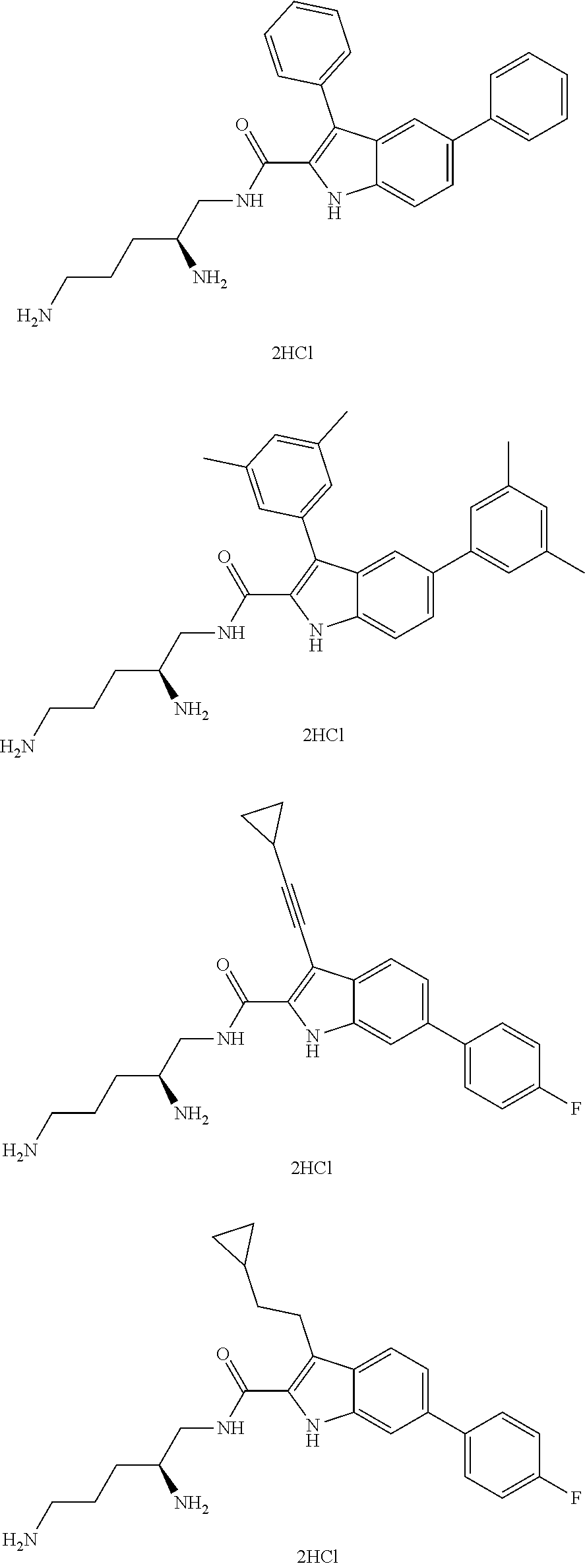


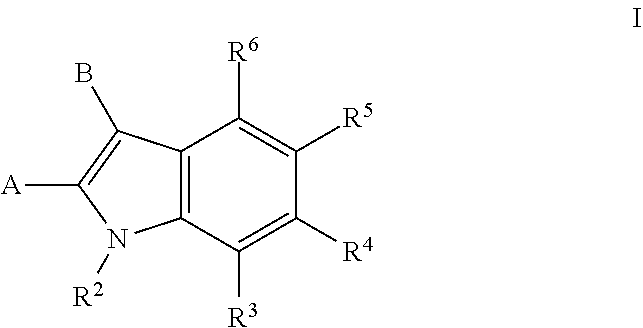
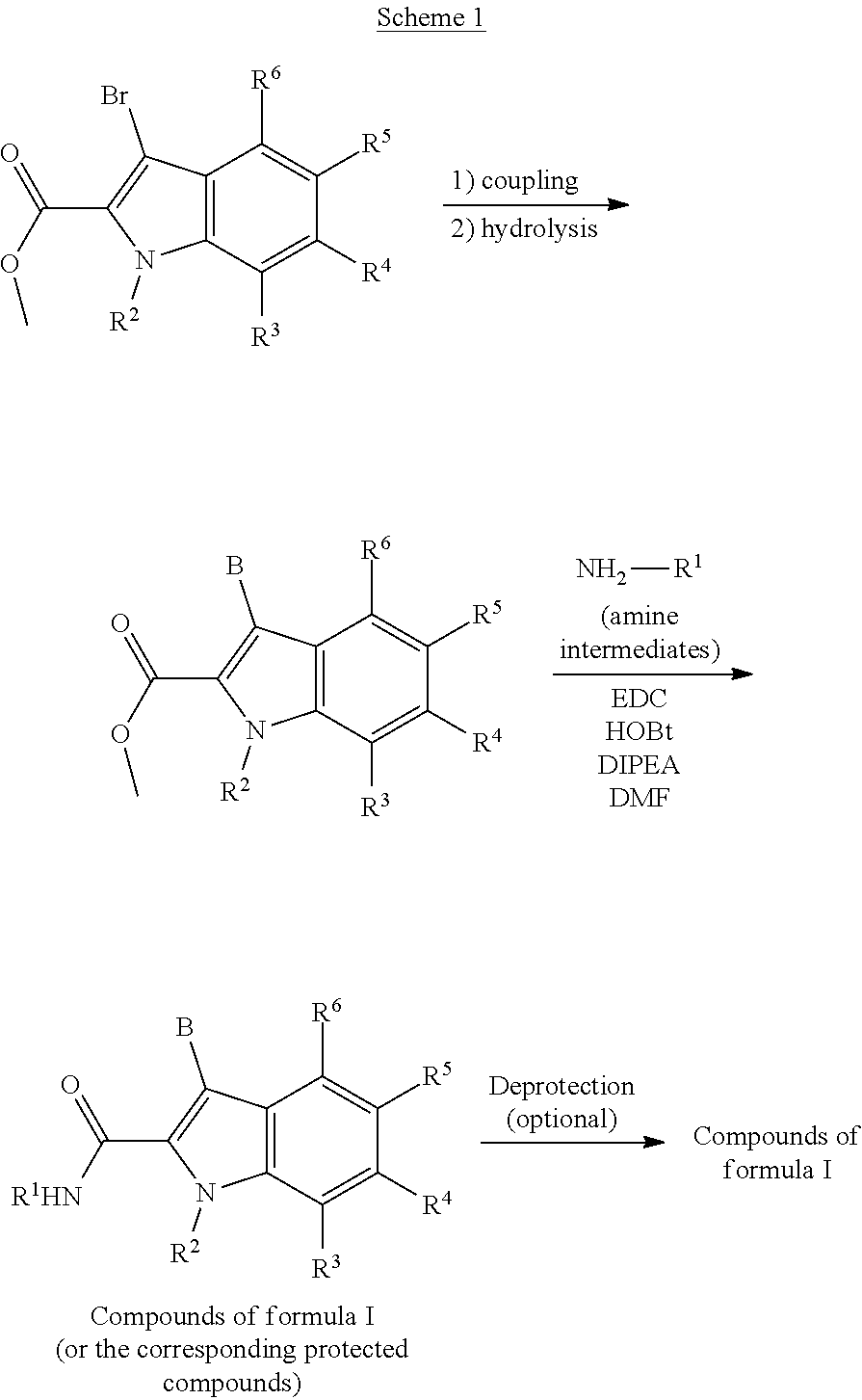

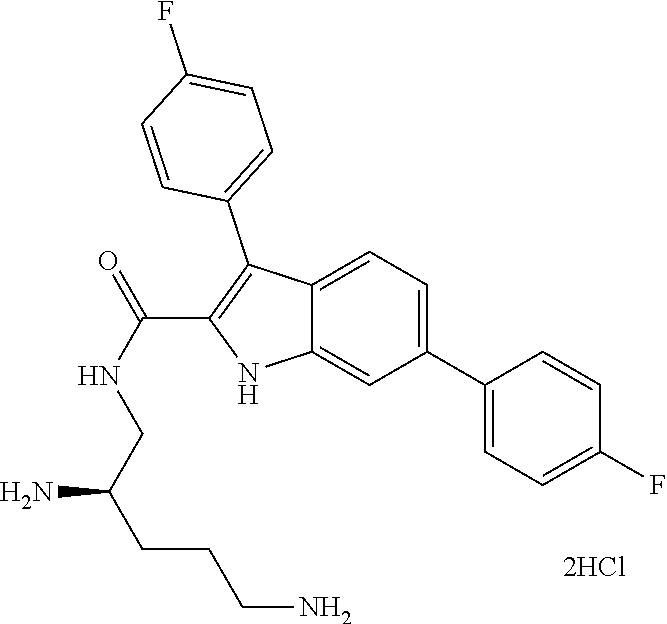
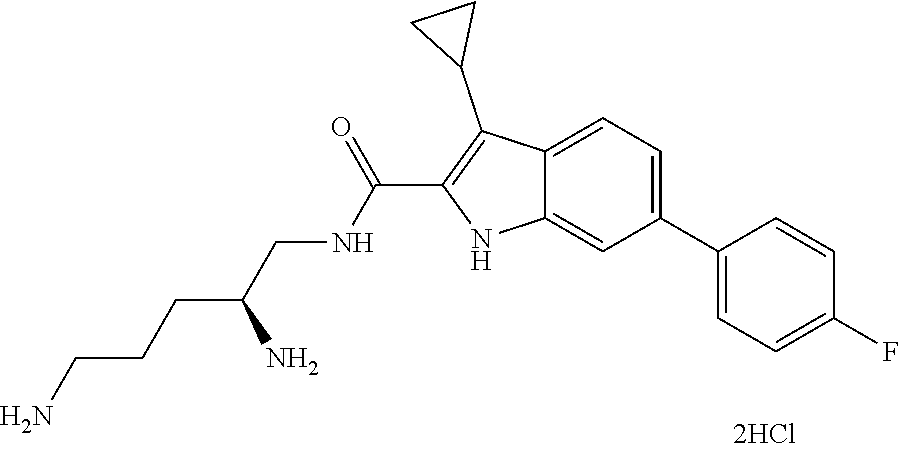
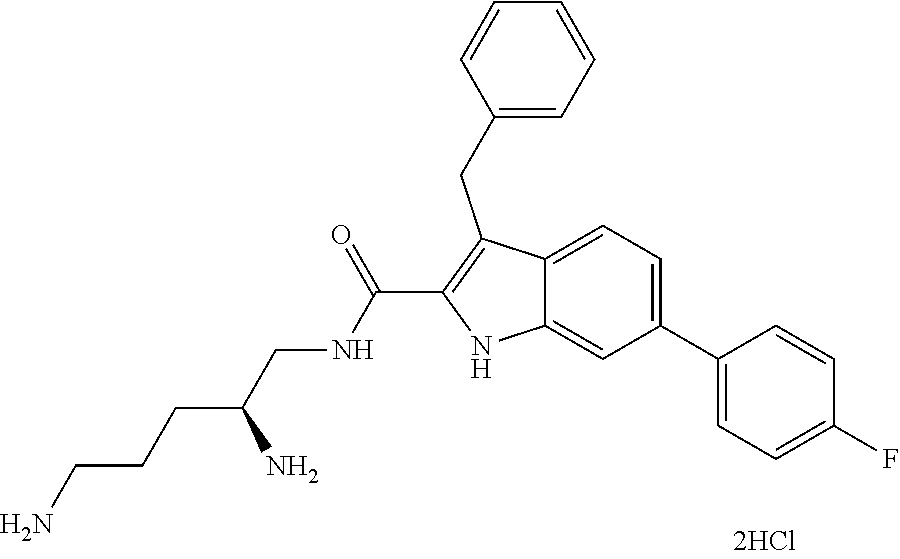
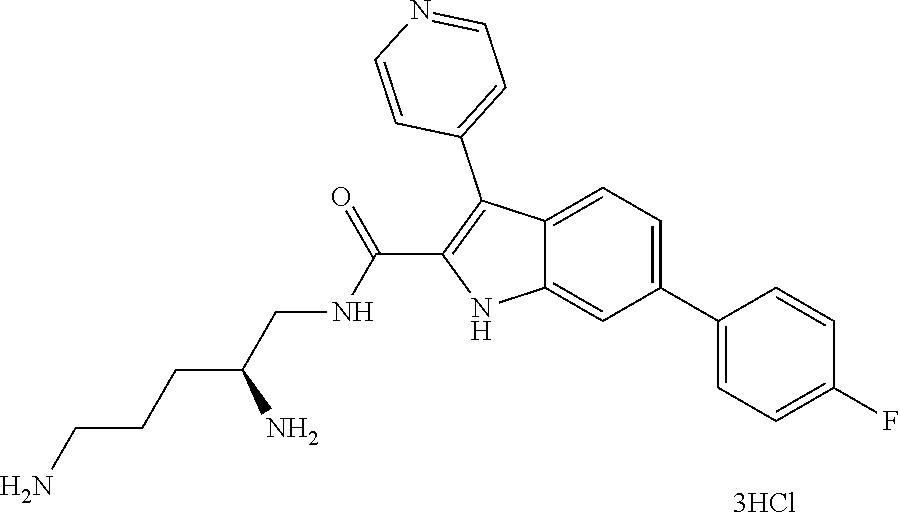
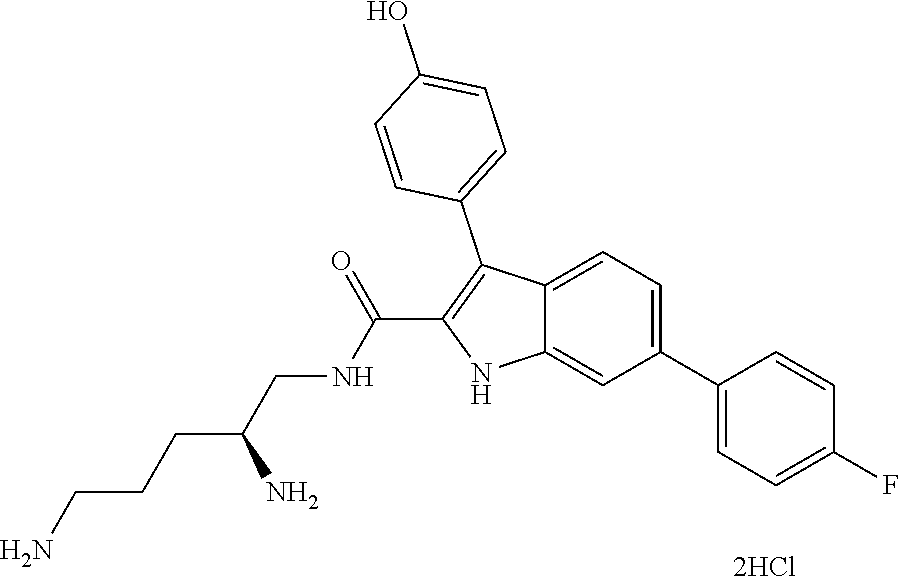
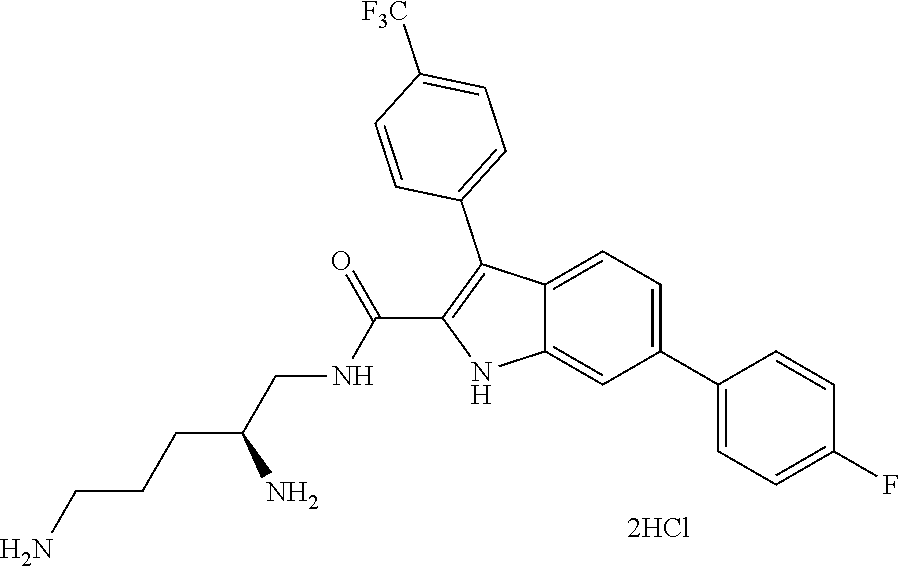
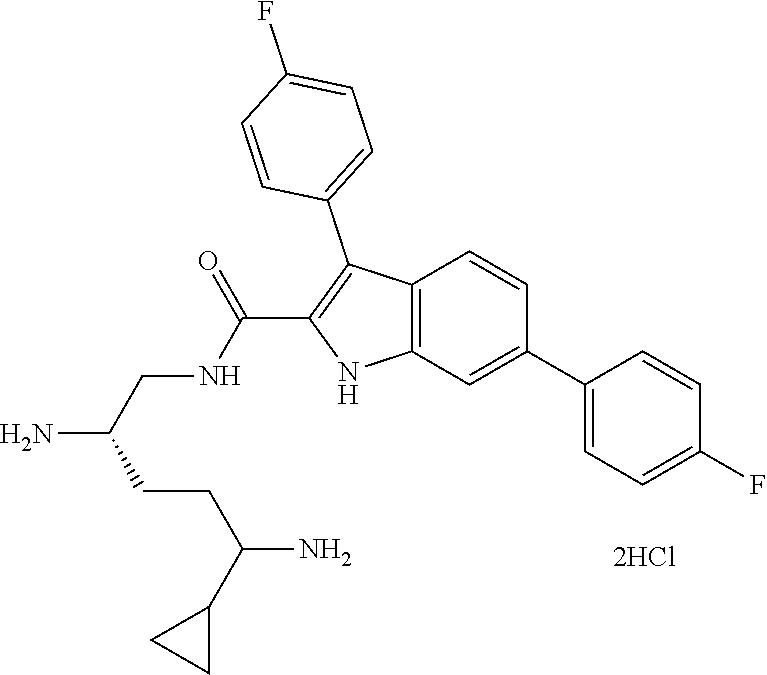
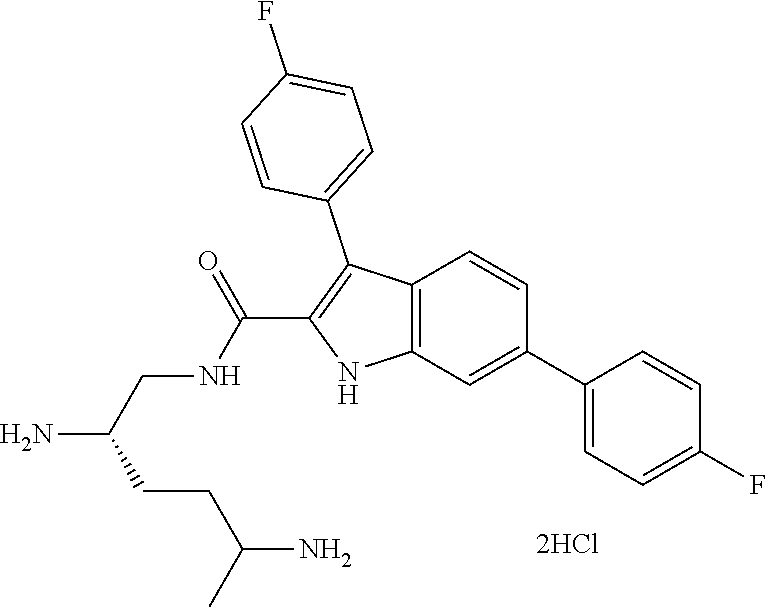

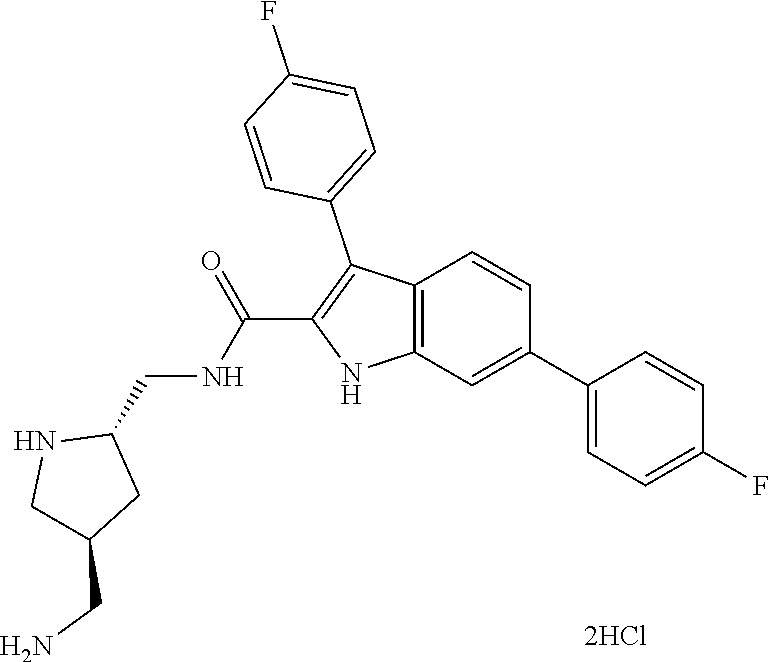
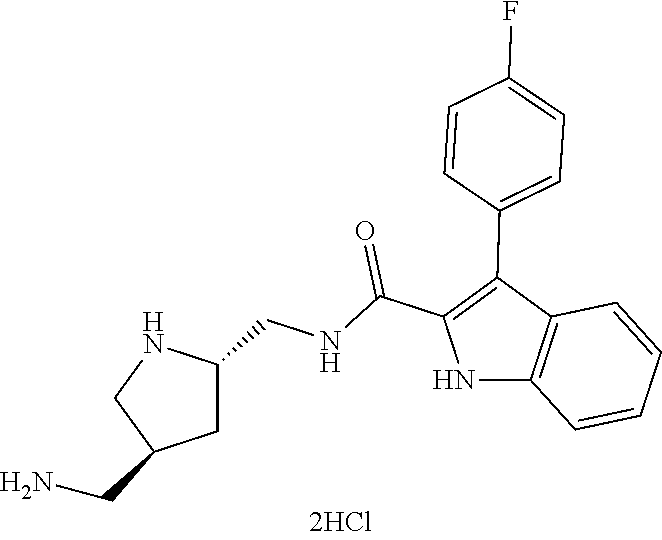
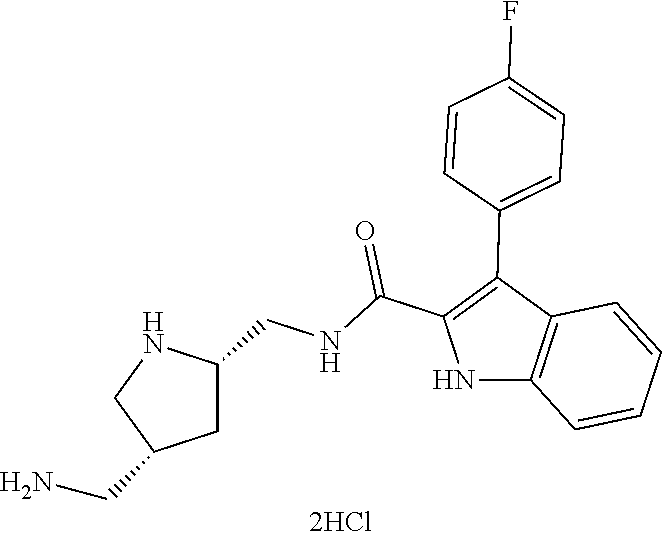


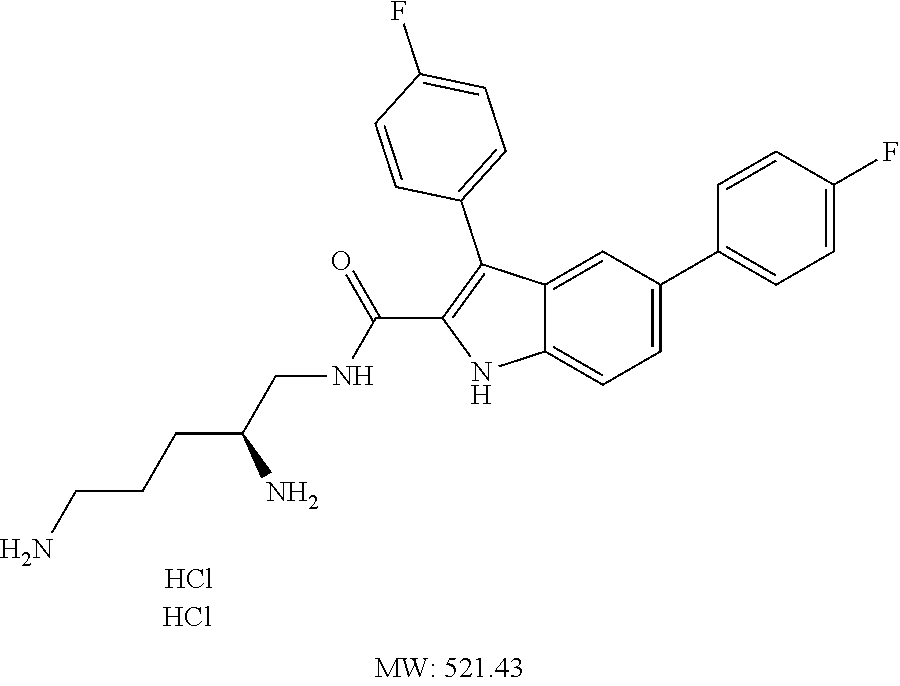
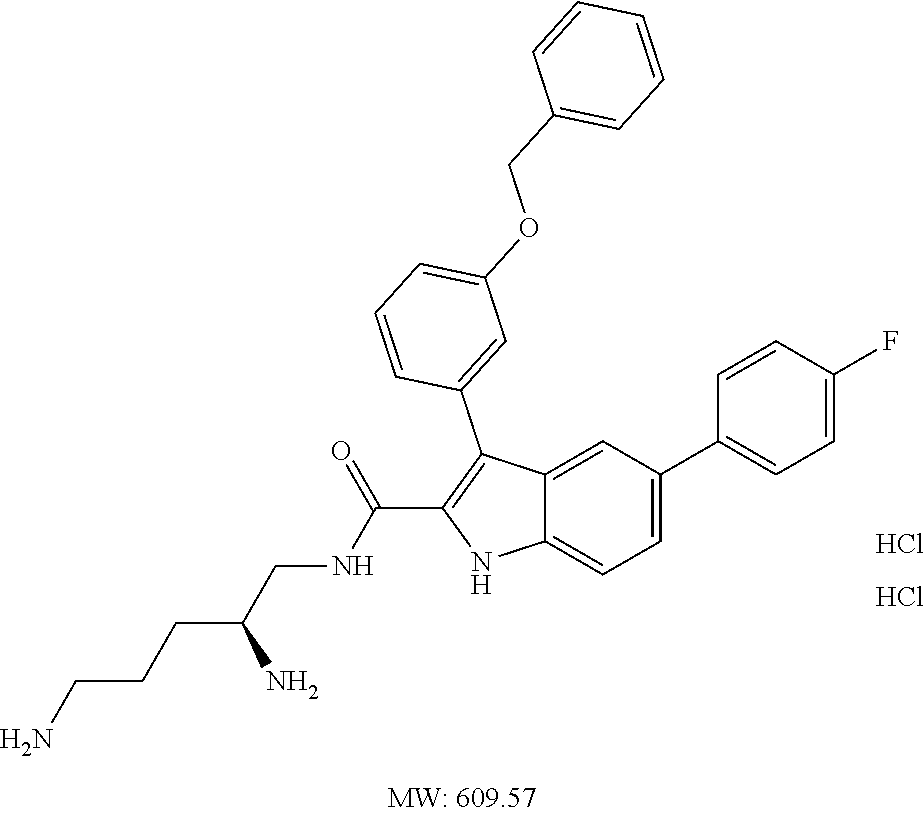
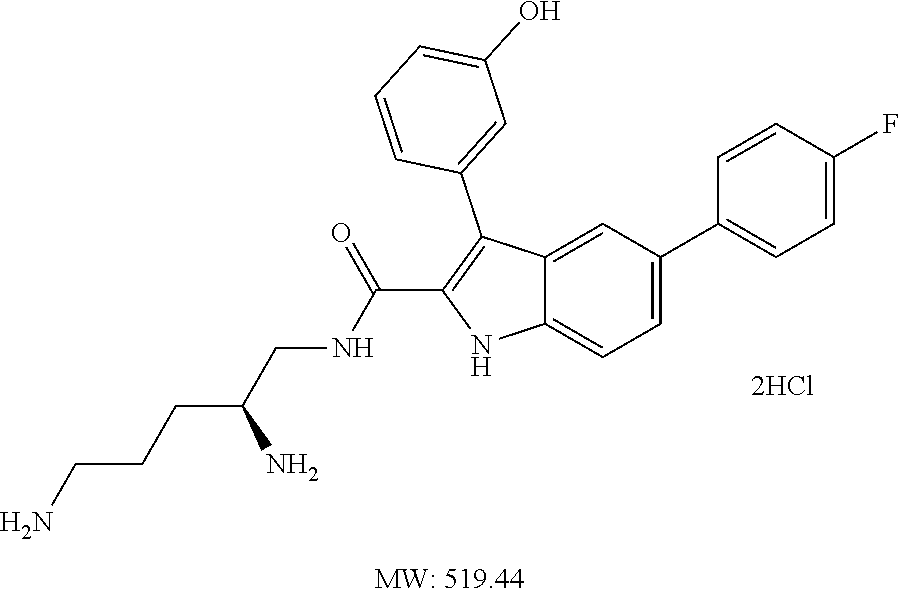

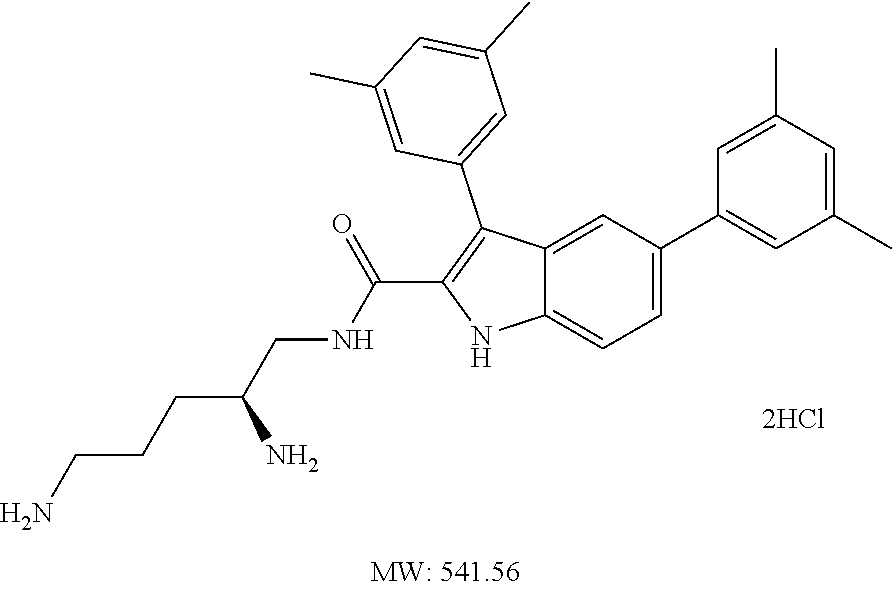
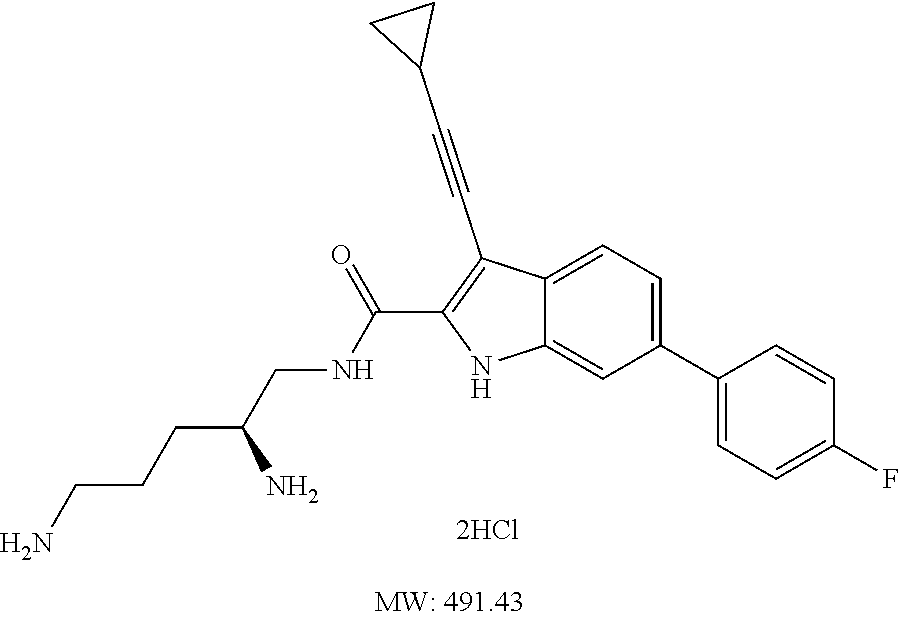

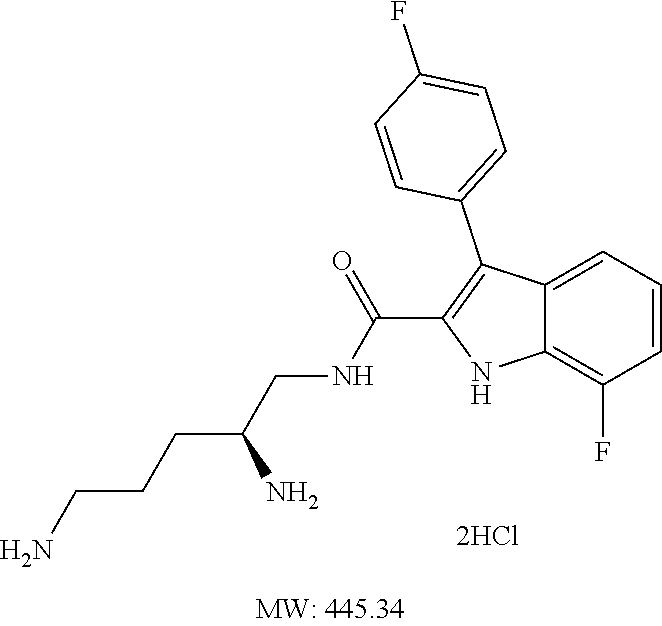

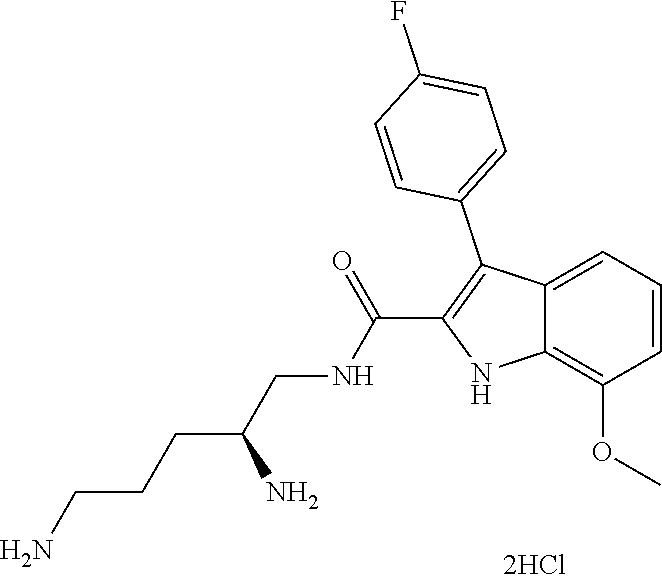
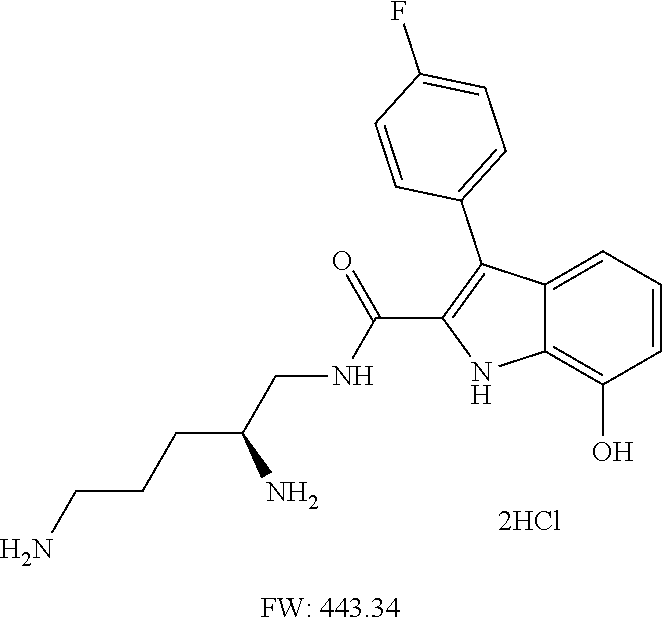

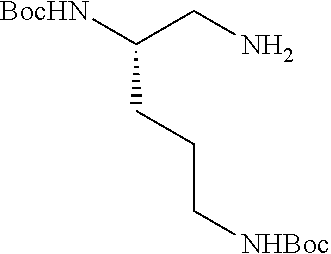
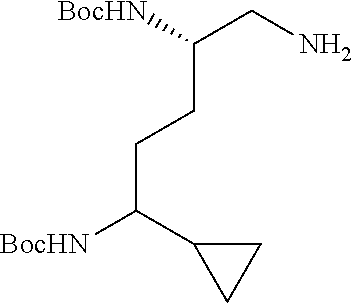

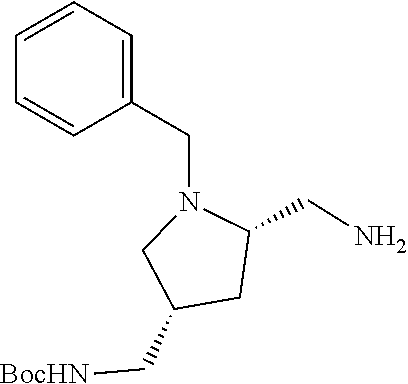
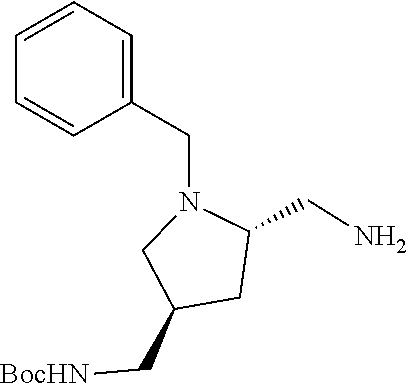
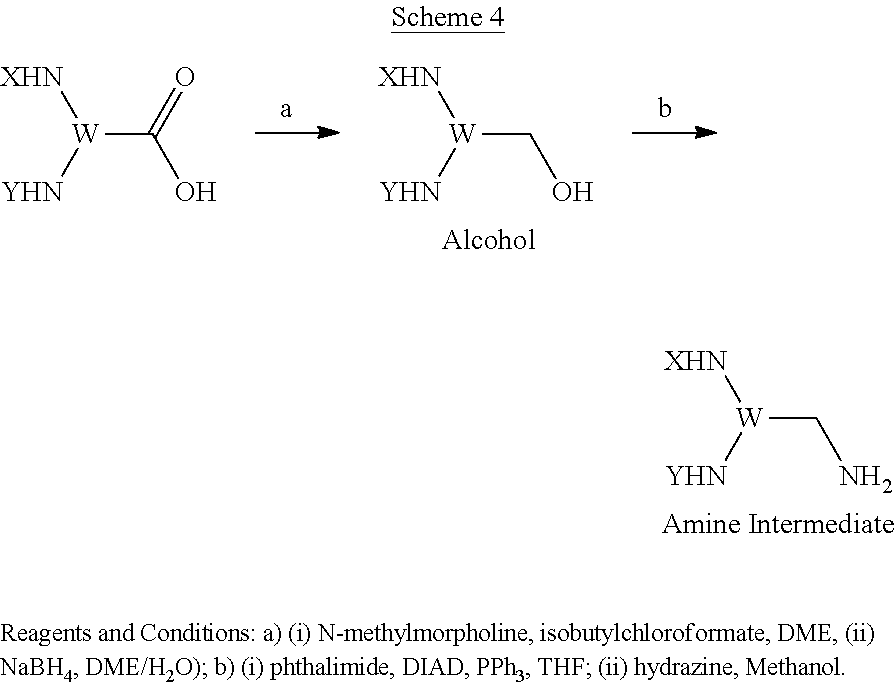
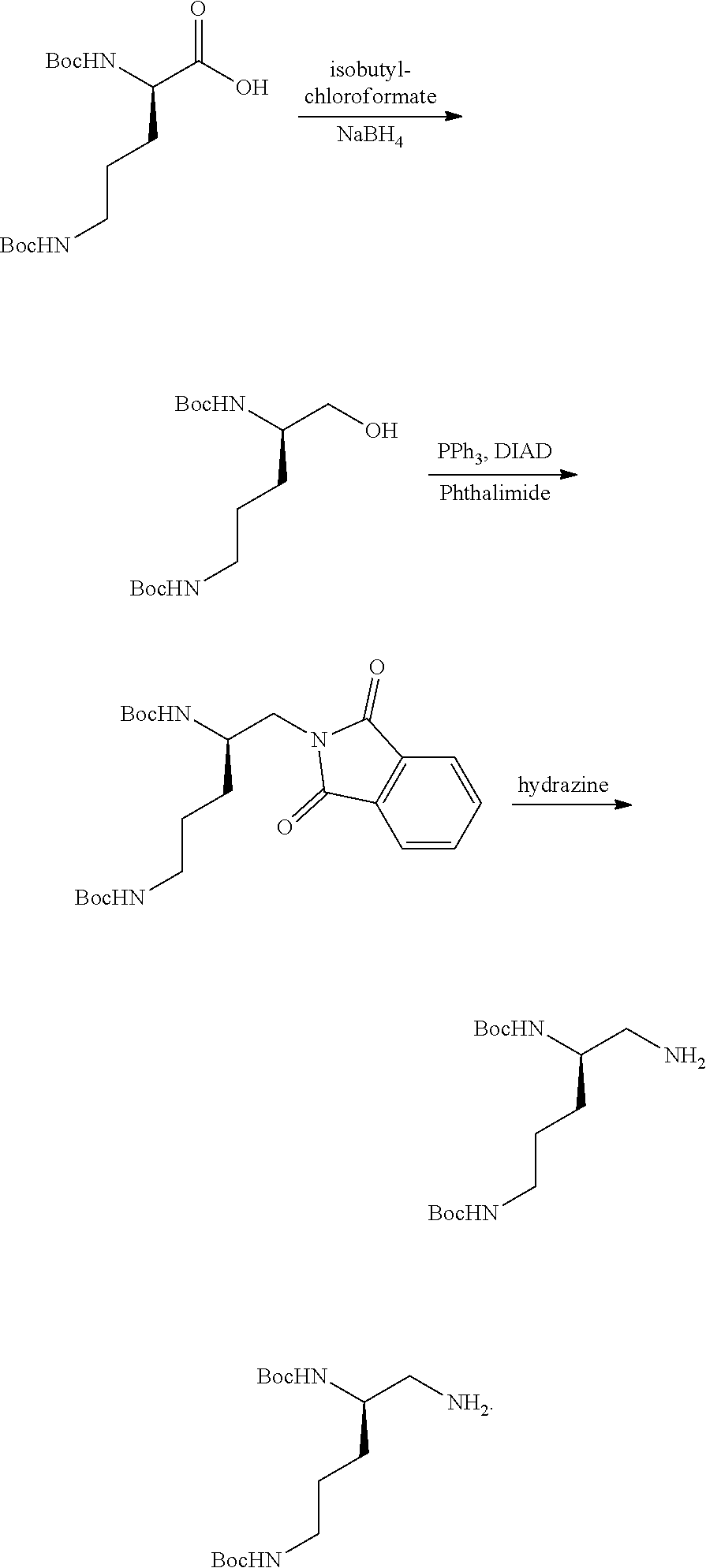
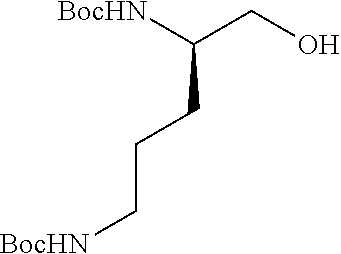
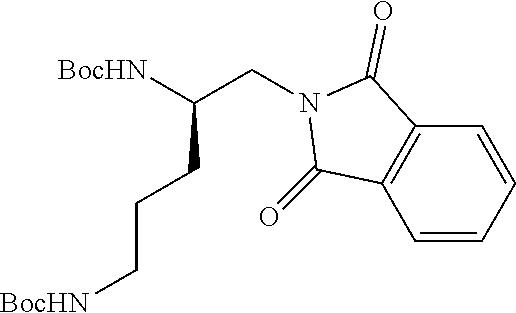

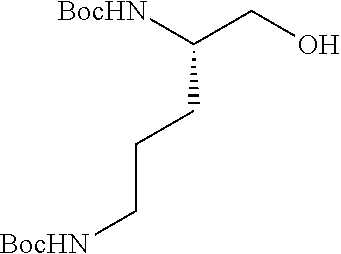


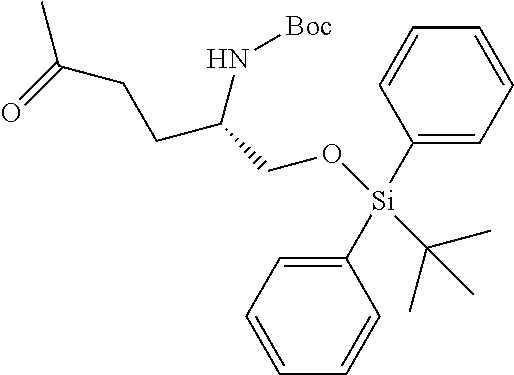
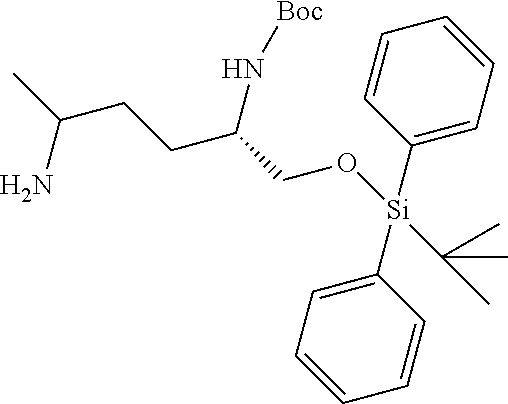
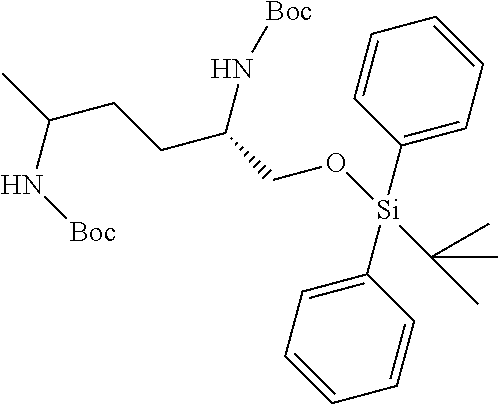
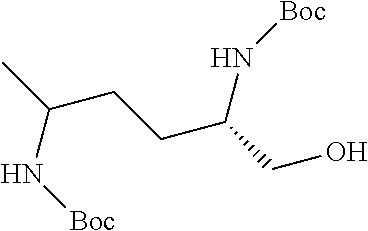

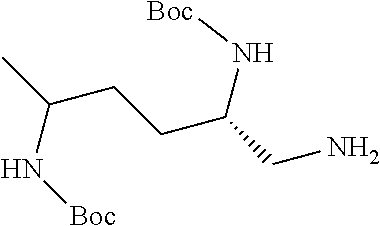
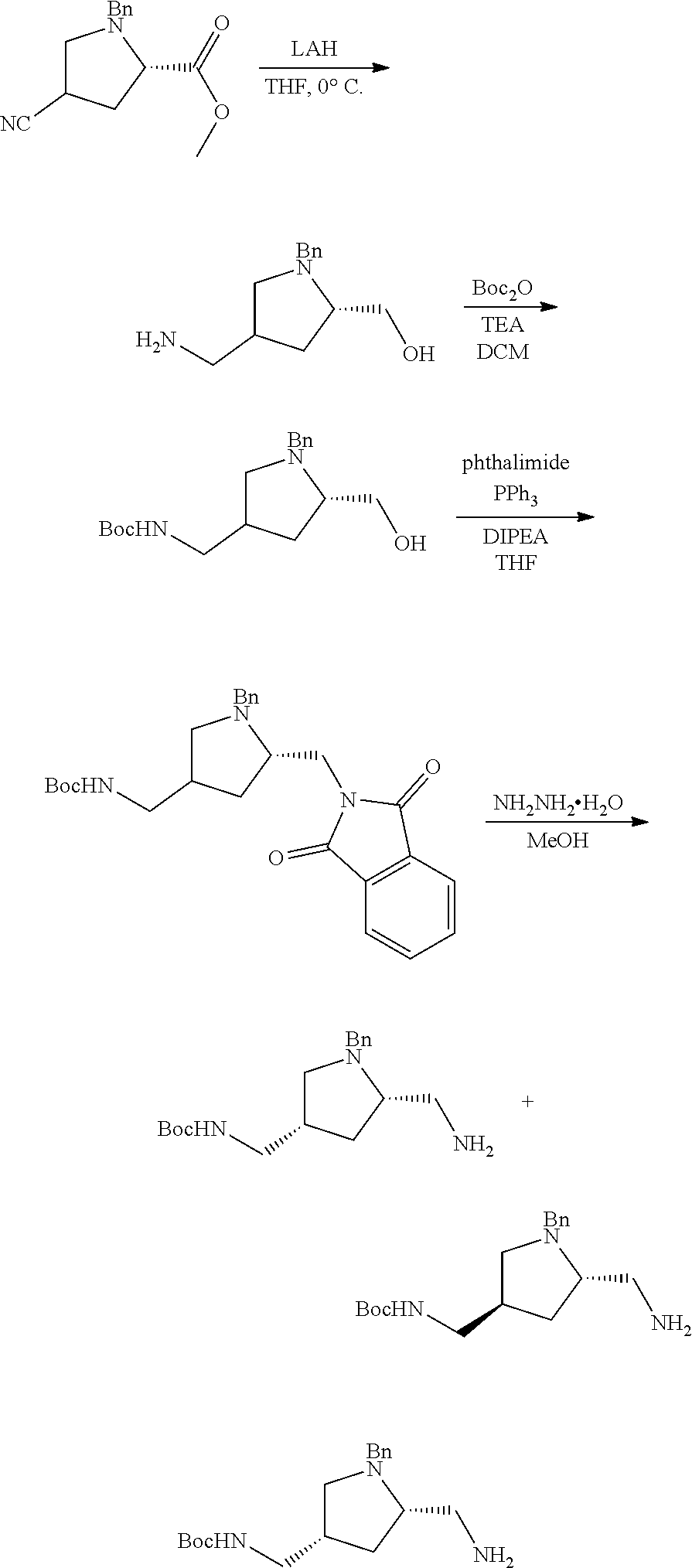
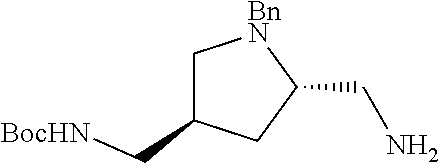
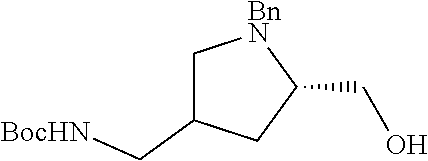

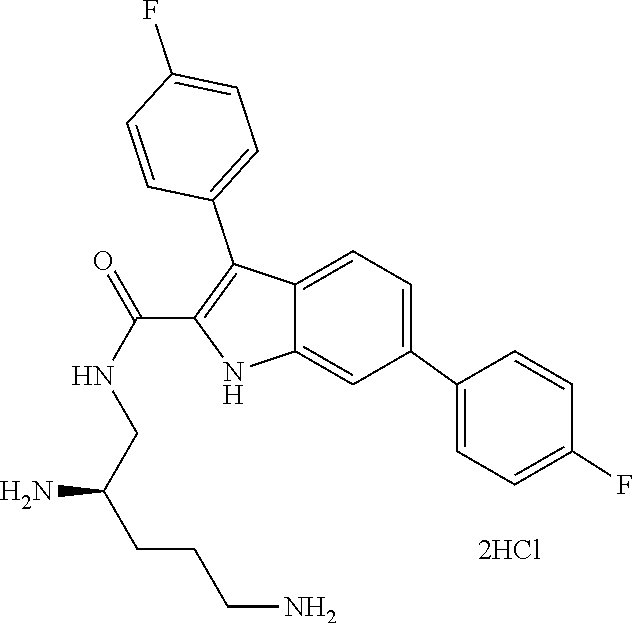
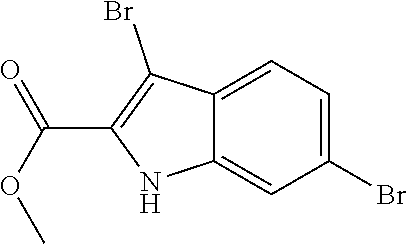
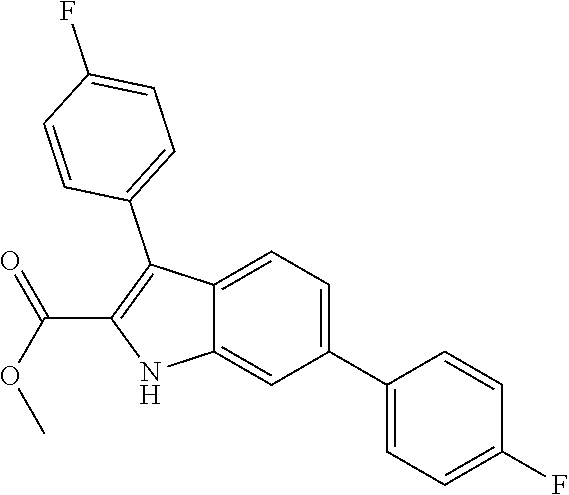
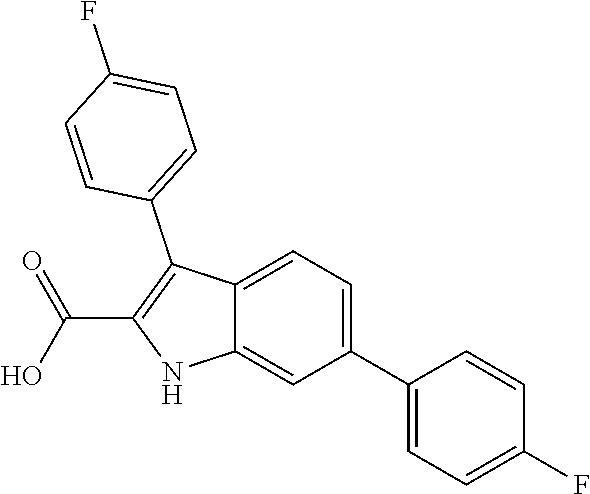
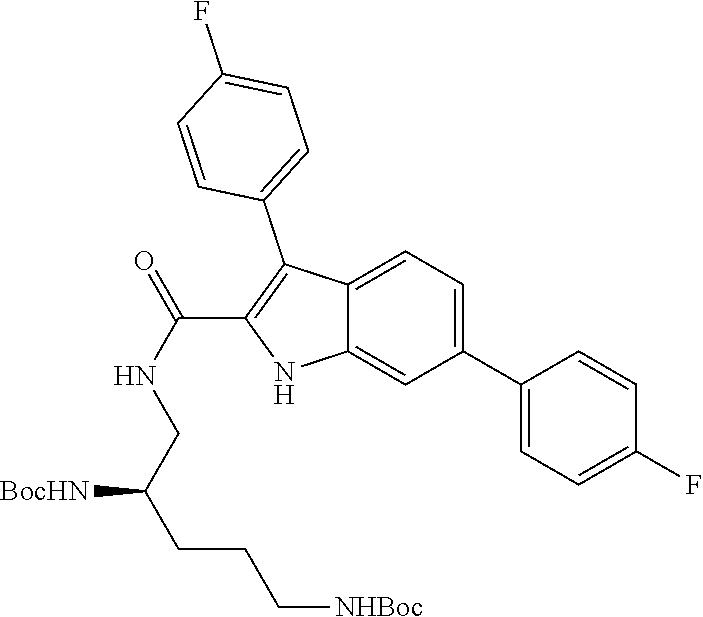

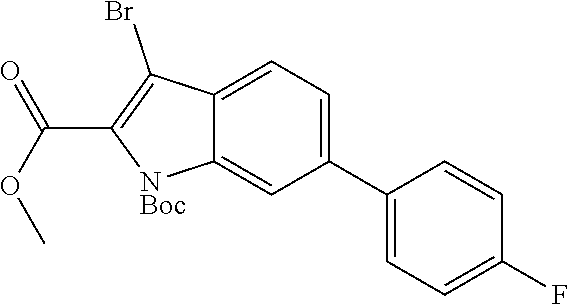
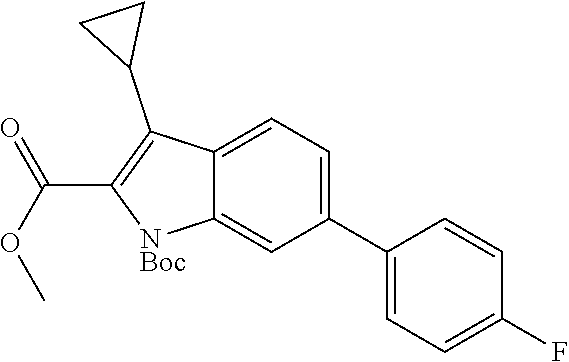



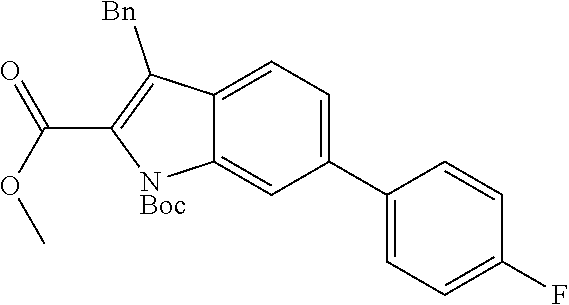






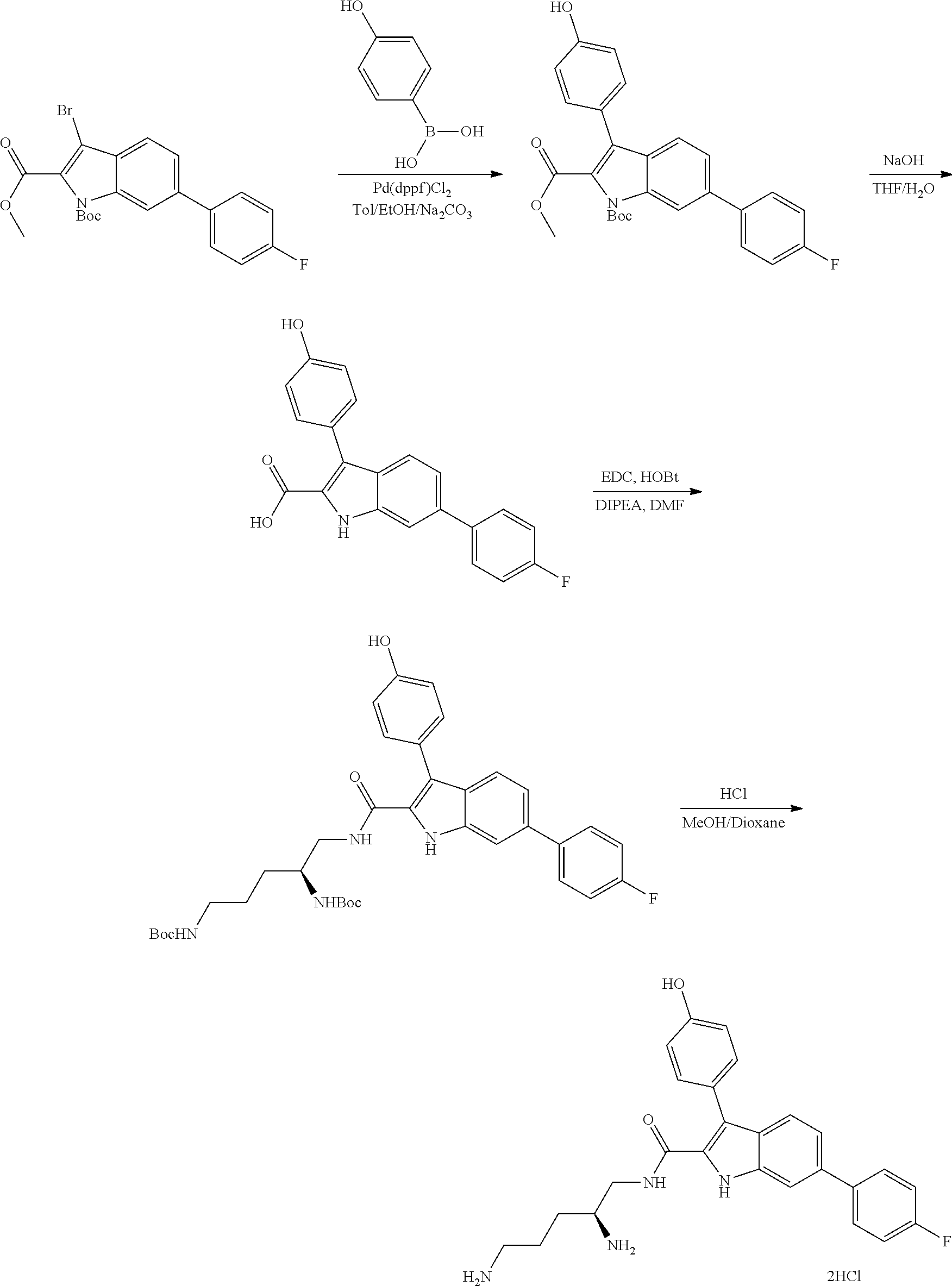
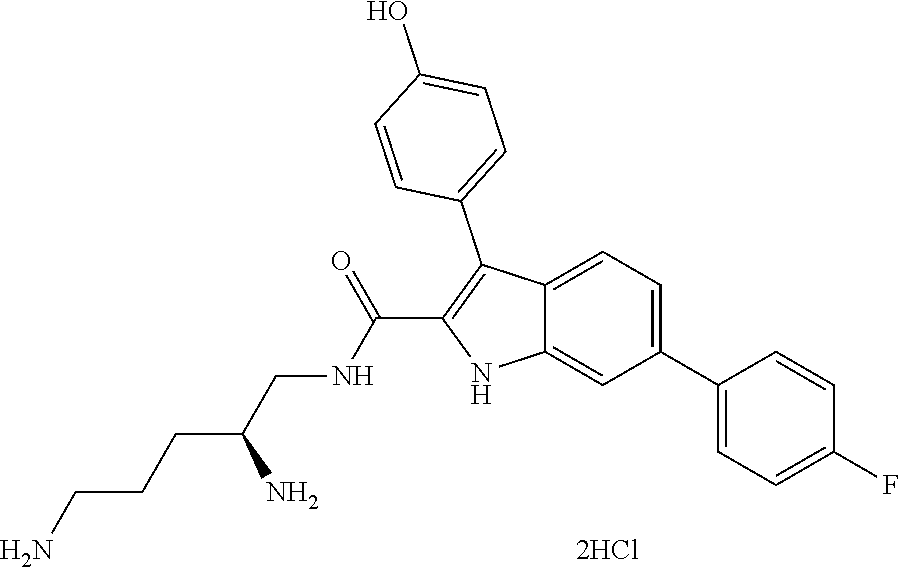
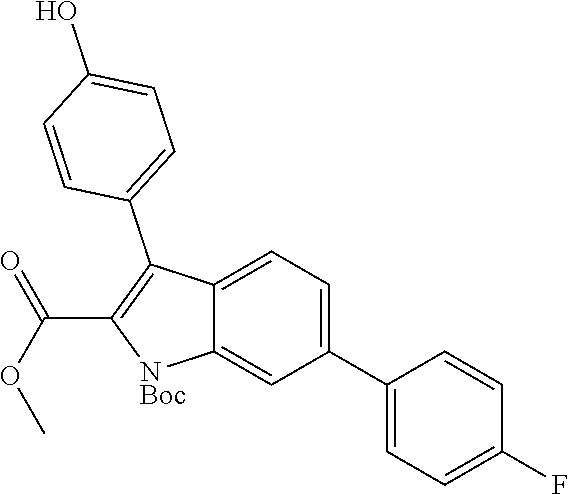
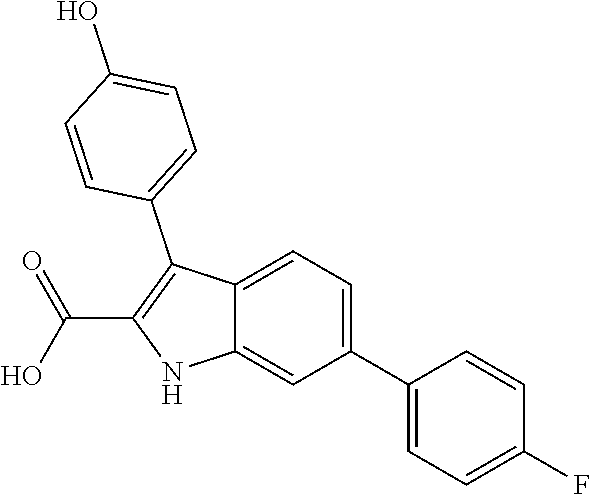
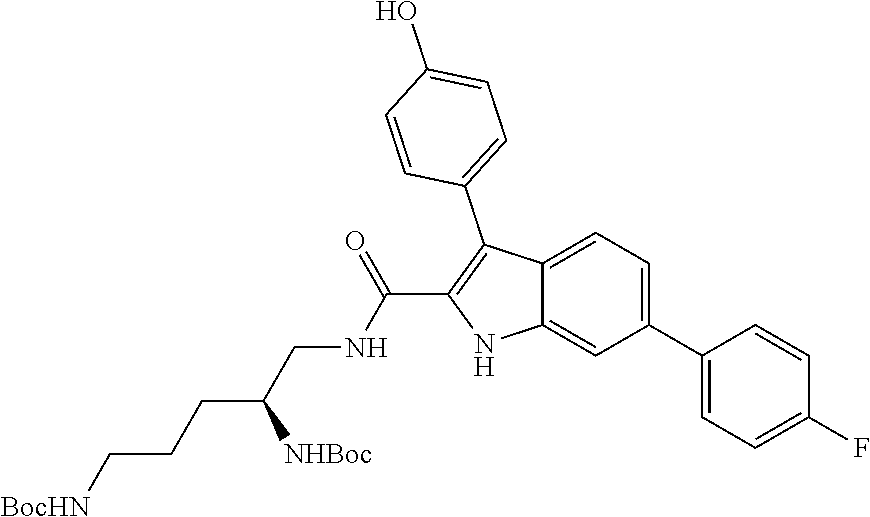
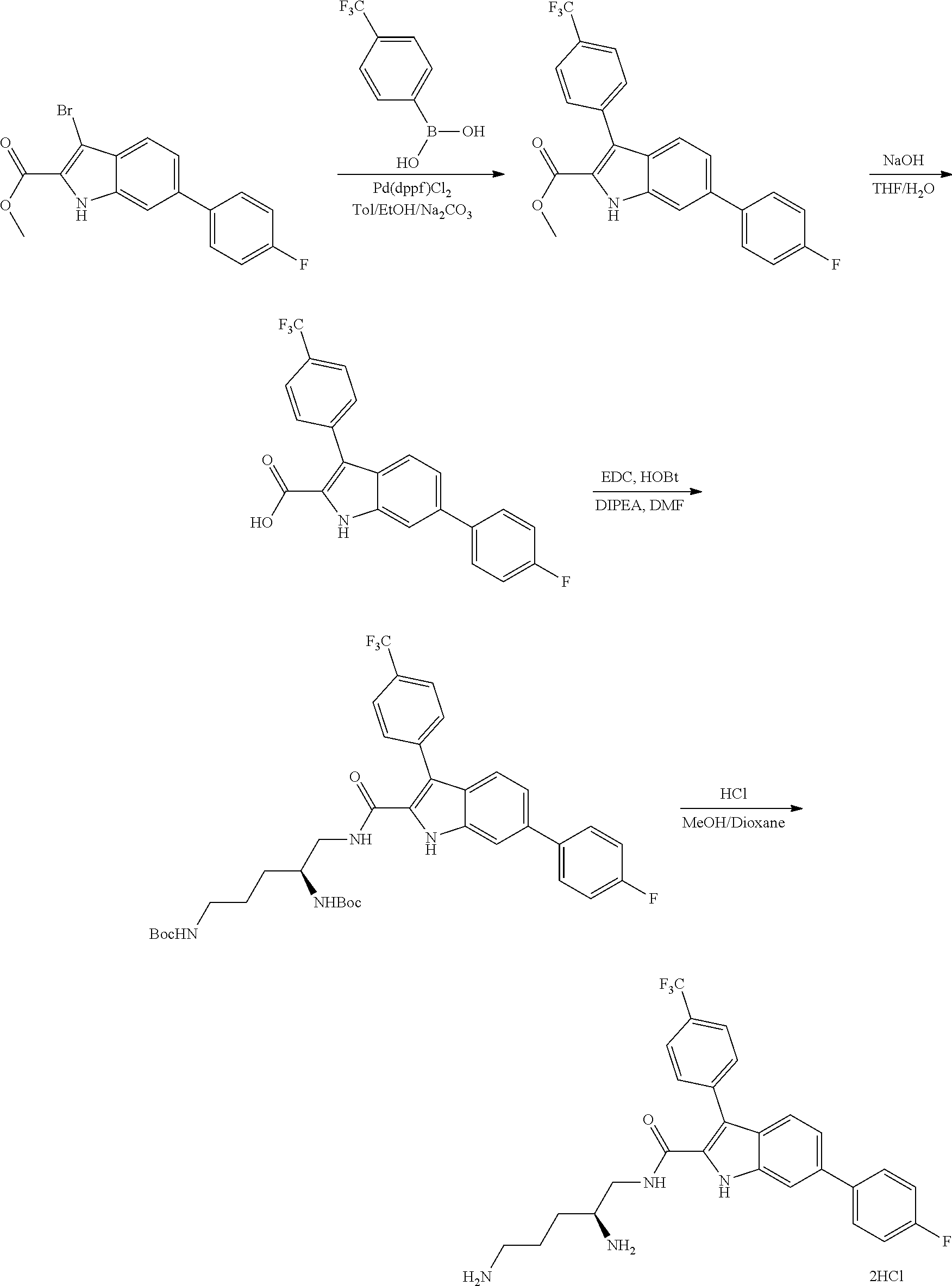

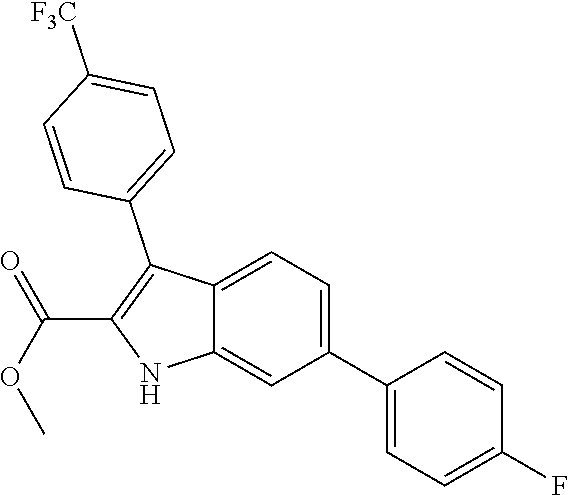

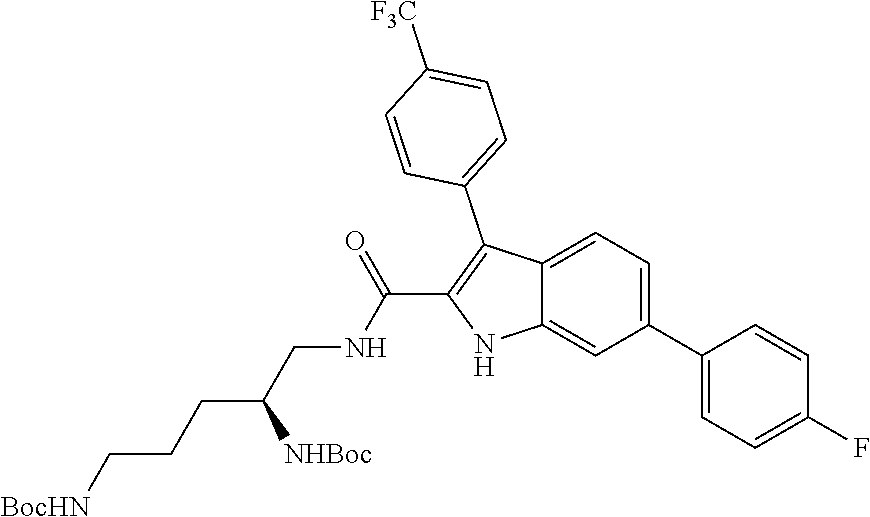



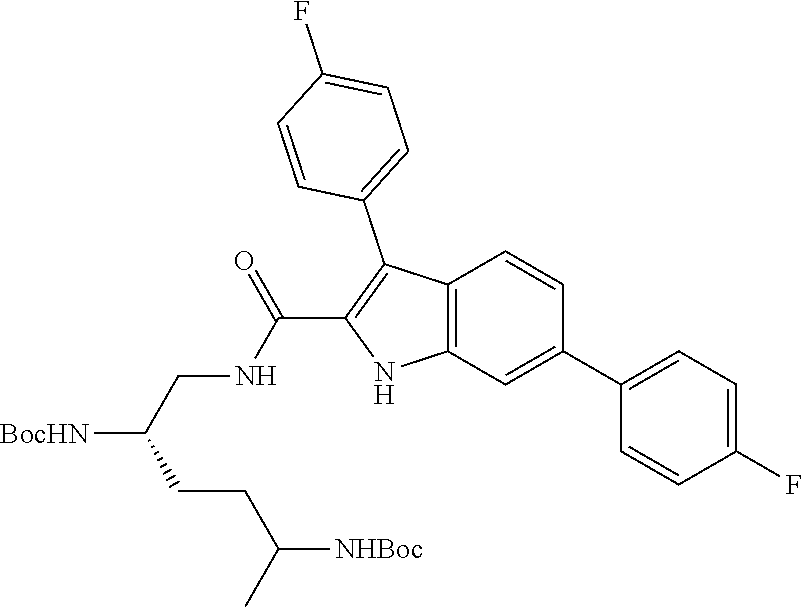

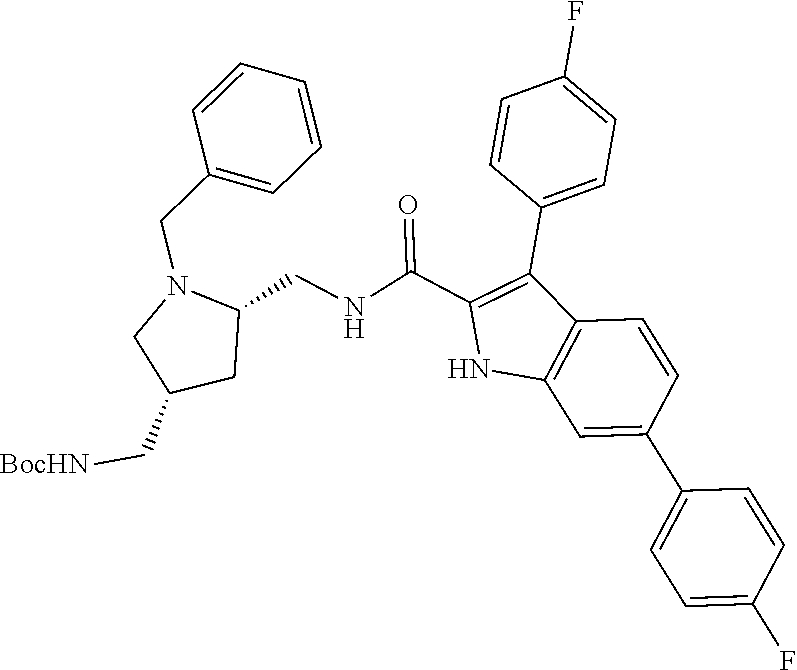

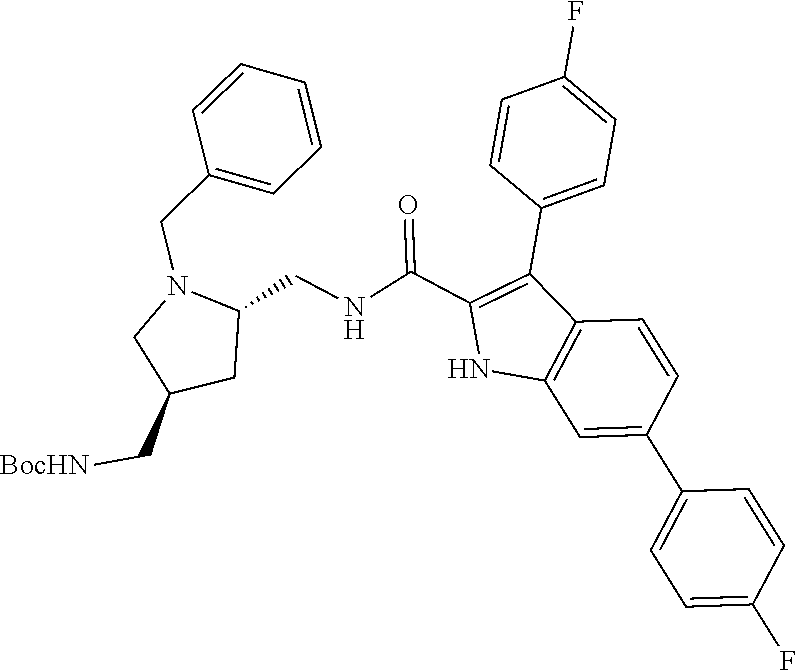

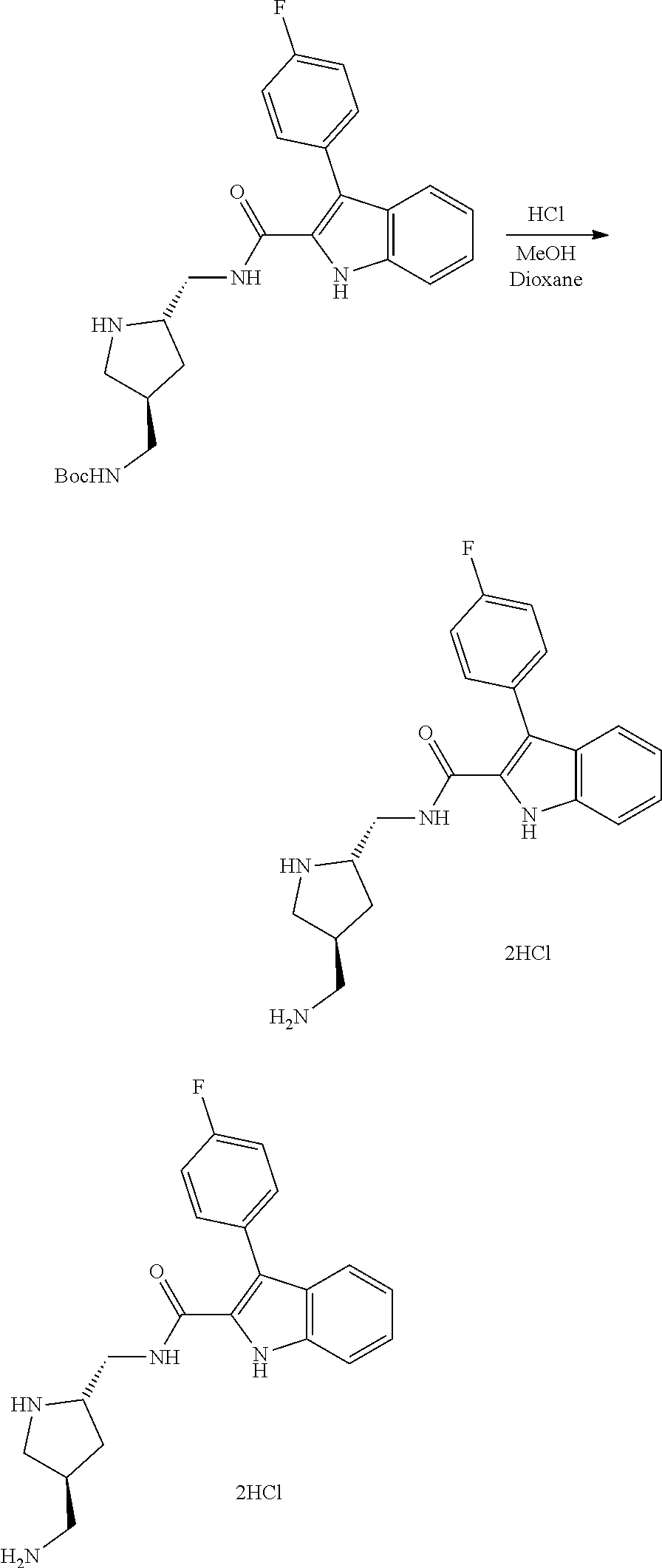

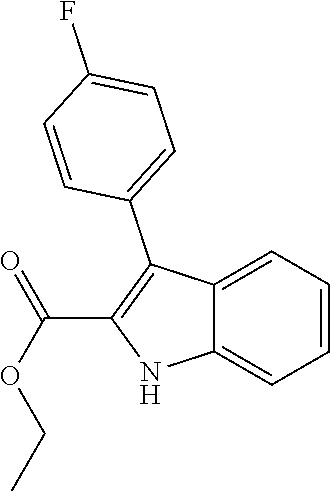
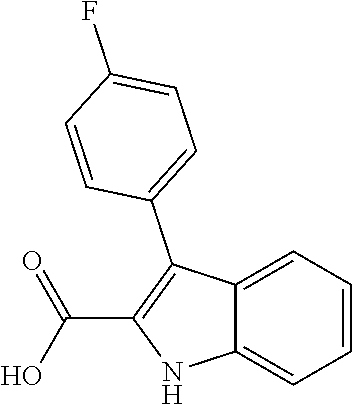

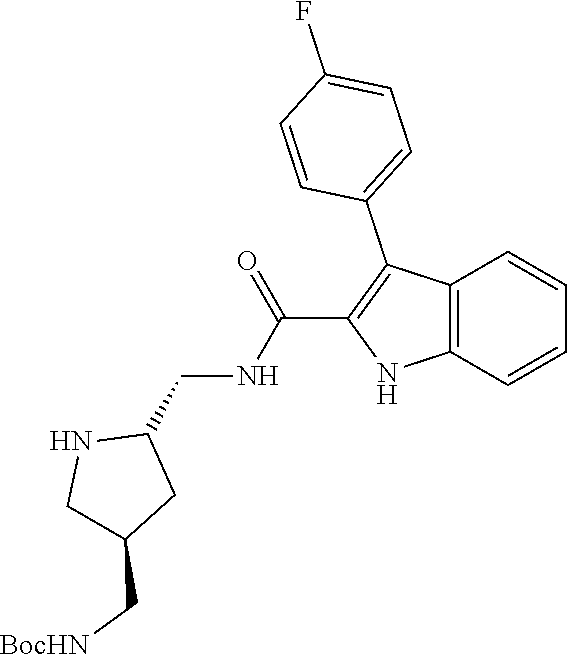

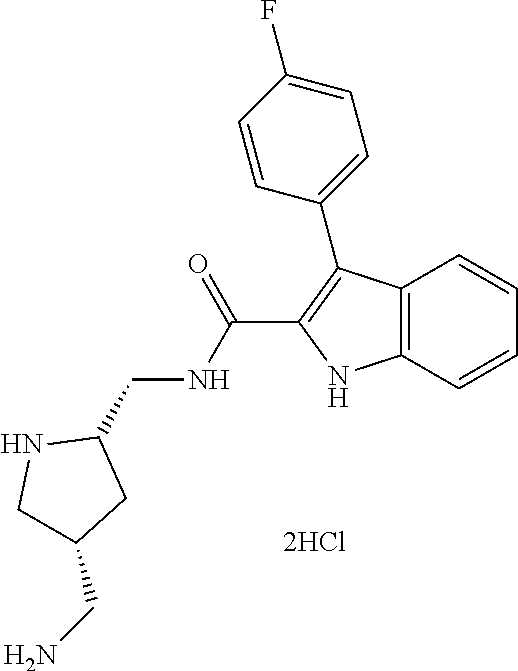

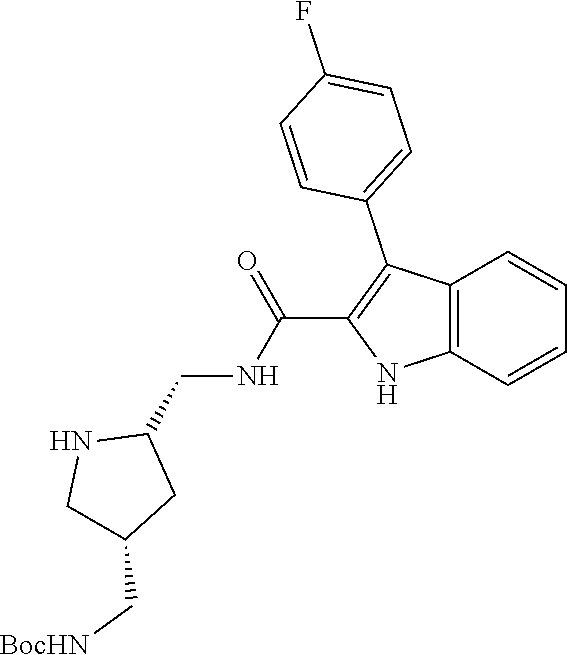

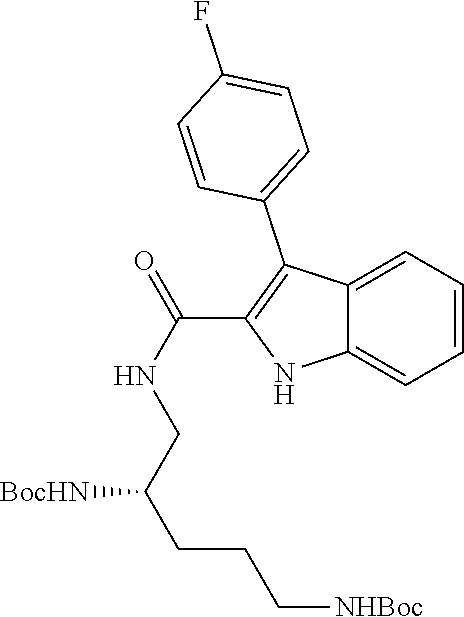
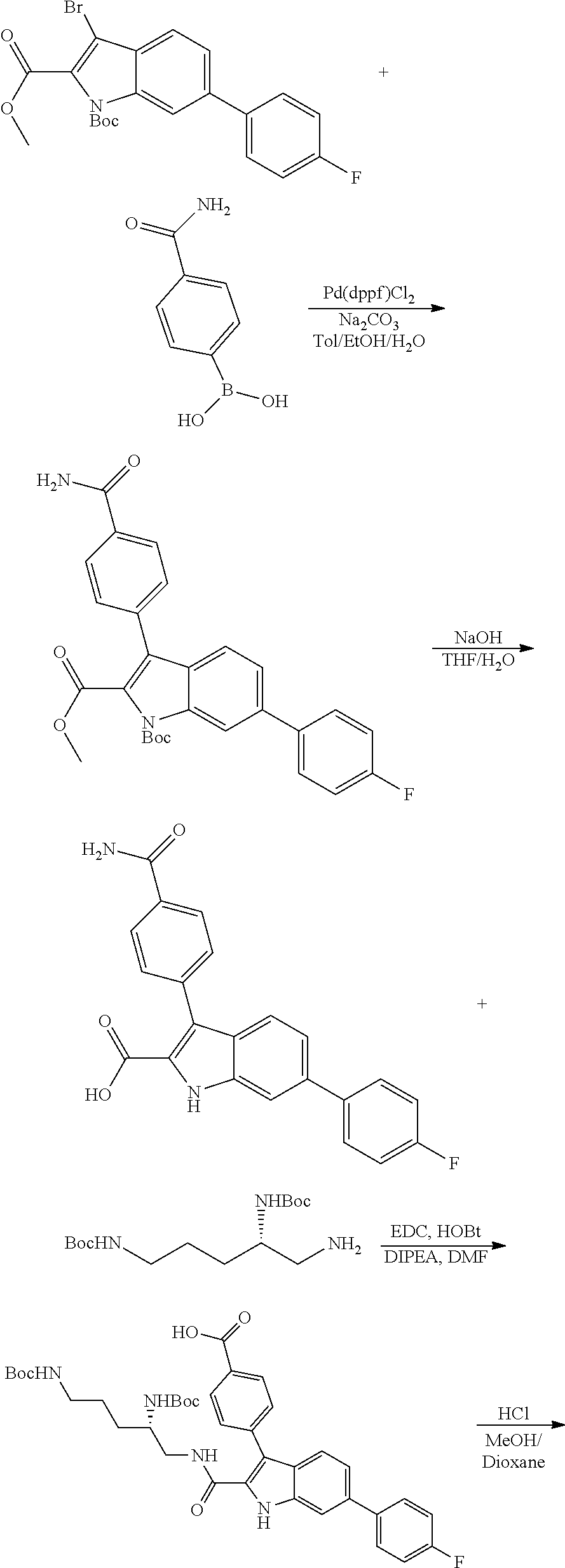
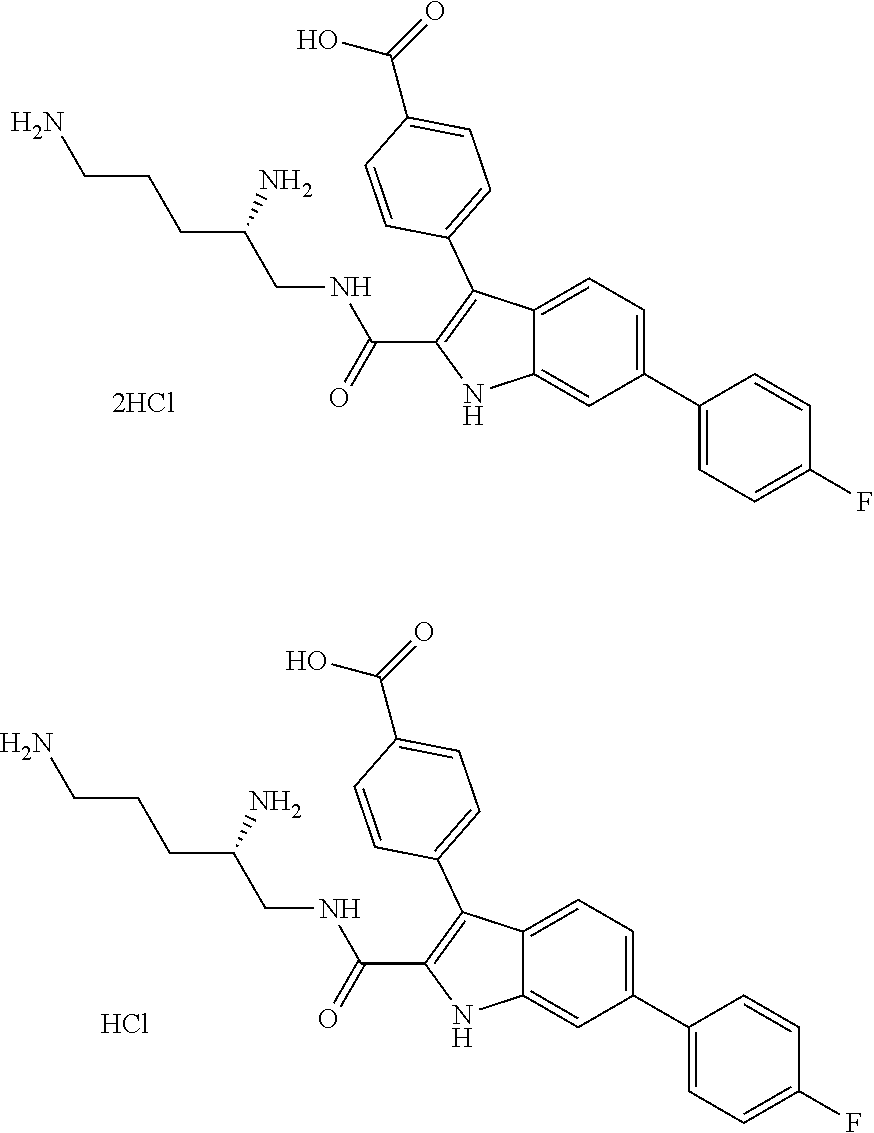
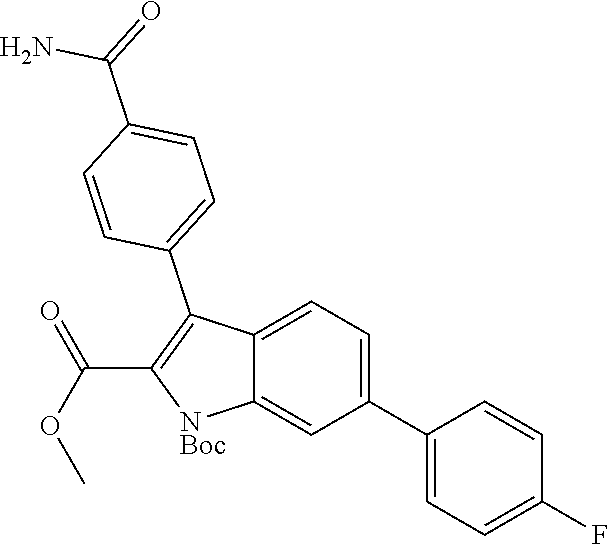

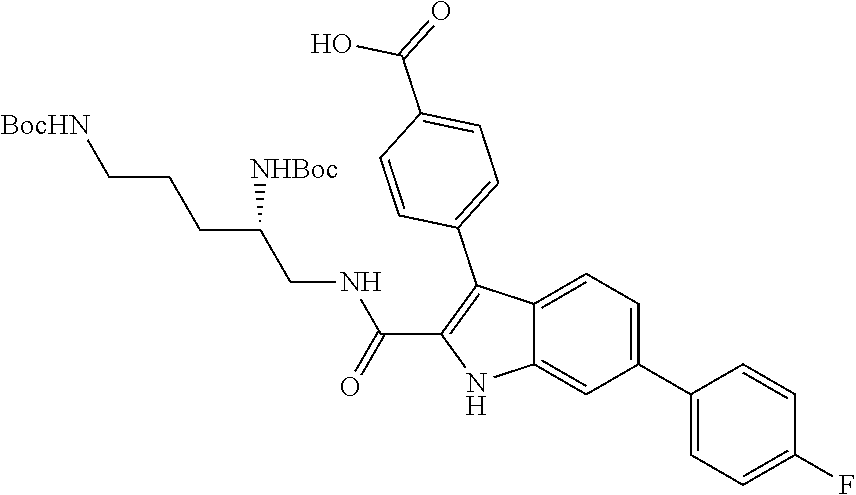
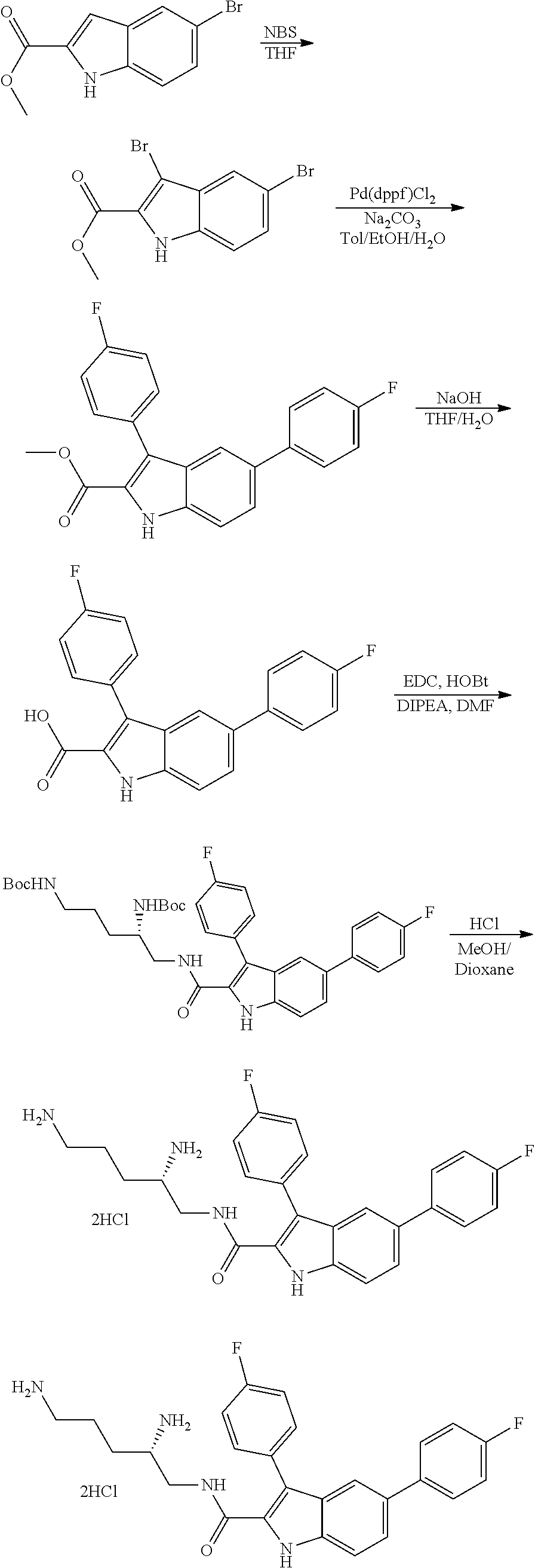
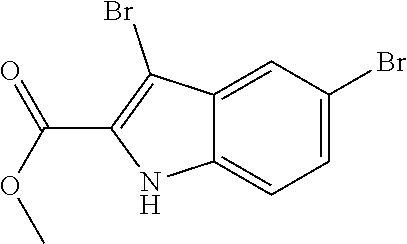
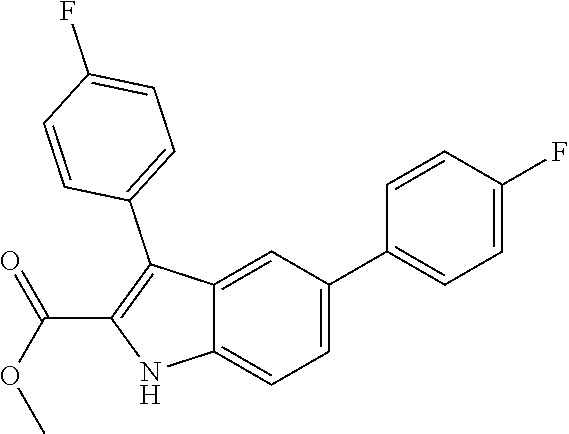
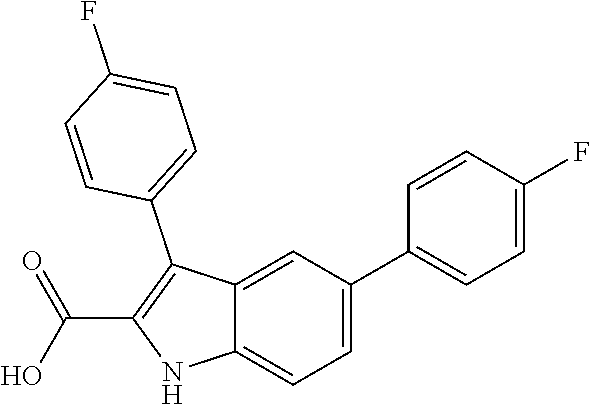
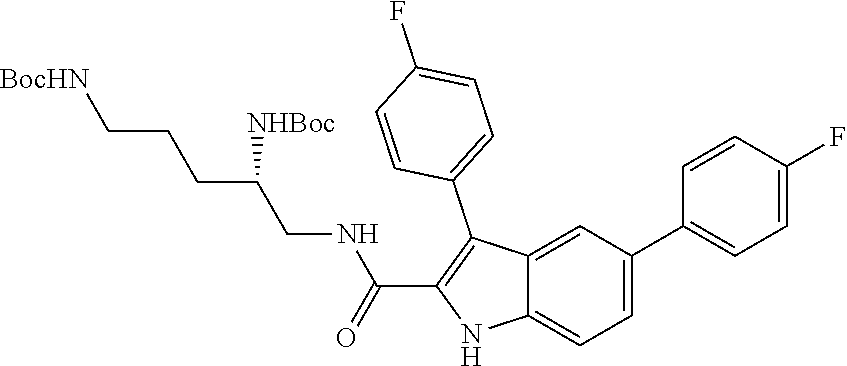

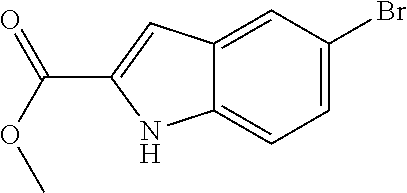
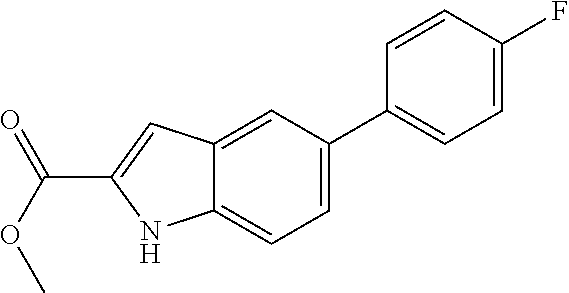
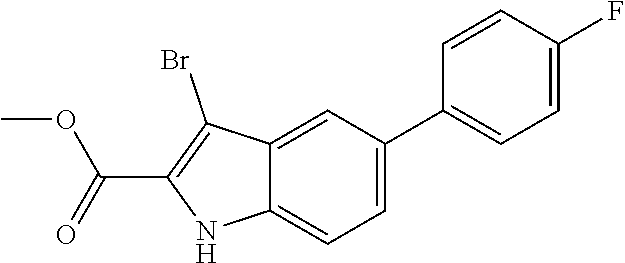

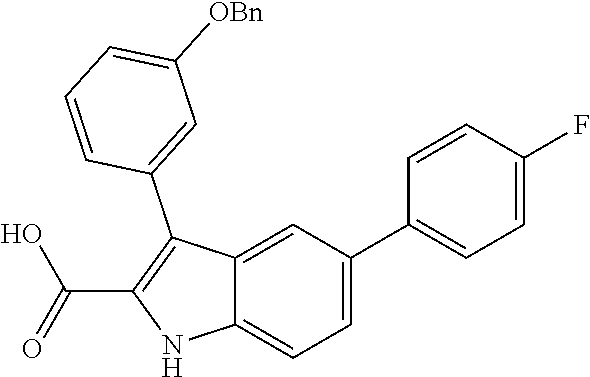
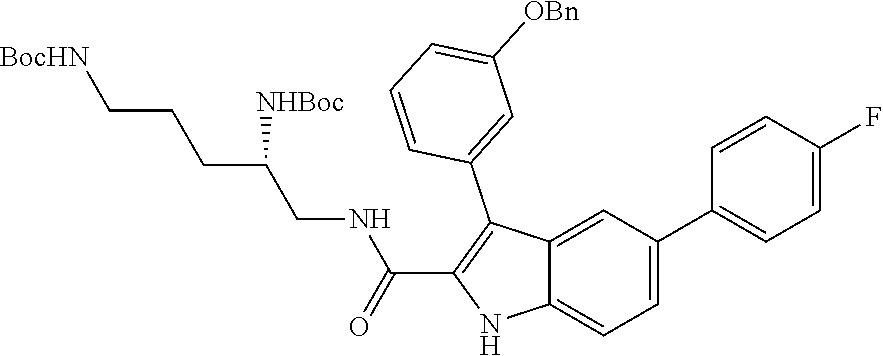
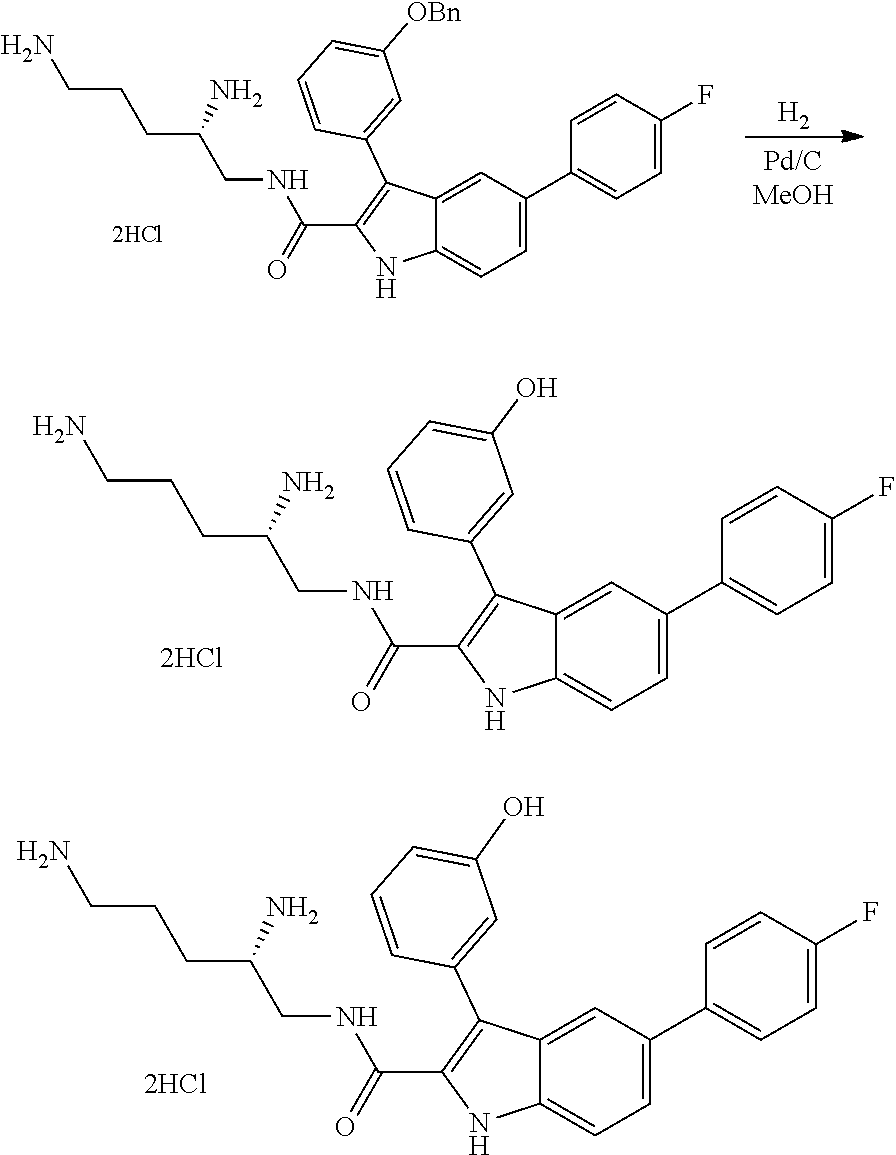
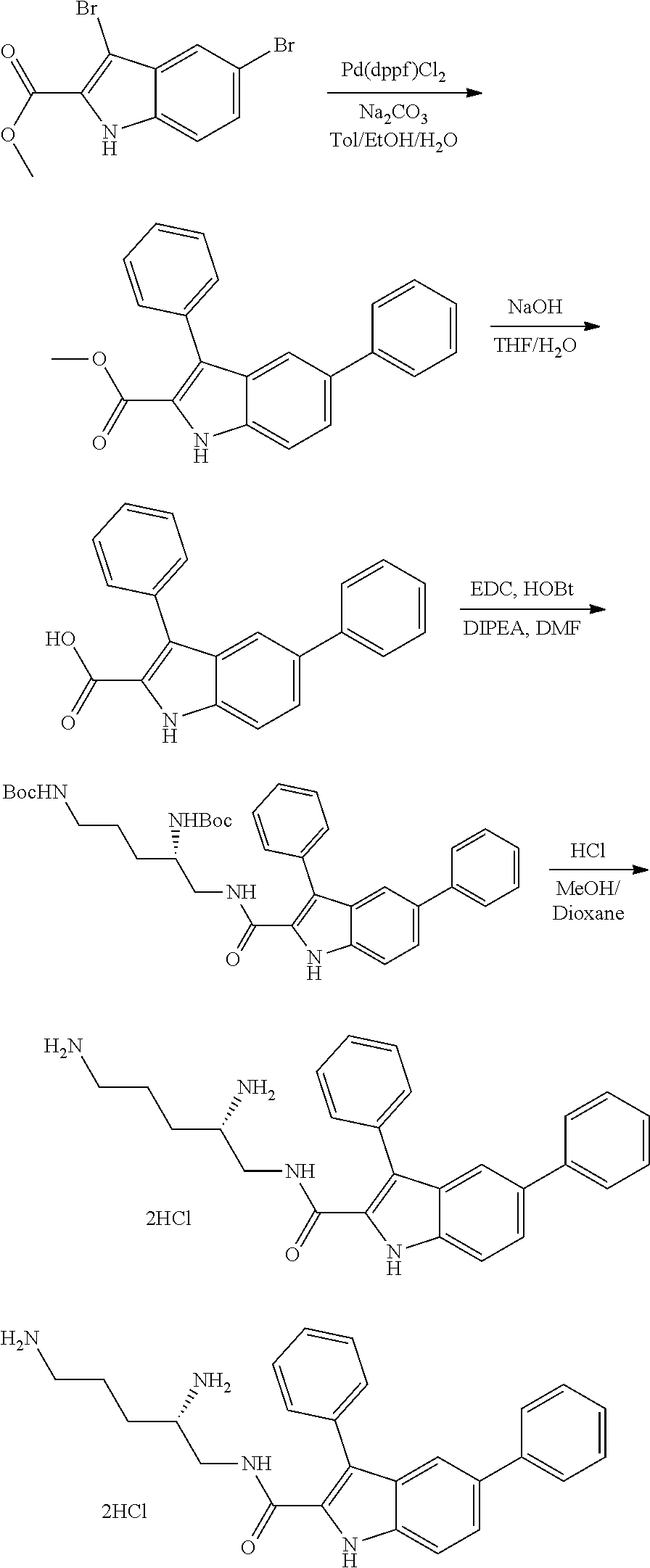
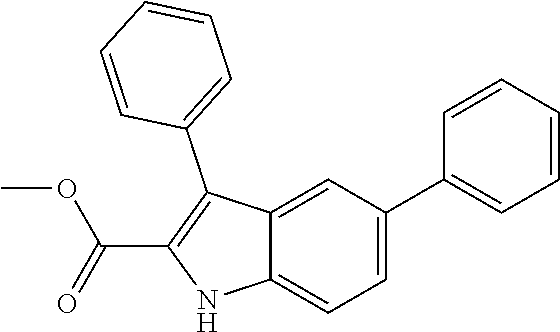


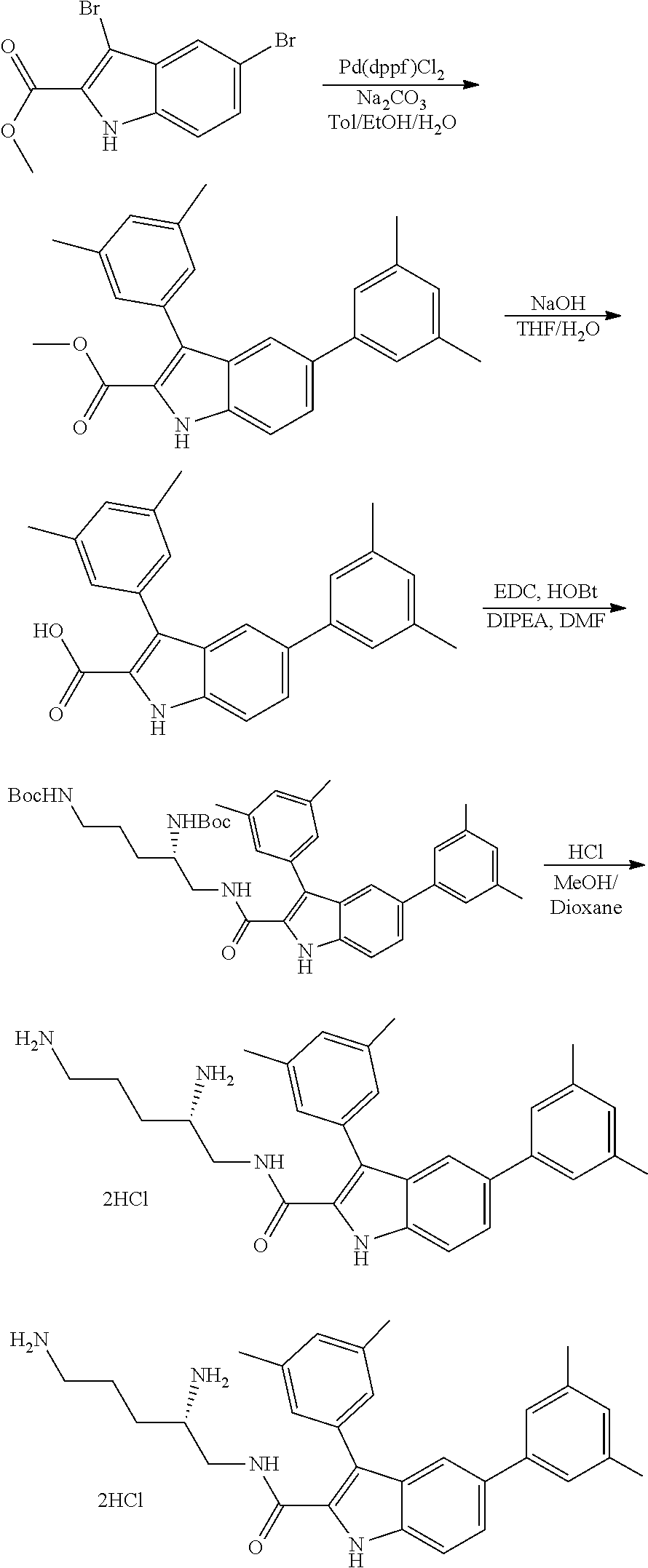

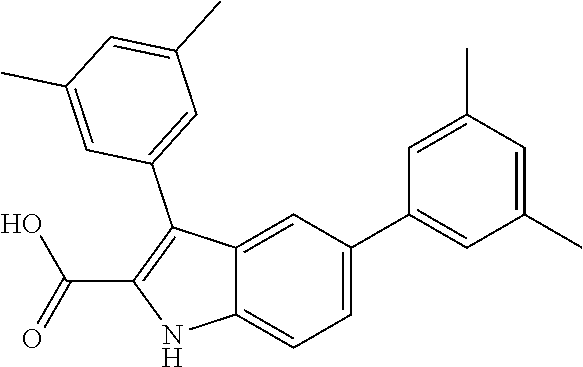



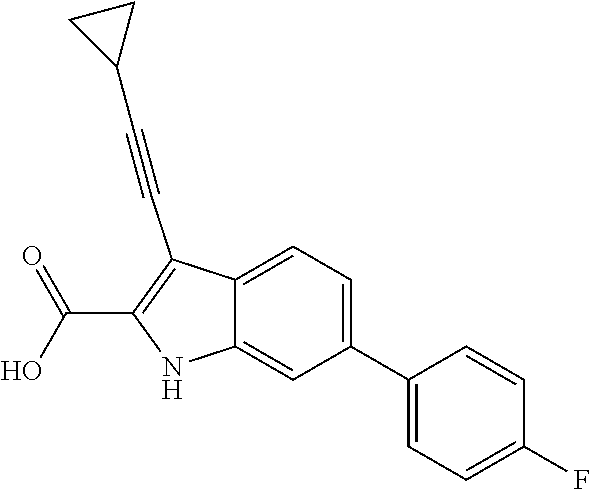
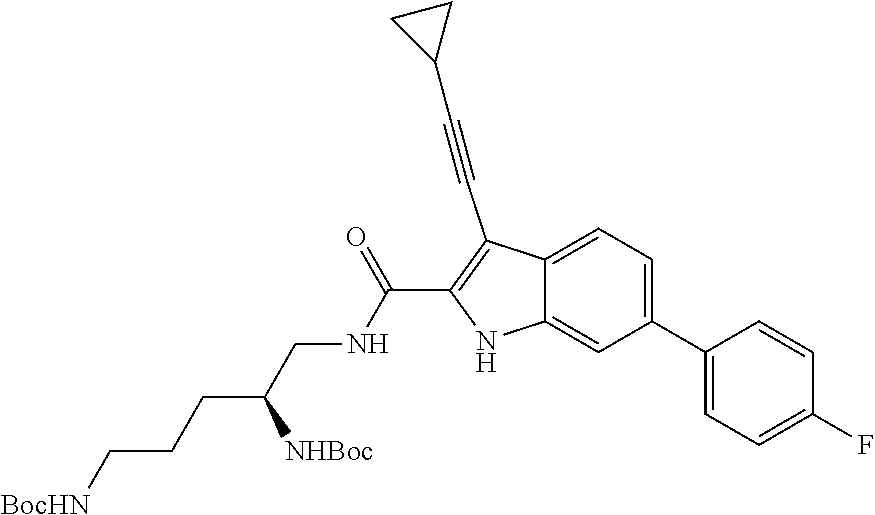
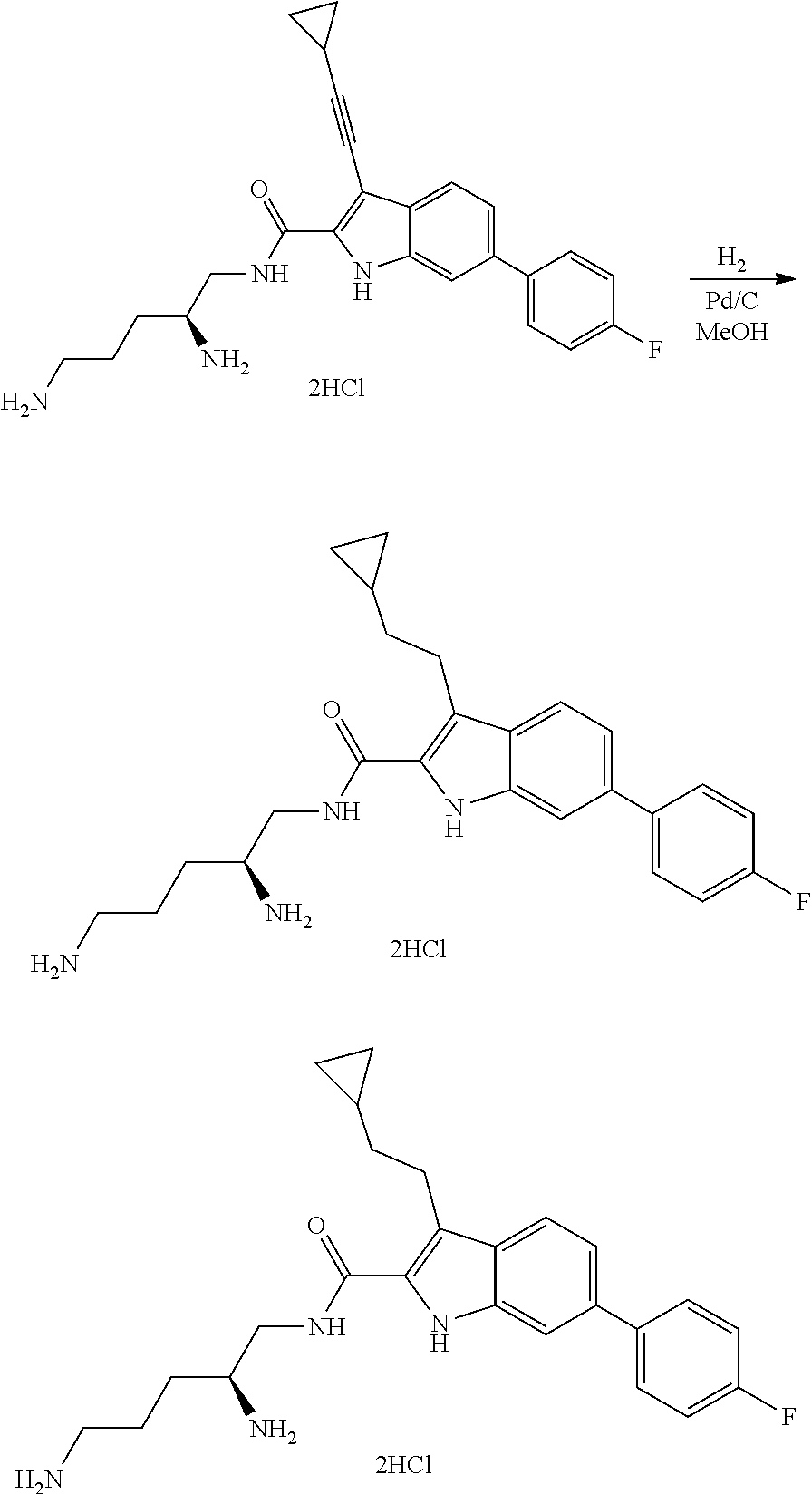

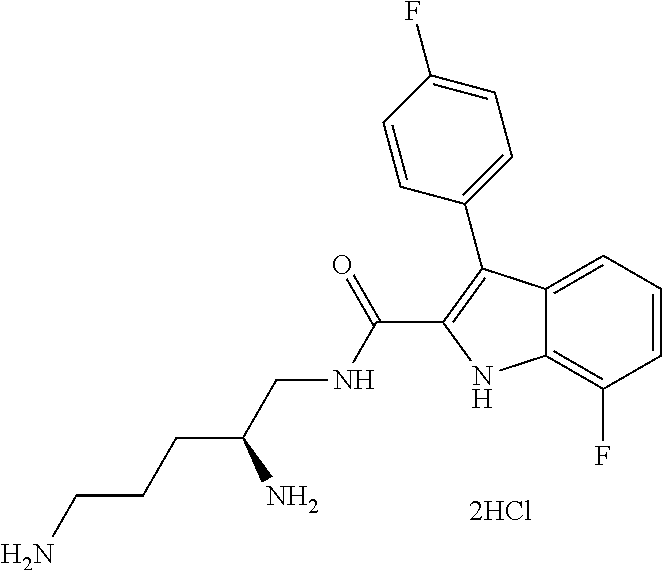
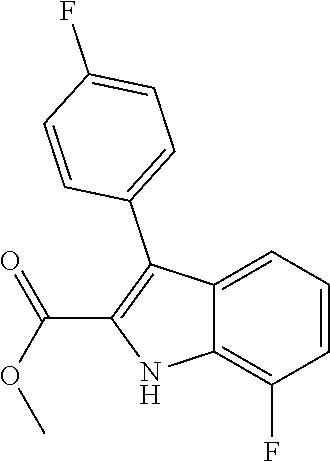
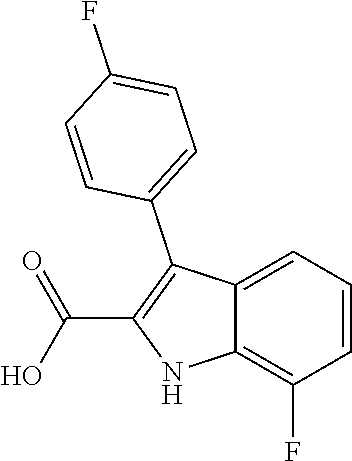
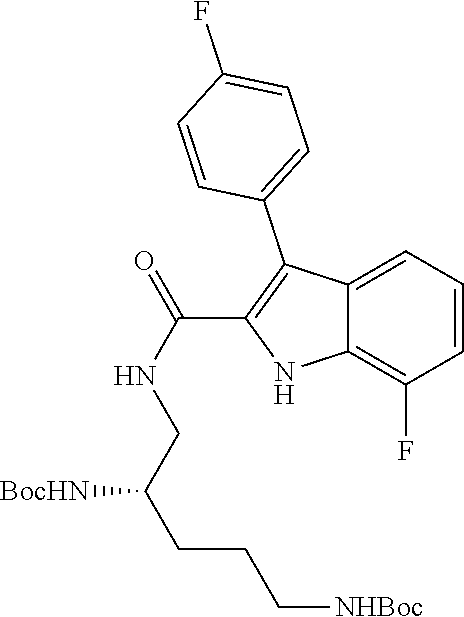
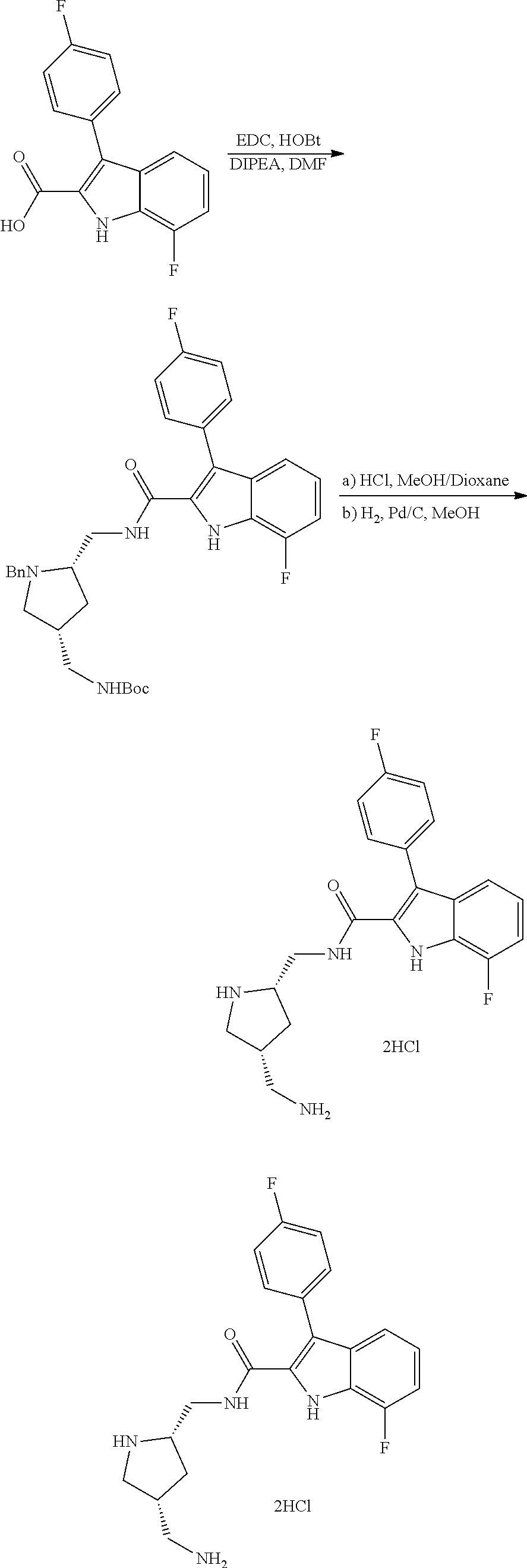



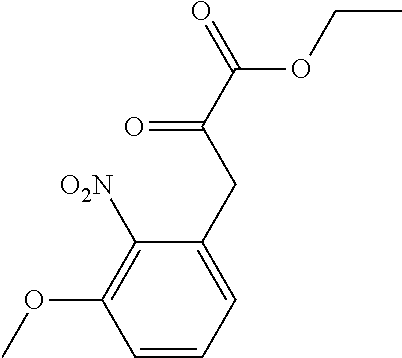


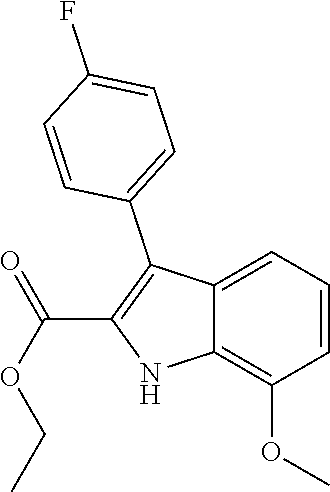

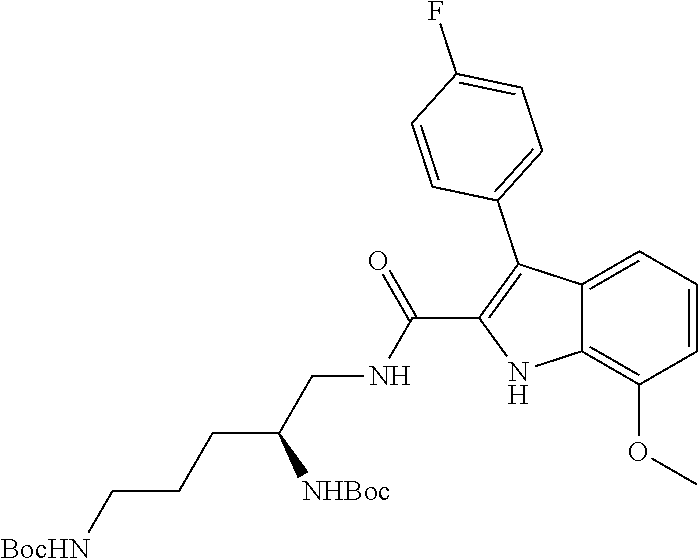

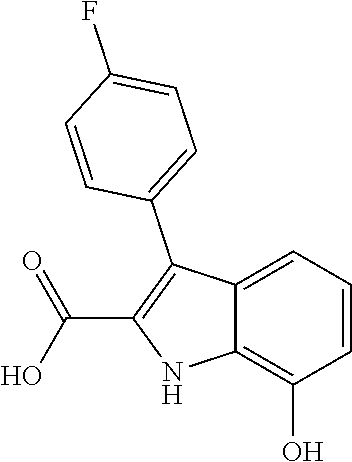
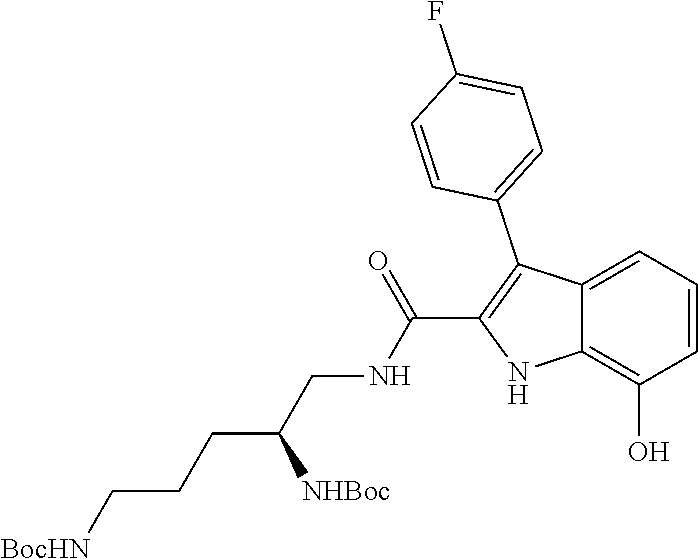
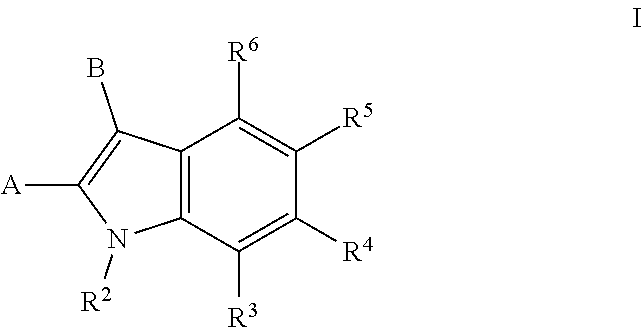
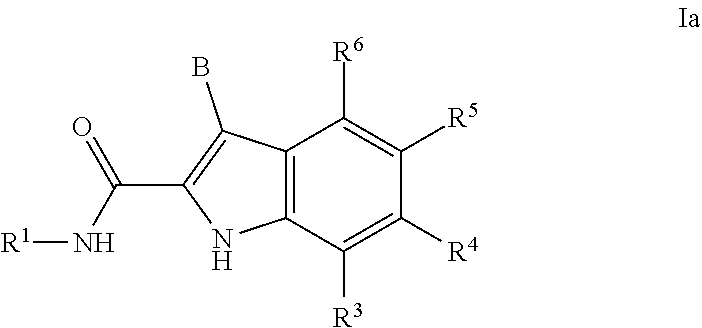












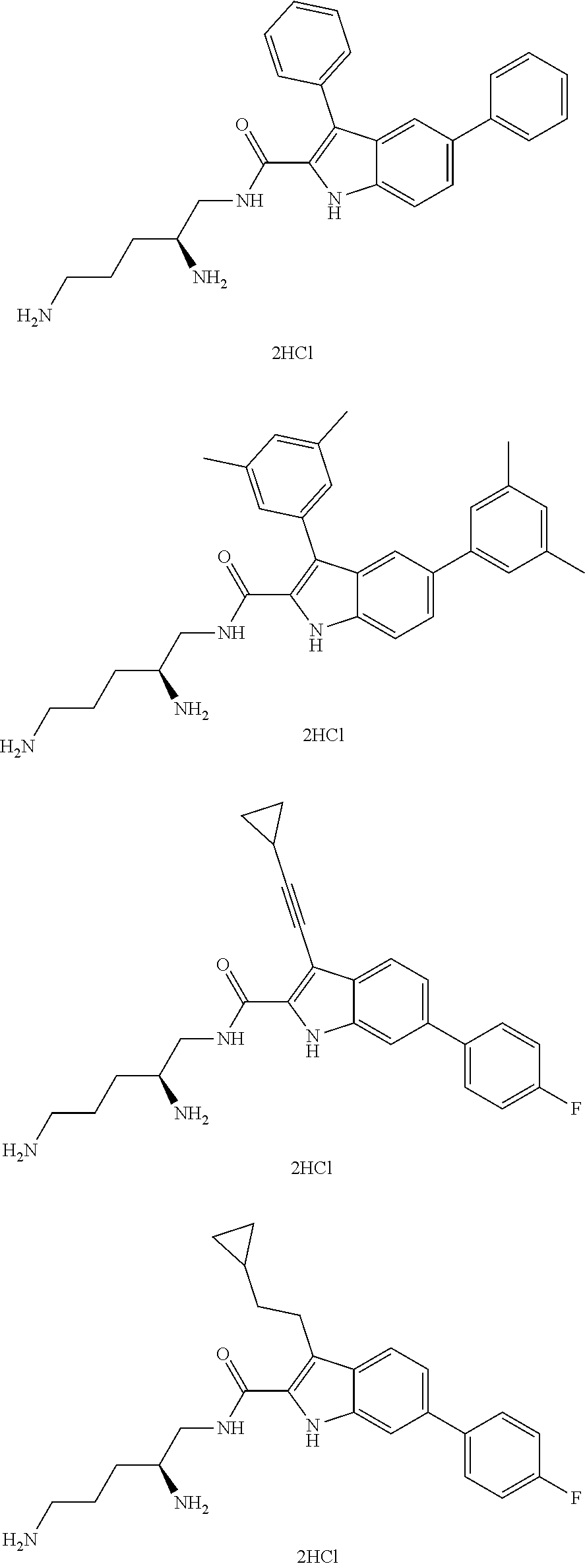

XML
uspto.report is an independent third-party trademark research tool that is not affiliated, endorsed, or sponsored by the United States Patent and Trademark Office (USPTO) or any other governmental organization. The information provided by uspto.report is based on publicly available data at the time of writing and is intended for informational purposes only.
While we strive to provide accurate and up-to-date information, we do not guarantee the accuracy, completeness, reliability, or suitability of the information displayed on this site. The use of this site is at your own risk. Any reliance you place on such information is therefore strictly at your own risk.
All official trademark data, including owner information, should be verified by visiting the official USPTO website at www.uspto.gov. This site is not intended to replace professional legal advice and should not be used as a substitute for consulting with a legal professional who is knowledgeable about trademark law.